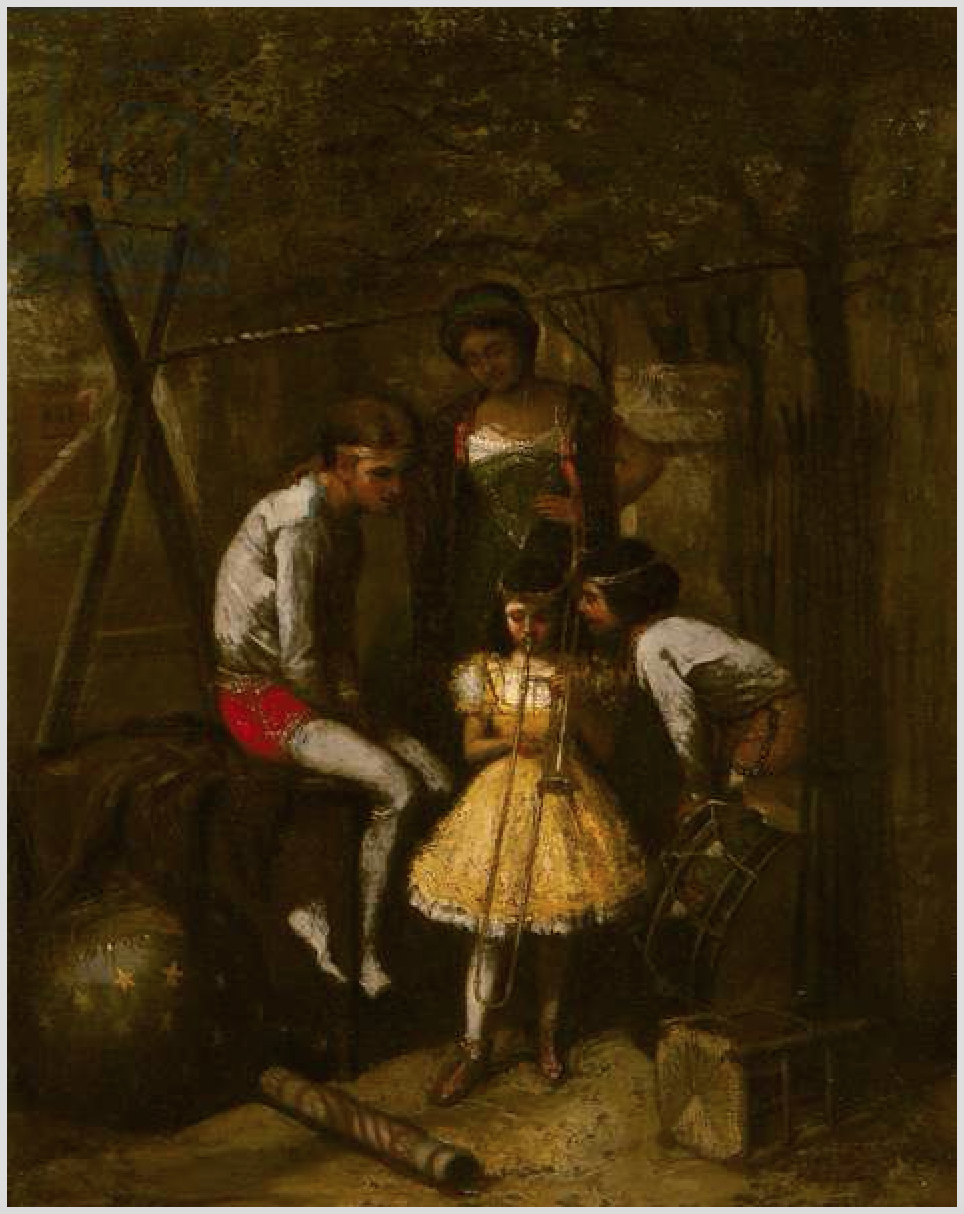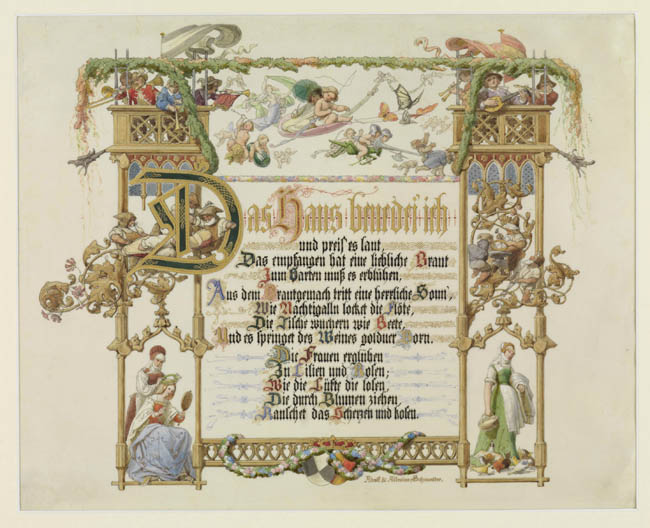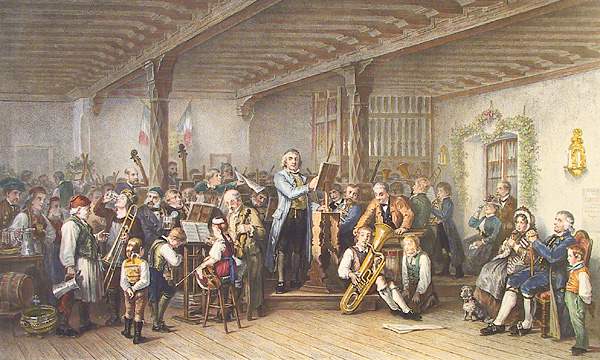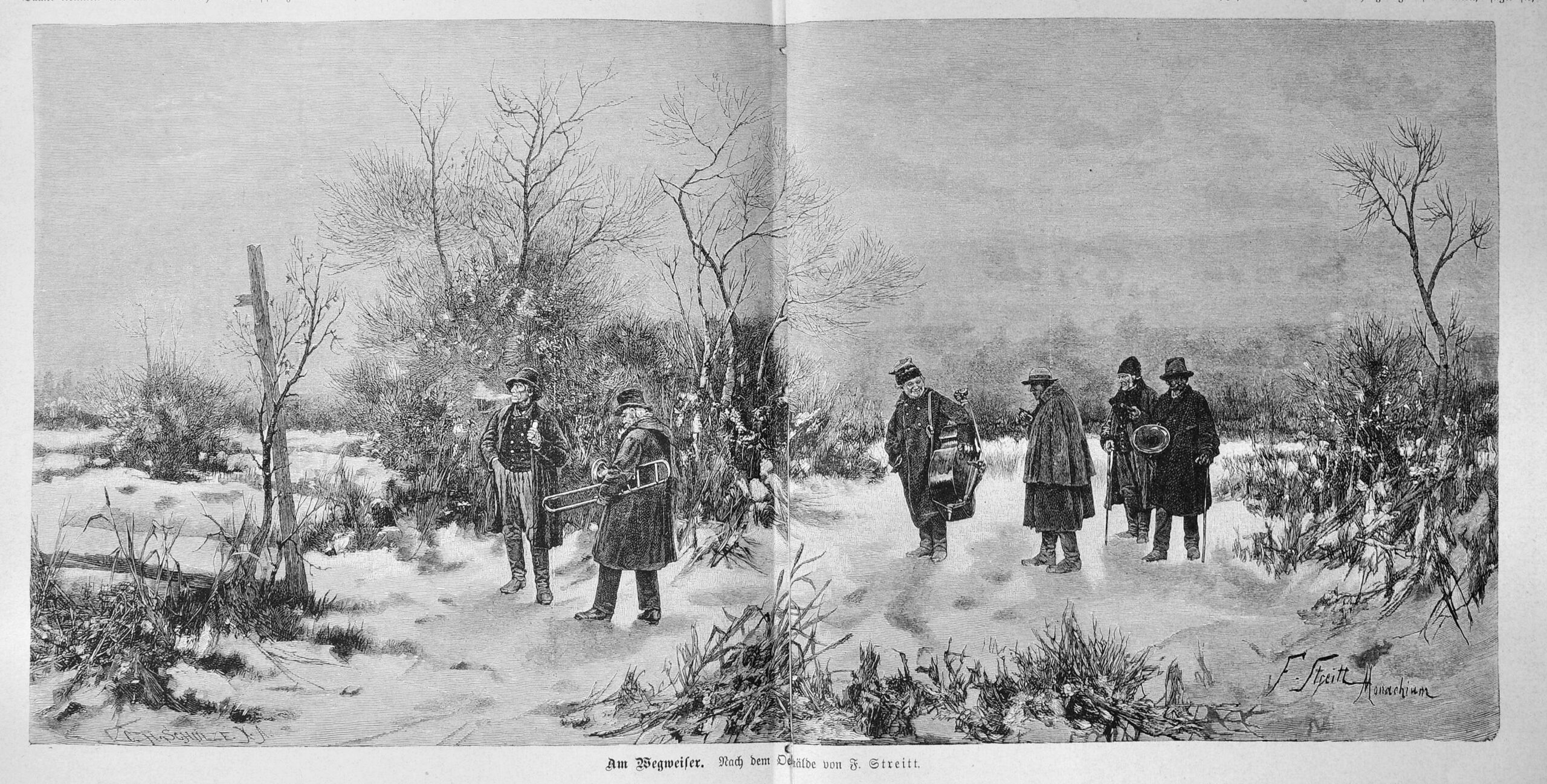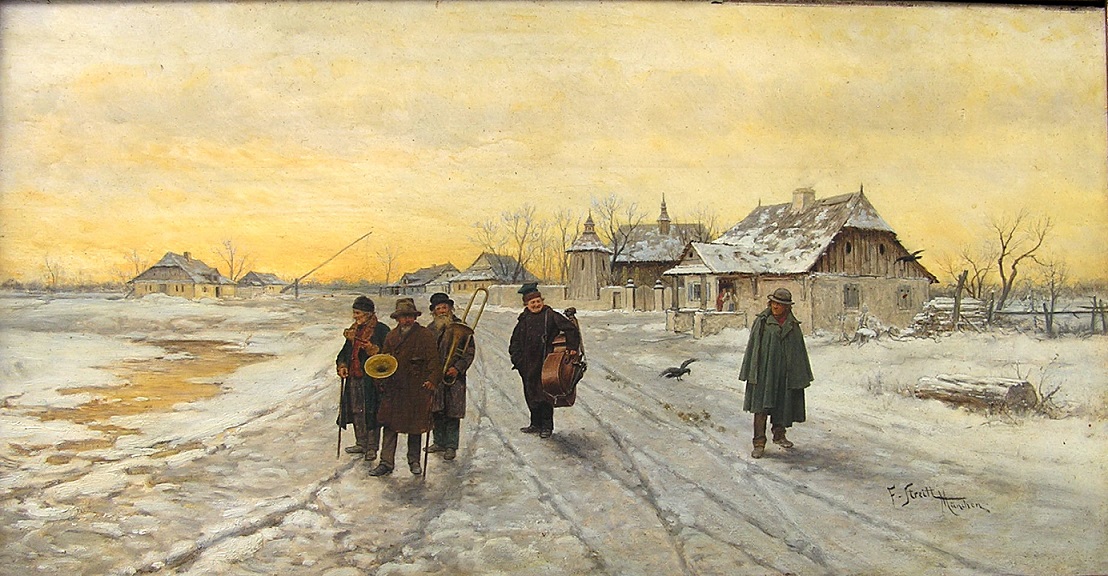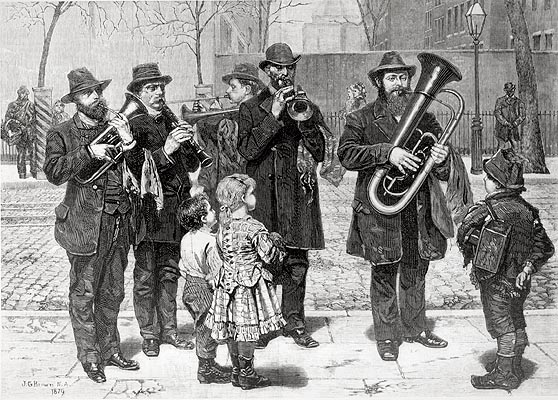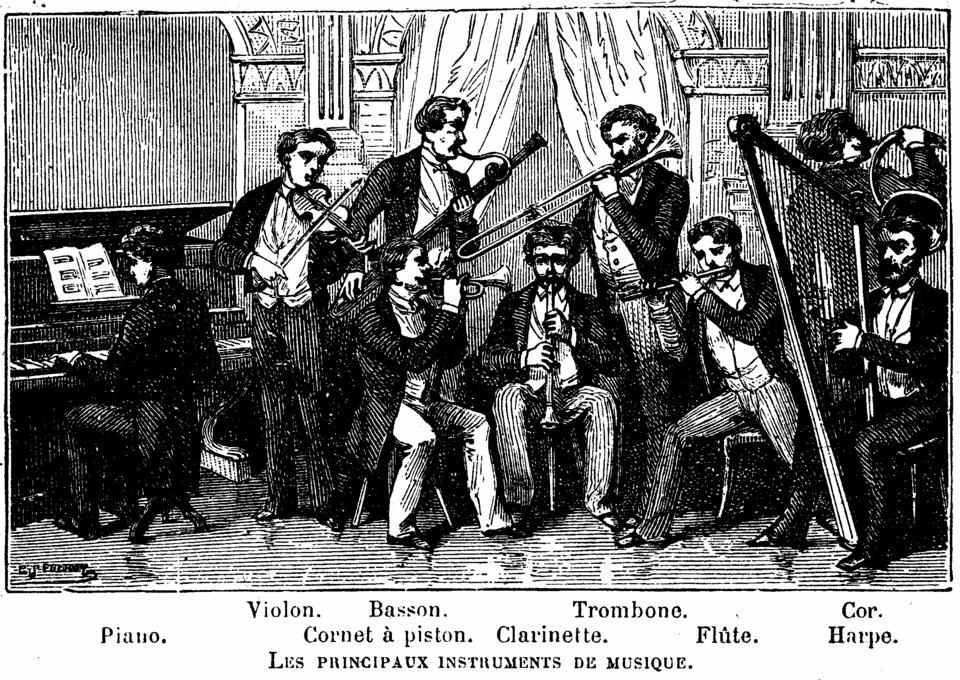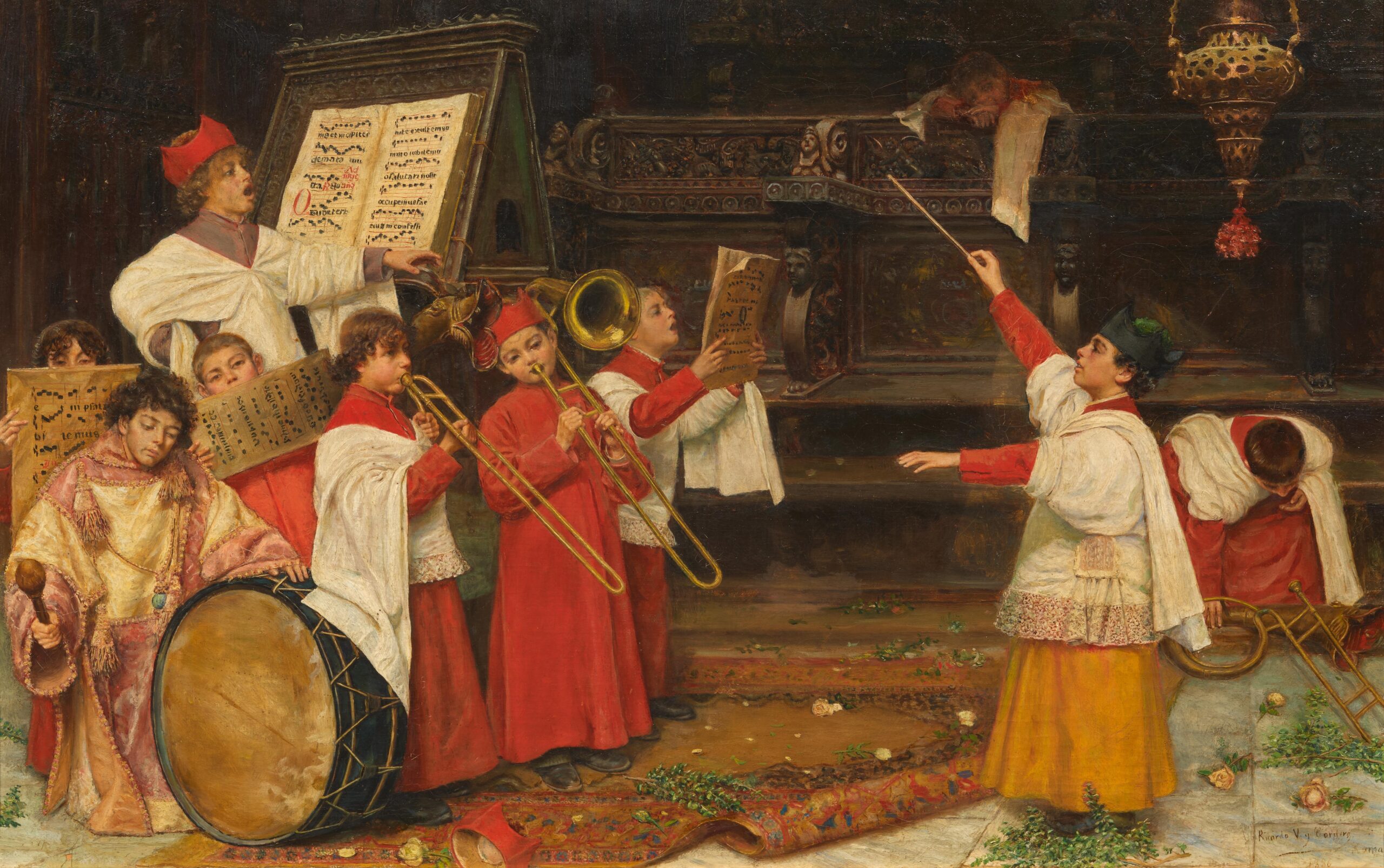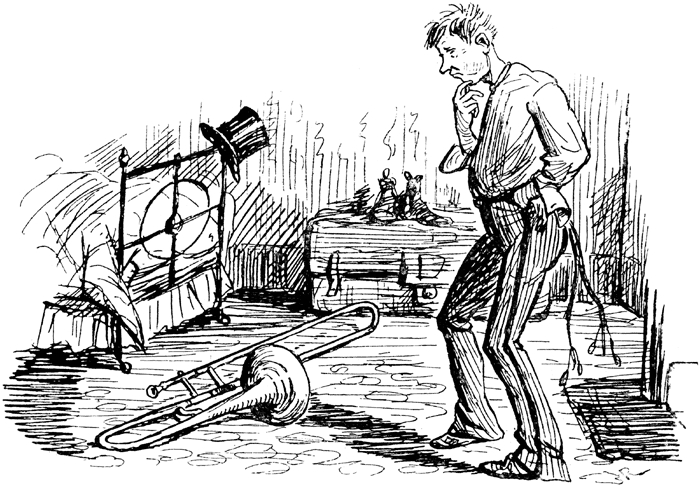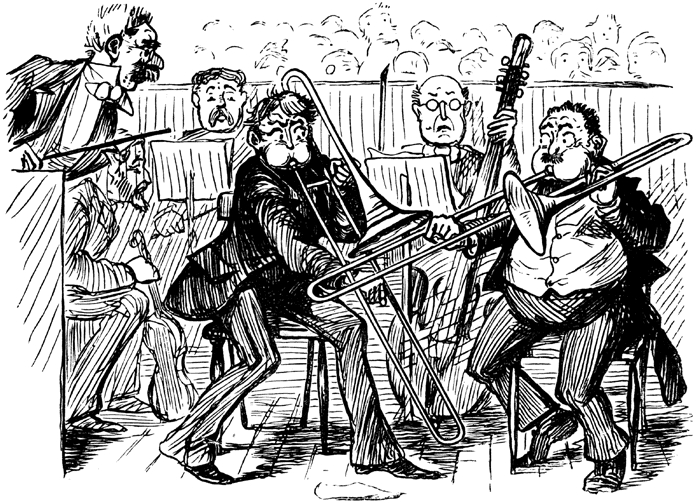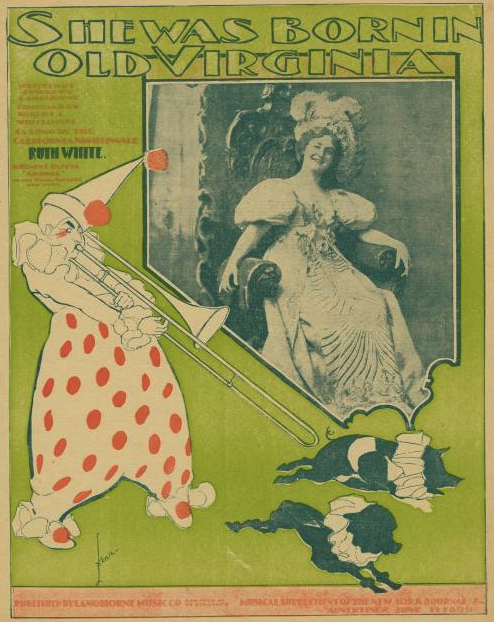A history of the trombone in timeline form. For sources see Trombone History Bibliography.
_______________
1850s—Vienna, Austria: K.K. Ungar: Regiments Feldmusik, a print published by Anton Paterrno, includes both a standard trombone and a rear-facing trombone (see detail and full image below; public domain) (Ryan 419).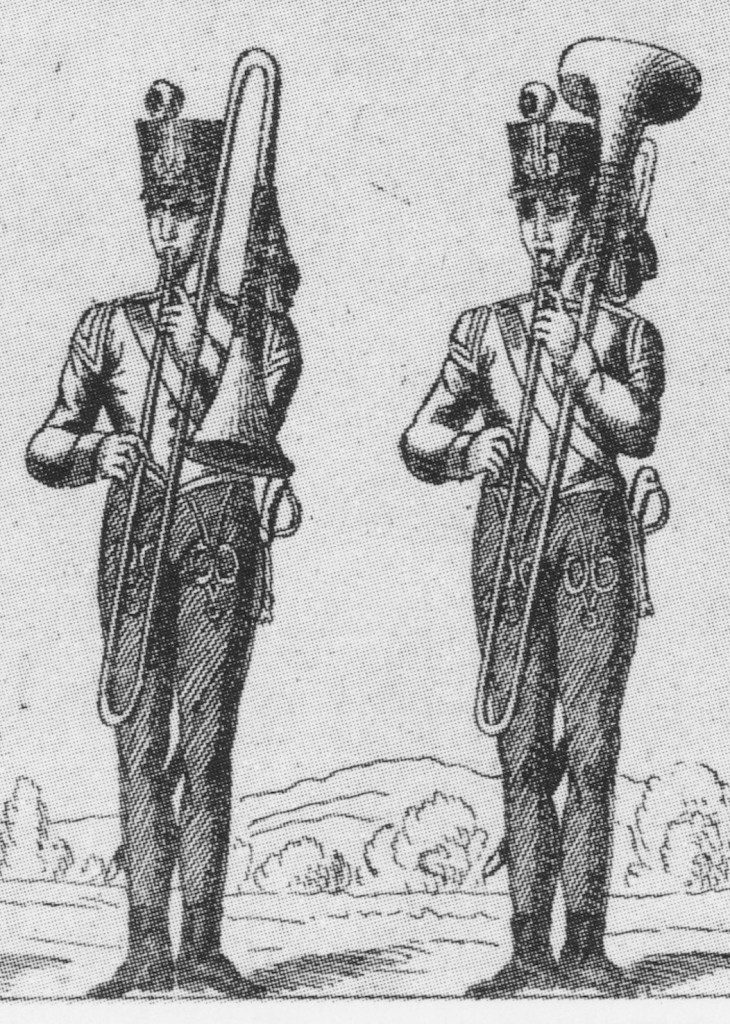
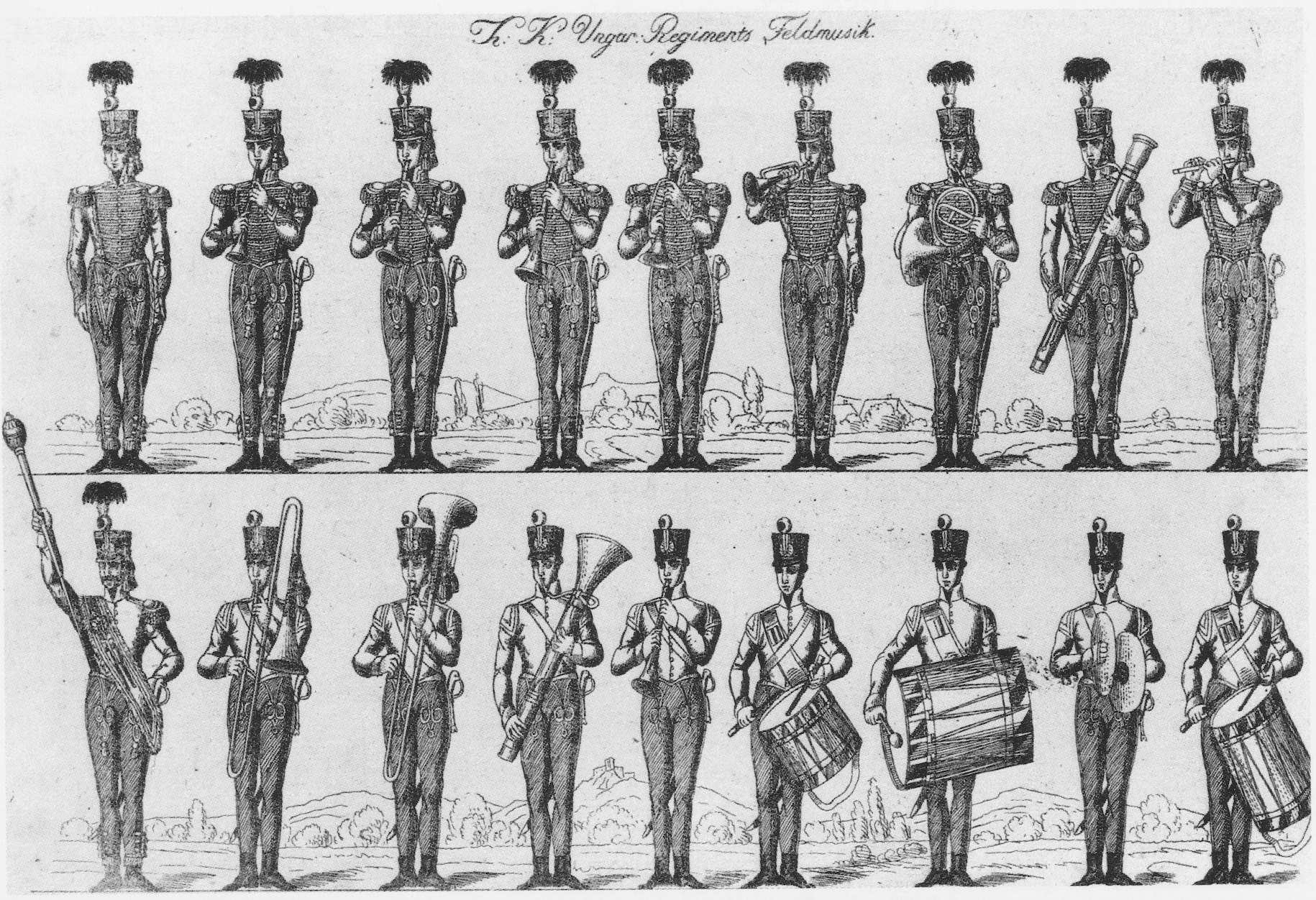
1851—Robert Schumann’s Symphony No. 3, “Rhenish,” utilizes 3 trombones in the 4th and 5th movements, including an important chorale depicting the Cologne Cathedral and various melodic passages.
1851—An illustration of a British infantry band by Ebsworth includes a trombonist (the player in the back facing outward, evidently having lost interest in the proceedings) (see below image; public domain).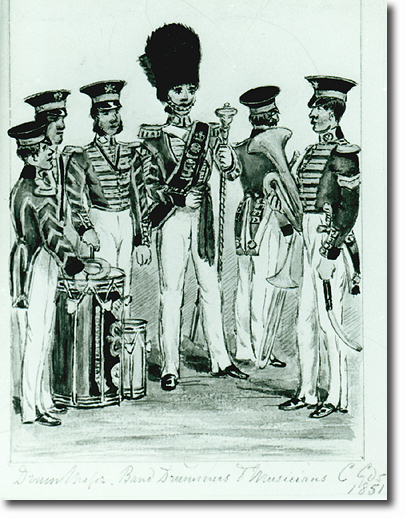
1851—Hector Berlioz praises Weimar trombonist Nabich, saying he could “do anything on it” (Macdonald 227).
1851—Paris Conservatory morceau de concours: Antoine Guillaume Dieppo, Solo.
1851—Leipzig/New York: An engraving by Johann Georg Heck in the Iconographic Encyclopaedia of Science, Literature, and Art features a man playing trombone on horseback in an army of the “modern age,” 15th and 16th centuries. The encyclopedia is based on Bilder Atlas zum Conversations-Lexikon, published in Leipzig, Germany, 1849-51 (see below image; public domain) (Iconographic Encyclopaedia vol. 2, pl. 17, accessed at biodiversitylibrary.org).![]()
1851—London, England: Author Charles Dickens, in his story “Our School,” describes a trombone-playing usher: “He was rather musical, and on some remote quarter-day had bought an old trombone; but a bit of it was lost, and it made the most extraordinary sounds when he sometimes tried to play it of an evening” (Lightwood 45).
1851–Boston, Mass: A woodcut from Gleason’s Pictorial Magazine (August 9, 1851) depicts the Boston Brass Band, which utilizes exclusively over-the-shoulder brass instruments (including trombones; see left side of below image; click picture to expand) (public domain image).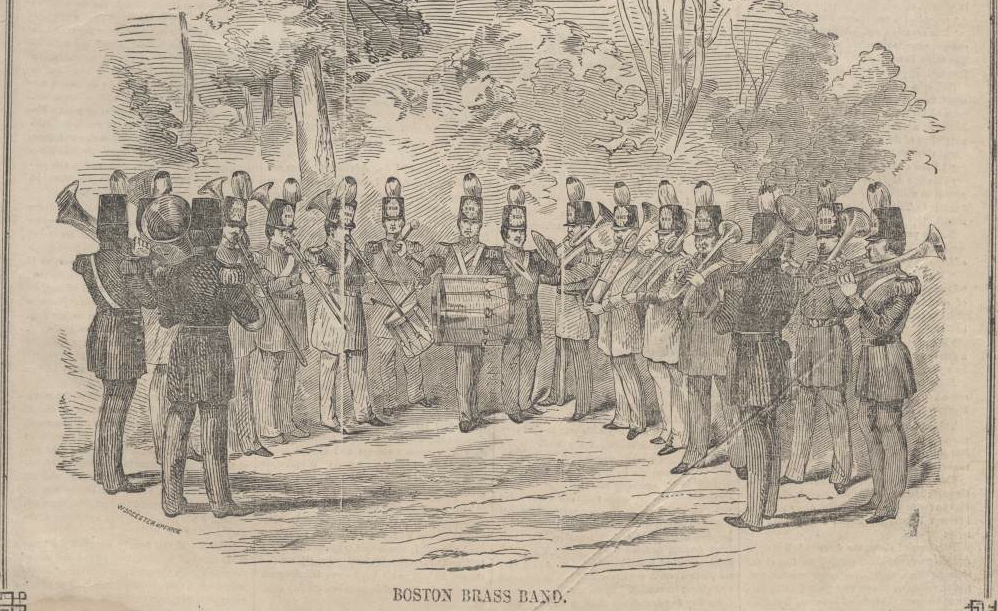
c. 1852—The Goose Eye Band Books, an important early collection of brass band music that includes trombone parts, dates from this time (Herbert, Brass Bands 183).
1852—St. Florian, Austria: Anton Bruckner composes Psalm 116 (114), scored for 5-part choir and 3 trombones (Kinder 10).
1852—London, England: A cartoon from Punch magazine that includes a trombone accompanies the following poem: “What un-fairylike music steals slumber from me? Provoking a sentence that beginneth with D! ’Tis the voice of the trombone, Blown with might and with main, As it mingles its tone With the shrill cornet’s strain. The cabs are all hushed, And the busses at rest: But these sleep-murd’ring wretches The still streets infest. My ears from their torments No night-cap can save: So I groan for the summons To get up and shave” (see below image; public domain) (Punch 1852, p. 267).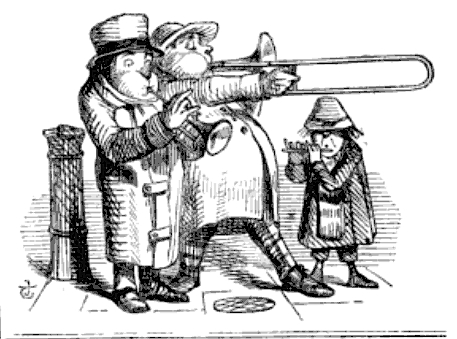
1852—Paris, France: Adolphe Sax invents a trombone with 6 independent valves and 7 separate bells (Carse, Musical 259).
1852—Paris Conservatory morceau de concours: Girard, Concertino.
1852—Düsseldorf, Germany: Robert Schumann writes his Requiem for Chorus and Orchestra, a work he comes to see as his own funeral piece. The work includes 3 trombones (Chase 290).
1852—Paris, France: A print by Janet-Lange entitled The Elections in England includes a rear-facing trombone (see detail below; public domain) (L’Illustration, July 17, 1852, p. 33).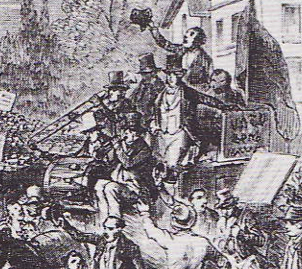
1852—Milwaukee, Wisconsin: Among a number of instruments lost to members of the Milwaukee Musical Society in a fire is a “trombone alto” (Milwaukee Daily Sentinel).
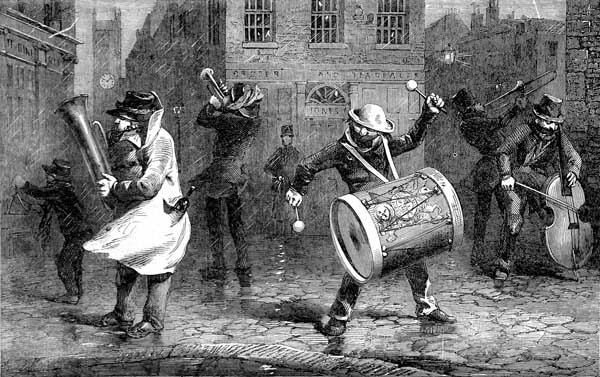 1853—London, England: H.G. Hine’s The Waits at Seven Dials portrays a group of “Christmas waits” or street musicians, including a trombonist. After the Municipal Corporations Act of 1835, there were no more official waits as funded by British municipalities, but ad hoc musicians would often form at Christmas time in hopes of raising money (see above image; public domain) (Illustrated London News, December 1853).
1853—London, England: H.G. Hine’s The Waits at Seven Dials portrays a group of “Christmas waits” or street musicians, including a trombonist. After the Municipal Corporations Act of 1835, there were no more official waits as funded by British municipalities, but ad hoc musicians would often form at Christmas time in hopes of raising money (see above image; public domain) (Illustrated London News, December 1853).
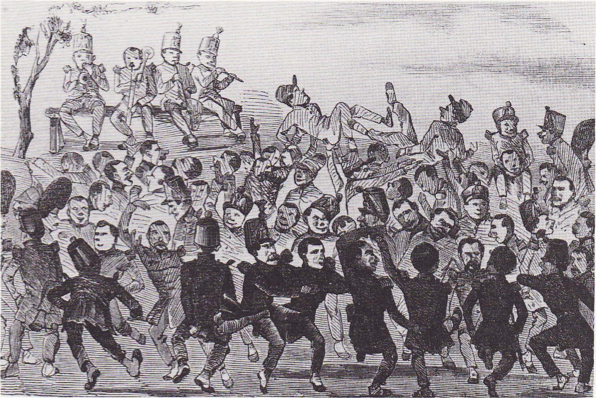 1853—Paris, France: The illustrated newspaper L’Illustration publishes a graphic, “La danse aux camps,” depicting a military celebration with a four-man dance band in the upper-left that includes what appears to be a rear-facing trombone (see facing image; public domain) (L’Illustration, vol. 22, July 23, 1853, p. 64).
1853—Paris, France: The illustrated newspaper L’Illustration publishes a graphic, “La danse aux camps,” depicting a military celebration with a four-man dance band in the upper-left that includes what appears to be a rear-facing trombone (see facing image; public domain) (L’Illustration, vol. 22, July 23, 1853, p. 64).
1853—Paris Conservatory morceau de concours: Belloin, Solo.
1853—Manchester, England: Enderby Jackson, said to have invented the modern brass band contest, collaborates with John Jennison to run a brass band contest at the Belle Vue Zoological Gardens (Herbert, Brass Bands 180).
1853—Robert Schumann’s Allegro and Introduction in D for piano and orchestra uses a single tenor trombone in a long, exposed melody with first trumpet (Wills, Orchestra 162).
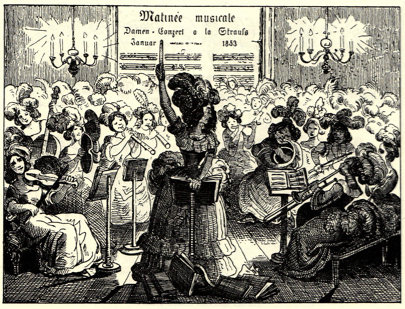 1853—Düsseldorf, Germany: A Düsseldorf magazine publishes an apparently satirical depiction of an all-female orchestra, including a trombonist seated at the front of the ensemble. The picture is labeled, “Damen-Conzert a la Strauss” (see facing image; public domain) (Düsseldorfer Monatshefte; Worbs 148).
1853—Düsseldorf, Germany: A Düsseldorf magazine publishes an apparently satirical depiction of an all-female orchestra, including a trombonist seated at the front of the ensemble. The picture is labeled, “Damen-Conzert a la Strauss” (see facing image; public domain) (Düsseldorfer Monatshefte; Worbs 148).
1854—St. Florian, Austria: Anton Bruckner writes Vor Arneths Grab, WAB 53, which is scored for male chorus and 3 trombones, for the funeral of Prelate Michael Arneth (Kinder 23).
1854—Anton Bruckner’s Libera is scored for 5 voices, 3 trombones, and organ (Rasmussen, A Bibliography of Choral Music).
1854—Paris, France: A drawing published in the French periodical, L’Illustration, features a trombonist-panhandler. The caption reads, “This poor dog moves the heart of my cousin. I cannot give less than a dollar” (see below image; public domain) (L’Illustration, Vol. 24, September 9, 1854, p. 172).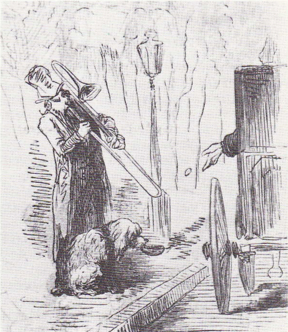
1854—Paris Conservatory morceau de concours: Antoine Guillaume Dieppo, Solo.
c. 1855—Artist Albert Kindler includes a trombonist in his painting After the Wedding. The trombonist stands in the musicians’ boat in the background (see below image; public domain).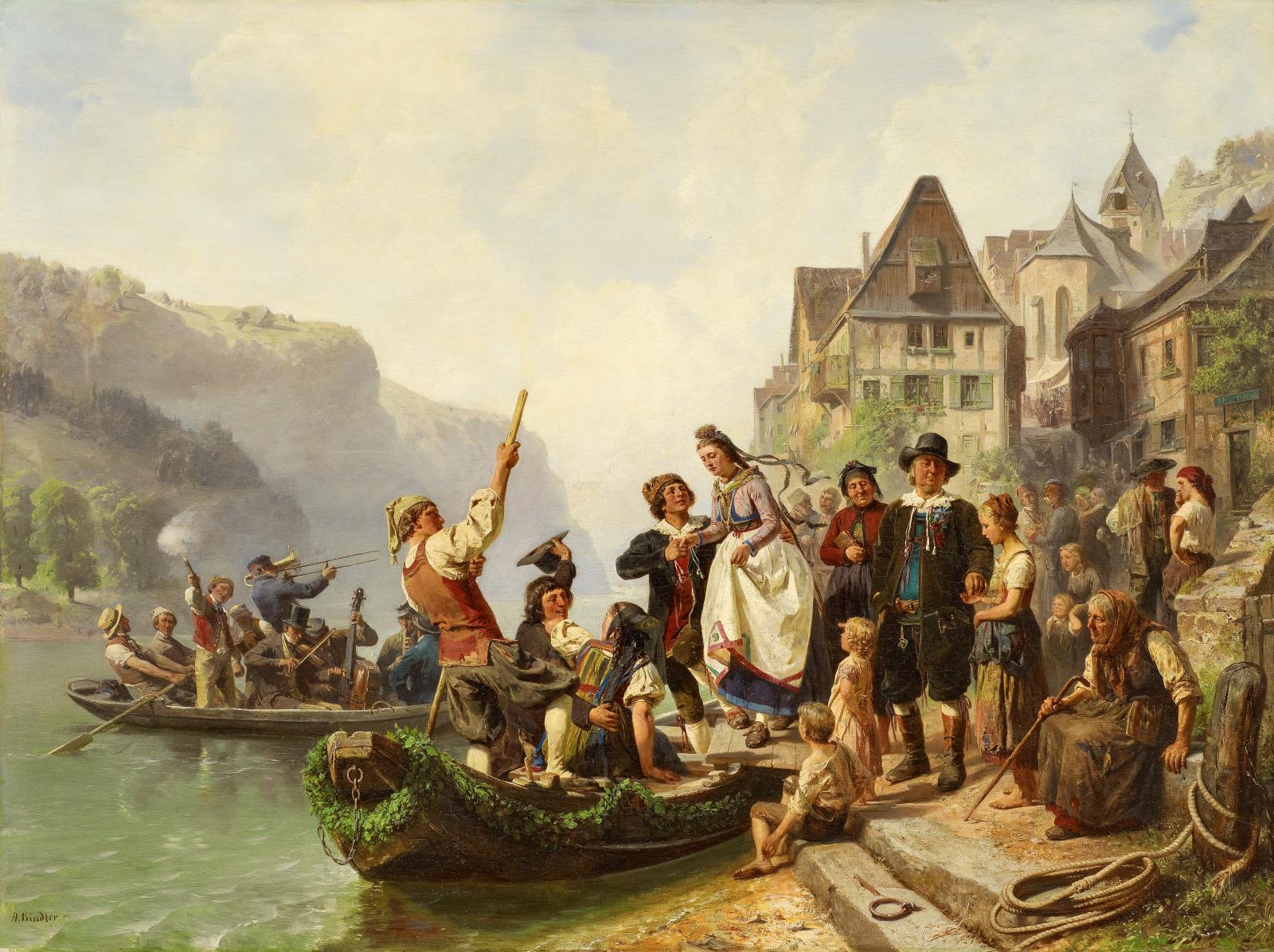
c. 1855—South Wales: A photograph of the Cyfarthfa Band, a private brass band considered one of the greatest of the 19th century, shows an ensemble of 21 brass and percussion players, including 4 trombones. G.C. Bawden, one of the trombonists with the group, is also a cellist, violinist, and conductor of the Cyfarthfa String Band (Herbert, Cyfarthfa).
1855—Hector Berlioz, Te Deum, calls for 6 trombones (3 doubled parts).
1855—Von Gontershausen observes that the best German trombonists are abandoning their valve trombones, preferring instead the traditional slide instrument (Carse, Musical 259).
1855—England: The Band of George IV is headquartered at the Pavilion at Brighton. It includes 6 trombones: an alto, a tenor, and 4 basses (Carse, The Prince Regent’s Band).
1855—France: Le Lendemain de la Saint Sébastien, a painting by Jules Adolphe Breton, features a group of musicians that includes a woman playing trombone (see below image; public domain).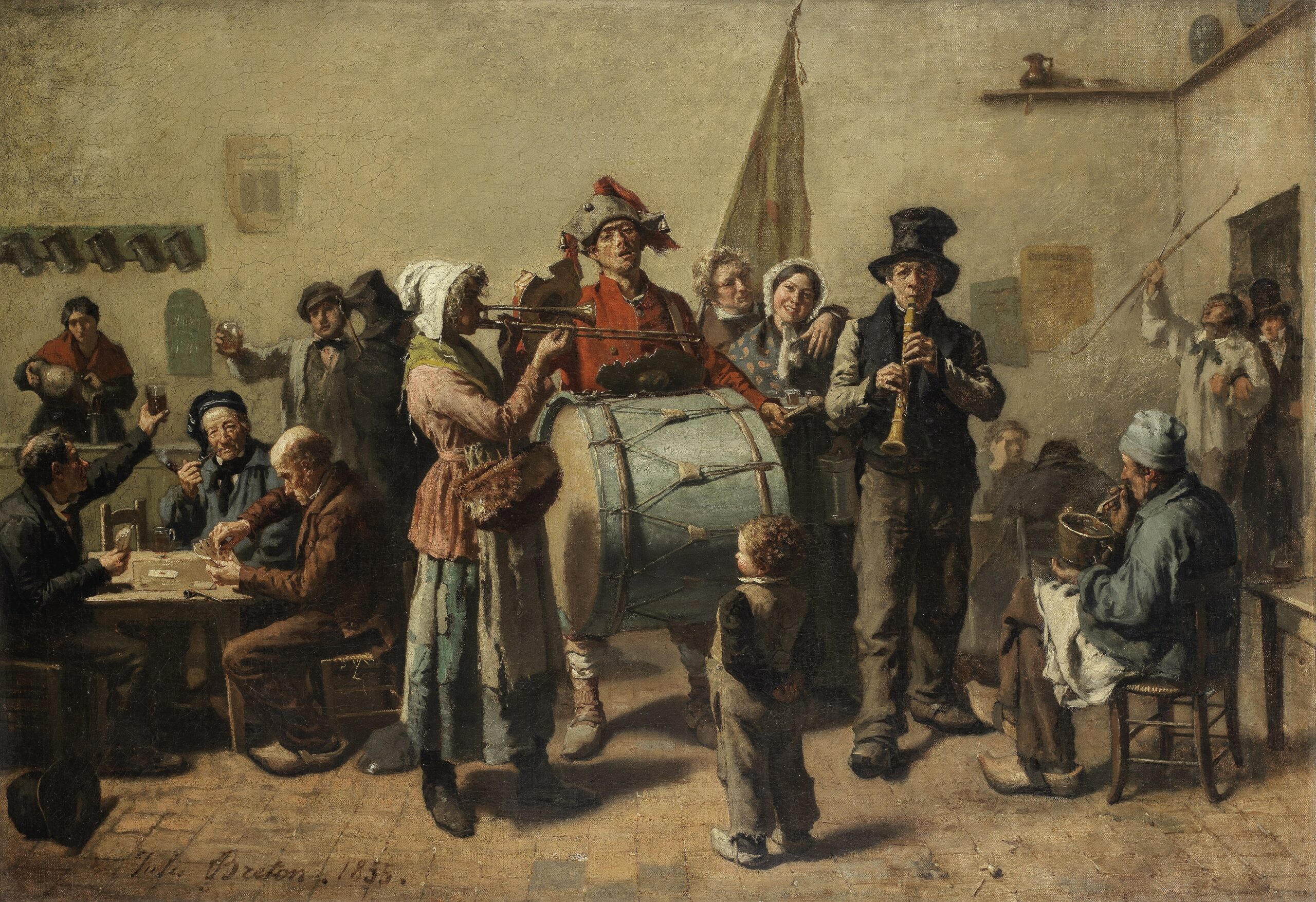
1855—Paris Conservatory morceau de concours: Charles Gounod, Solo.
1855—An important collection of early music from the Black Dyke Mills Band, including parts for trombones, dates from this year (Herbert, Brass Bands 183).
1855—Paris, France: Dieppo, Simon, and Dantonnet are trombonists in the Paris Opéra orchestra (Carse, Orchestra 494).
1855—Franz von Suppé, famous for his German operettas, writes his Requiem in D Minor for his deceased friend, Franz Pokorny. Von Suppé utilizes 3 trombones prominently for the dramatic choral recitative, “Domine Jesu Christe,” as well as for an introduction and postlude in the “Tuba mirum” (Chase 298).
1855—New York, New York: An illustration by Theodore Benecke titled Sleighing in New York includes a portrayal of a band performing from the balcony of Barnum’s Museum. The trombonist is playing a rear-facing trombone (see below detail; public domain) (New York Public Library, Eno Collection of City Views; Bowles, Timpani 295).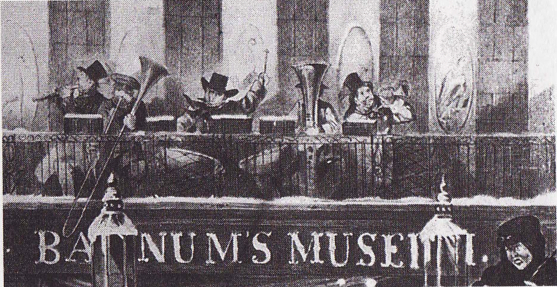
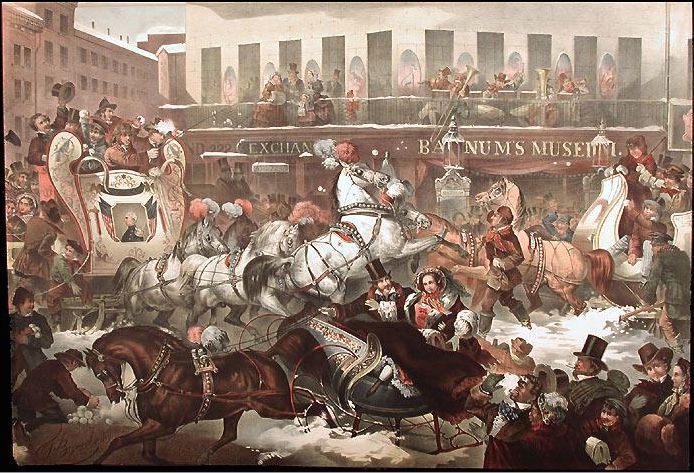
1856—Germany: Theodor Hosemann’s watercolor, Kleine Blaskapelle, features a trio of brass musicians and a couple of curious onlookers (see below image; public domain).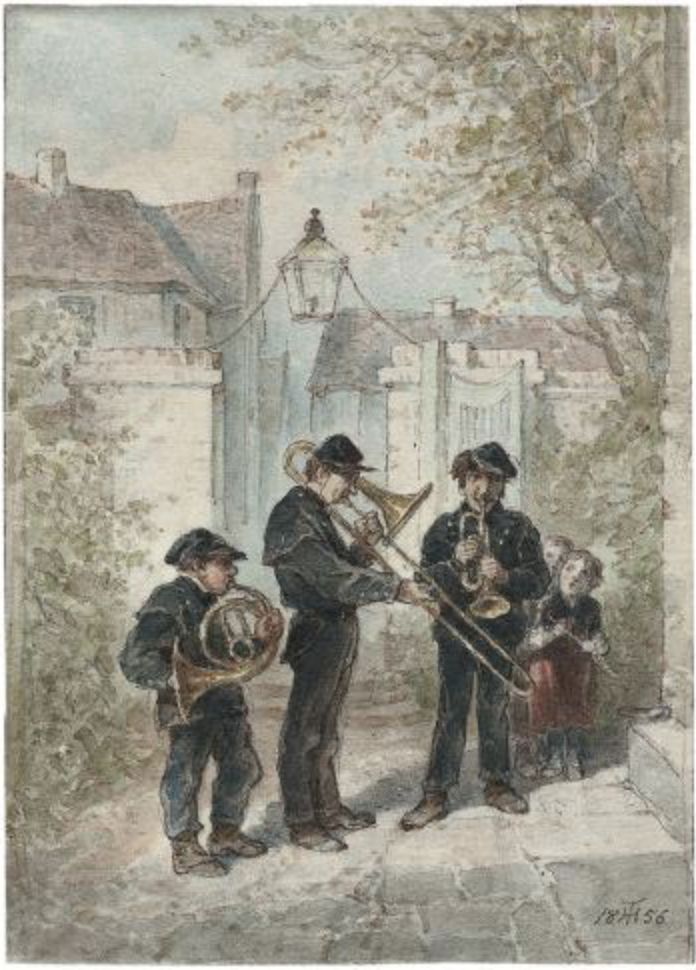
1856—Düsseldorf, Germany: Bridal Song, a watercolor and pencil image by Adolph and Alwine Schroedter, includes what appears to be a rear-facing trombone (see detail and full image below; public domain) (Museum Karlsruhe).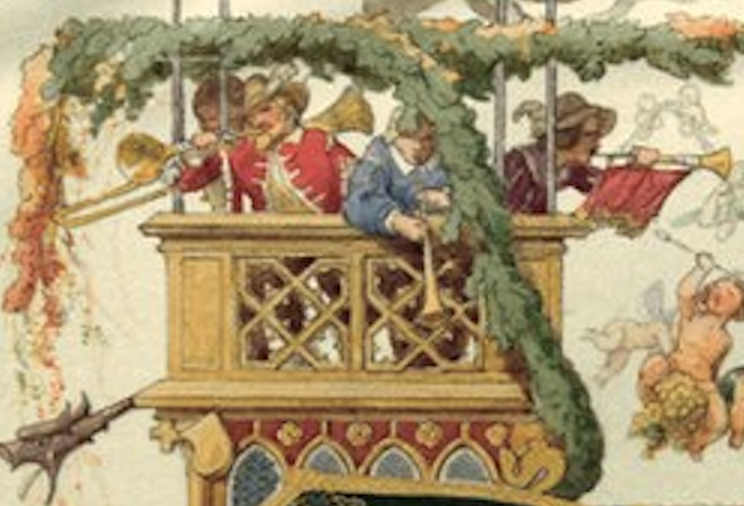
1856—Paris Conservatory morceau de concours: François Théodore Labarre, Solo.
1856-1900—The Netherlands: The publisher Glenisson and Sons publishes a print of military musicians that includes 2 rear-facing trombones (see below detail; public domain) (Catchpenny Prints of Royal Dutch Library).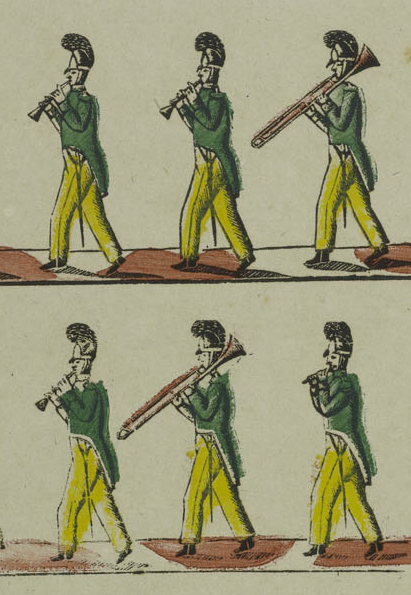
1857—Paris Conservatory morceau de concours: Henri Hippolyte Potier, Solo.
1857—A celebrated horn player by the name of J. Meifred develops the modern concept of tuning slides on brass instruments (Bate 182).
1858—Gustav Besson designs a valve trombone with 3 pistons dependants and a register (fourth valve), made in the shape of a tuba (Carse, Musical 259).
1858—London, England: An illustration of the band of the French National Guard published in London’s Illustrated Times includes trombone (see below image; public domain).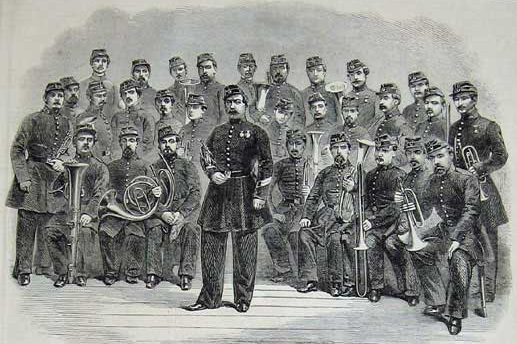
1858—Paris Conservatory morceau de concours: Charles Gounod, Concerto.
1859—Hamburg, Germany: Johannes Brahms, discussing instrumentation in a letter to Theodor Avé Lallemant, insists, “On no account 3 tenor trombones! One genuine little alto trombone and, if possible, also a genuine bass trombone” (“Daß keine 3 Tenor Posaunen kommen! Eine ächte kleine Alt-Pos. u. wo möglich auch eine ächte Bass-Pos.”) (Avins 127). For similar wording by another composer of the era, see Berlioz’s note about a “true alto trombone” for Symphony Fantastique, above (1830).
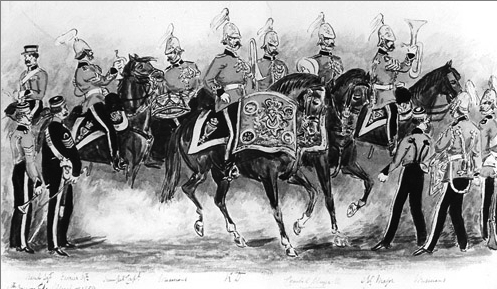 1859—A sketch by Aldershot of musicians of the 4th Royal Irish Dragoon Guards, a cavalry regiment in the British Army, shows a trombonist among a number of military musicians riding on horseback (see upper-middle of facing image; public domain).
1859—A sketch by Aldershot of musicians of the 4th Royal Irish Dragoon Guards, a cavalry regiment in the British Army, shows a trombonist among a number of military musicians riding on horseback (see upper-middle of facing image; public domain).
1859—Gounod’s opera, Faust, uses 3 trombones in orchestra, plus 2 e-flat altos and 1 tenor in a military band that appears on stage in 4th act.
1859—Paris Conservatory morceau de concours: Antoine Guillaume Dieppo, Solo.
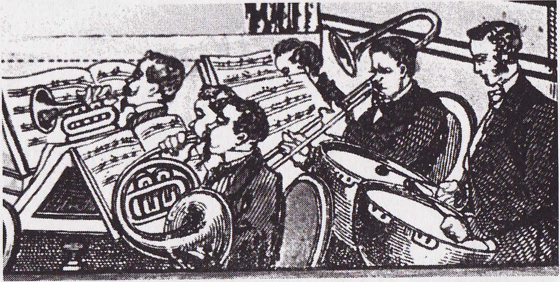 c. 1860—Epinal, France: Tresor de l’imagerie Pelerin, a toy theater stage set, includes a depiction of a French pit orchestra that features a trombone prominently (see facing detail; public domain) (Bowles, Timpani 295; photo by Todd Weinstein).
c. 1860—Epinal, France: Tresor de l’imagerie Pelerin, a toy theater stage set, includes a depiction of a French pit orchestra that features a trombone prominently (see facing detail; public domain) (Bowles, Timpani 295; photo by Todd Weinstein).
c. 1860—Friedebald Gräfe, Concerto.
c. 1860—Merthyr Tydfil, Wales: The “B Series” part books of the famous Cyfarthfa Band include “Alto trombone,” “First Tenor Trombone,” “Second Tenor Trombone,” and “Bass Trombone” (Herbert, Cyfarthfa; Dudgeon, Keyed Bugle 32).
c. 1860—Michigan, United States: A portrait painting on a cabinet card shows a valve trombone player (see below image; public domain) (special thanks to Tassos Dimitriadis and Mogens Andresen).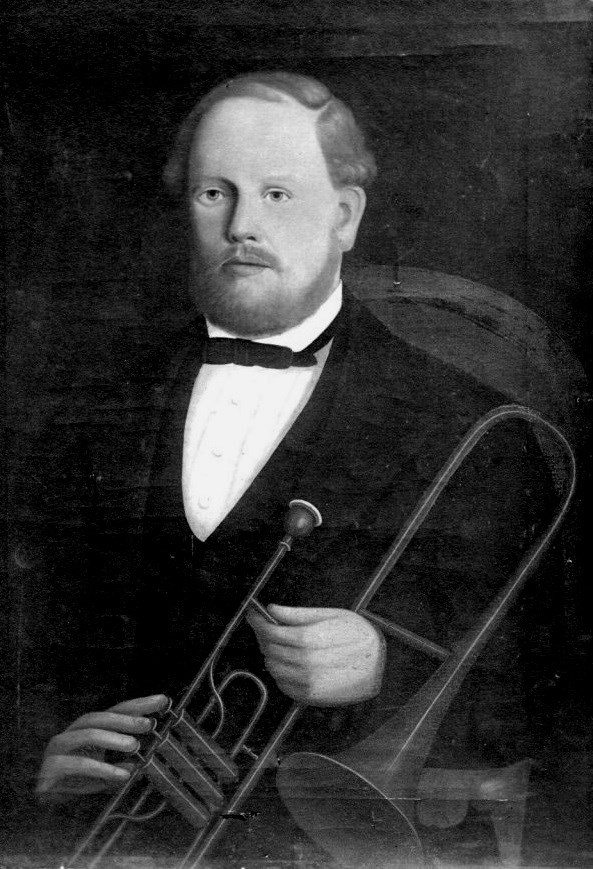
c. 1860—Peru: Artist Pancho Fierro depicts a trombonist performing with a wind band for a Peruvian wedding celebration in Fiesta de Matrimonio (see detail and full image below; public domain) (Lavalle 38).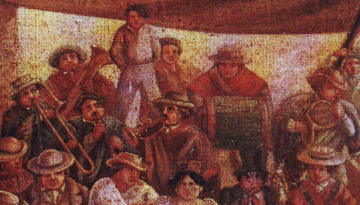
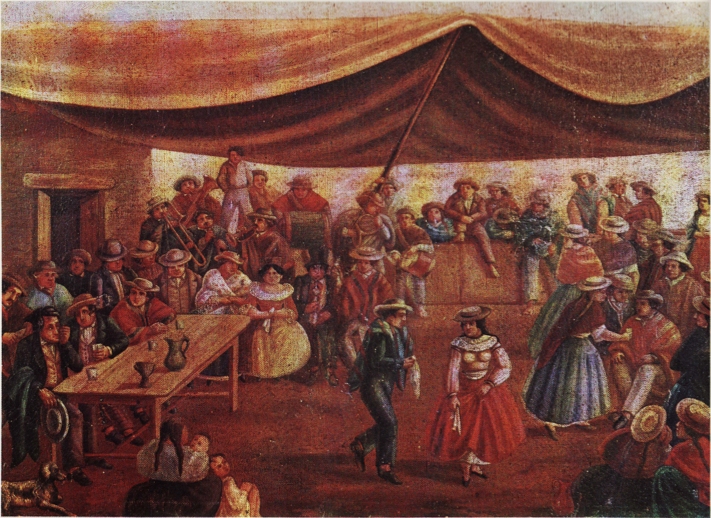
1860—Paris Conservatory morceau de concours: Antoine Guillaume Dieppo, Solo.
1860—New York: Italian-born trombonist Carlo Alberto Cappa joins the Seventh Regiment Band. He becomes conductor of the group in 1881 and performs as soloist with the band regularly until his death in 1893. One of the most influential American trombonists of his era, he also plays first trombone in the Theodore Thomas orchestra for 7 years, soloing multiple times with that group while in the position. He also plays with the Philharmonic in New York and Brooklyn for 5 years and Mapleson’s orchestra for 3 years (Guion, Four American).
1860—Berlin, Germany: Theodor Hosemann’s lithograph, “Harzer Musikanten,” an illustration for the book, 52 Sonntage oder Tagebuch dreier Kinder, includes a trombonist playing with a small wind ensemble for a country dance (see below image; public domain).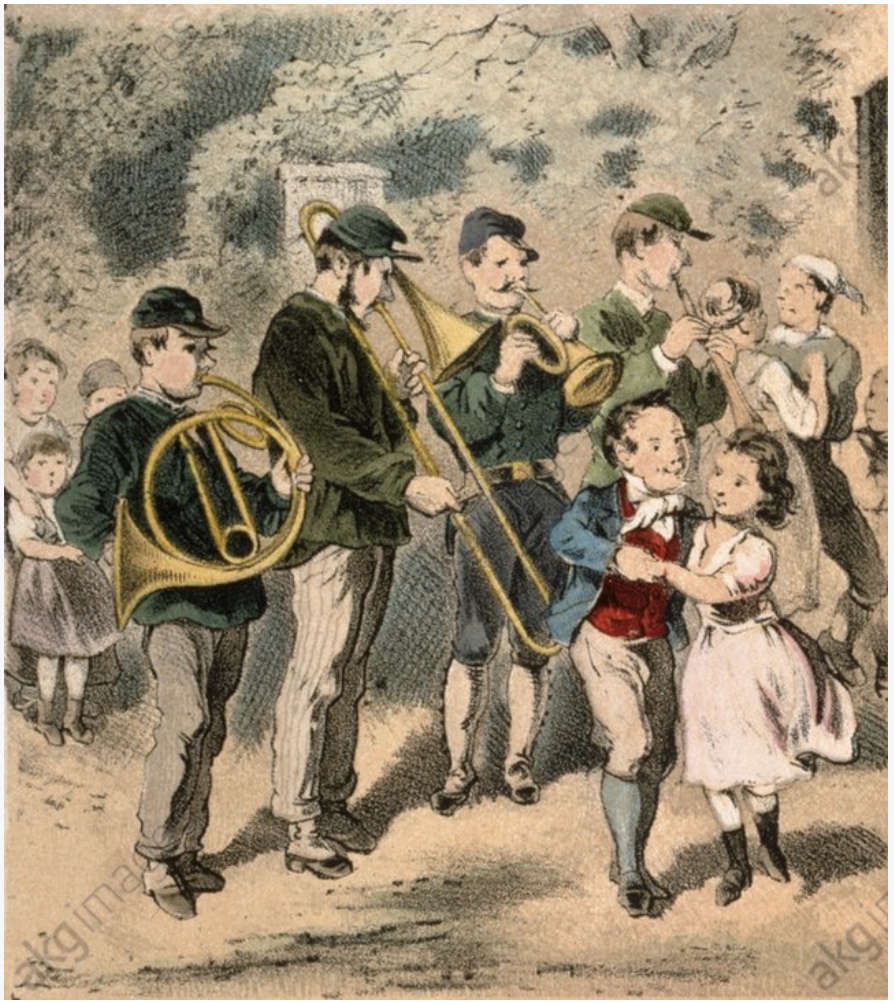
1860—A drawing for the cover of the piano-vocal score for Jacques Offenbach’s operetta, Les deux aveugles, features a man holding a rear-facing trombone, with a similar trombone along the border nearby (see below image; public domain) (source: Wikimedia commons).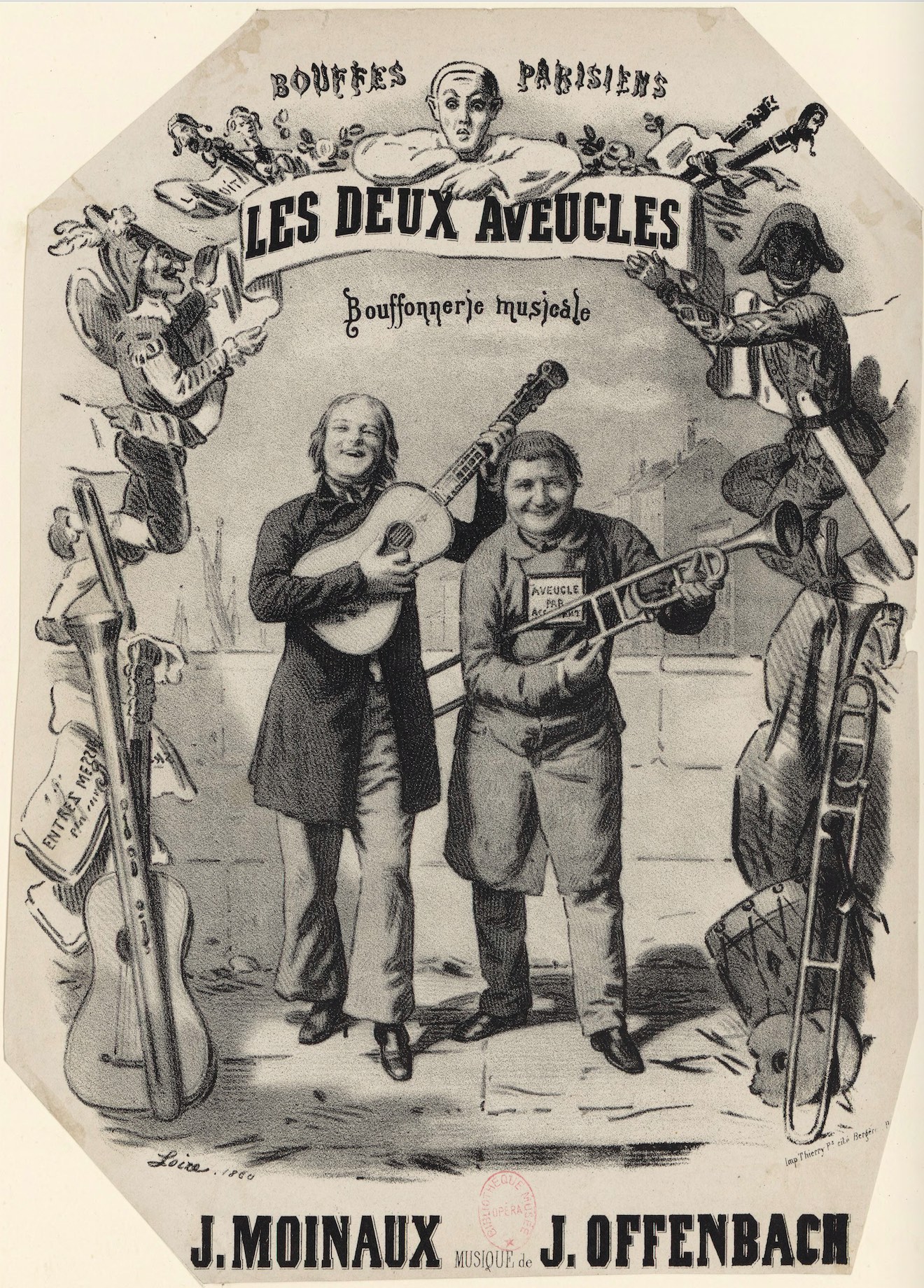
1860—Florence, Italy: Giovacchino Bimboni (1810-1895) is appointed professor of trumpet and trombone at the Cherubini Conservatory. He later writes a valve trombone method, Metodo per trombone a piston, between 1880 and 1889. Bimboni also invents a valve trombone called a Bimbonifono in which a separate rotary valve is used for each of the seven slide positions in an attempt to avoid the tuning problems of other valve systems. Below, a print by lithographer Giuseppe Ciardi shows Professor Bimboni with a valve trombone (see below image; public domain) (New York Public Library Digital Collection; Herbert, The Trombone 131, 332).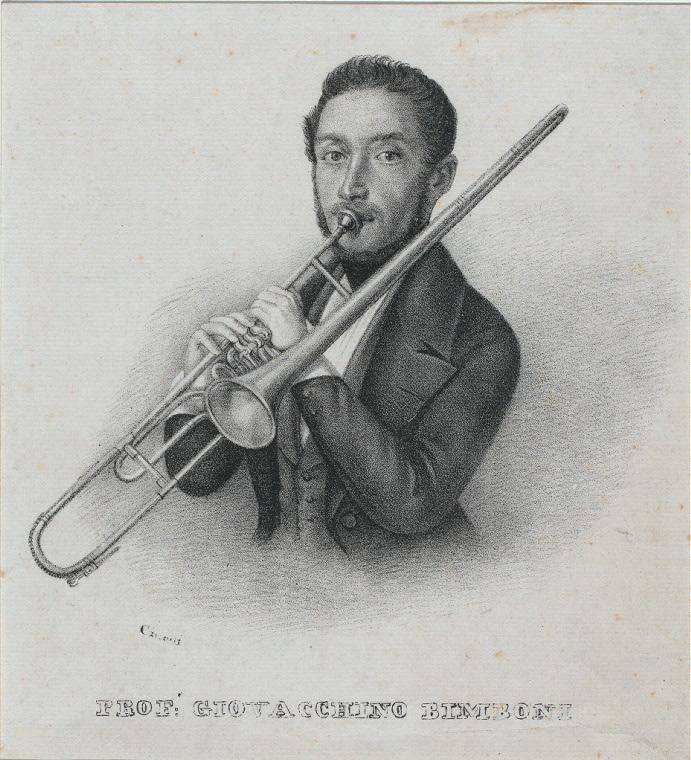
1860—Paris, France: Jules Worms depicts a somewhat villainous-looking trombonist in Le cabaret du Lapin-Blanc, an art work published in the periodical L’Illustration (see below image; public domain) (Vol. 36, 1860, p. 403).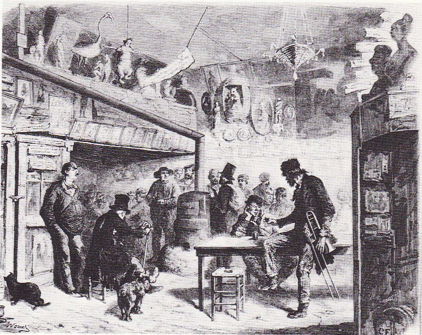
1860—England: An early photograph of the famous Besses o’ th’ Barn band shows 2 trombonists among an ensemble of primarily brass instruments (see below image; public domain) (Baines, Brass pl. XIV). See also c. 1870, below.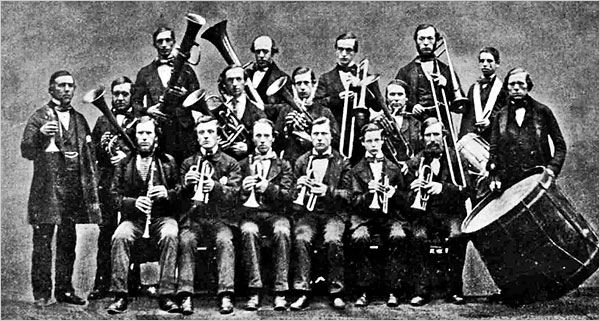 1861—Anton Bruckner’s Offertorium is scored for voices, 3 trombones, and organ (Rasmussen, A Bibliography of Choral Music).
1861—Anton Bruckner’s Offertorium is scored for voices, 3 trombones, and organ (Rasmussen, A Bibliography of Choral Music).
1861—England: The brass band competition at the Crystal Palace features a solo competition for bass instruments. The prize goes to a contrabass trombone player (Whitwell, 19th Century 198).
1861—Paris Conservatory morceau de concours: Henri Hippolyte Potier, Solo.
1861—St. Florian, Austria: Anton Bruckner’s Afferentur regi is premiered, probably for the celebration of the feast day of St. Lucy. The best-known version of the work is set for chorus and 3 trombones (Kinder 41).
1862—Leipzig, Germany: August Bruhns performs the David Concertino at the Gewandhaus.
1862—Paris Conservatory morceau de concours: Henri Hippolyte Potier, Solo.
1862—London, England: Boosey and Sons becomes sufficiently interested in brass instruments to purchase patent rights to double-slide contrabass trombone, which they market as the Basso Profundo (Myers, Brasswind).
1863—Rome, Italy: Concerto di Frascati, a watercolor depicting military musicians in the town of Frascati, part of metropolitan Rome, features trombone and ophicleide (see below image; public domain) (Italian Digital Library; Istituto per la storia del Risorgimento italiano).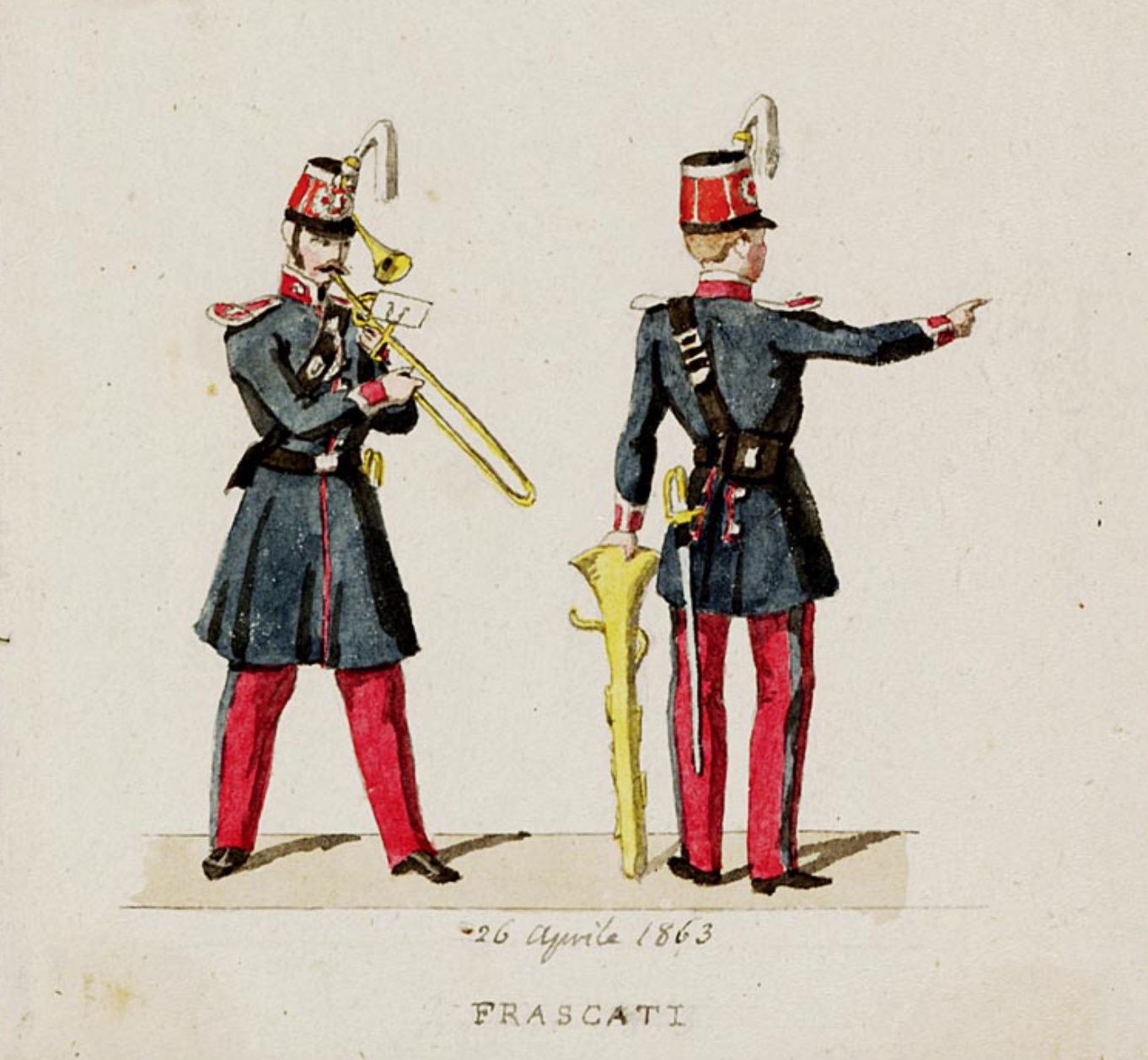
1863—Paris Conservatory morceau de concours: Jules Demersseman, Solo en mi.
1864—Paris, France: Two prints in the illustrated newspaper L’Illustration depict instruments by Adolphe Sax. The first, Audition des nouveaux instruments d’Adolphe Sax, shows a man demonstrating instruments on a stage. The second shows several instruments up close, including a “Nouveau trombone,” a six-valve trombone (see below image; public domain) (L’Illustration vol. XLIV, July 16, 1864, p. 48).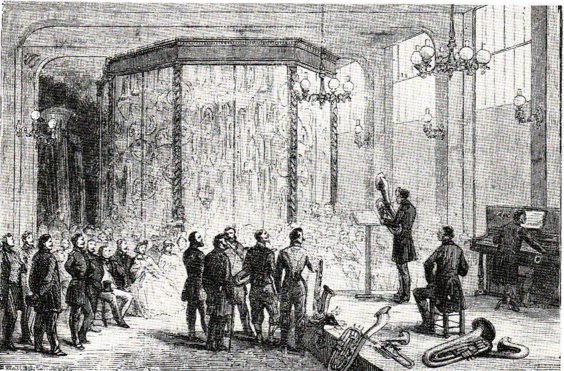
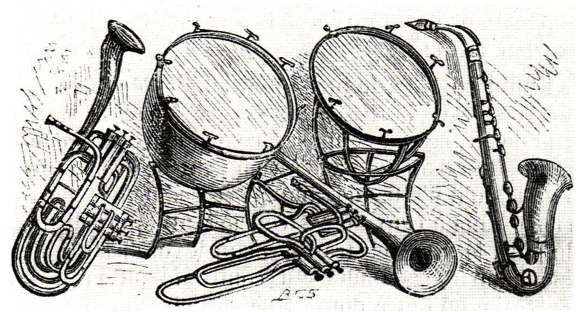
1864—Jean-Baptiste Arban’s Grande méthode complete pour cornet a pistons et de saxhorn. The most universally used brass method, it is soon adapted for trombone.
1864—Paris Conservatory morceau de concours: Antoine Guillaume Dieppo, Solo.
1864—Gustav Besson designs what he calls a trombone duplex, which includes both a valve section (3 valves) and a slide (Carse, Musical 259).
1864—Washington, D.C.: The US Marine Band is photographed with a group of non-musician Marines in front of the Commandant’s house at the Marine Barracks. At this time the band employs 4 trombones, including the father of John Philip Sousa, Antonio Sousa (trombone player second from the right in the front row) (see below image; click to enlarge; public domain) (Garofalo & Elrod, 98).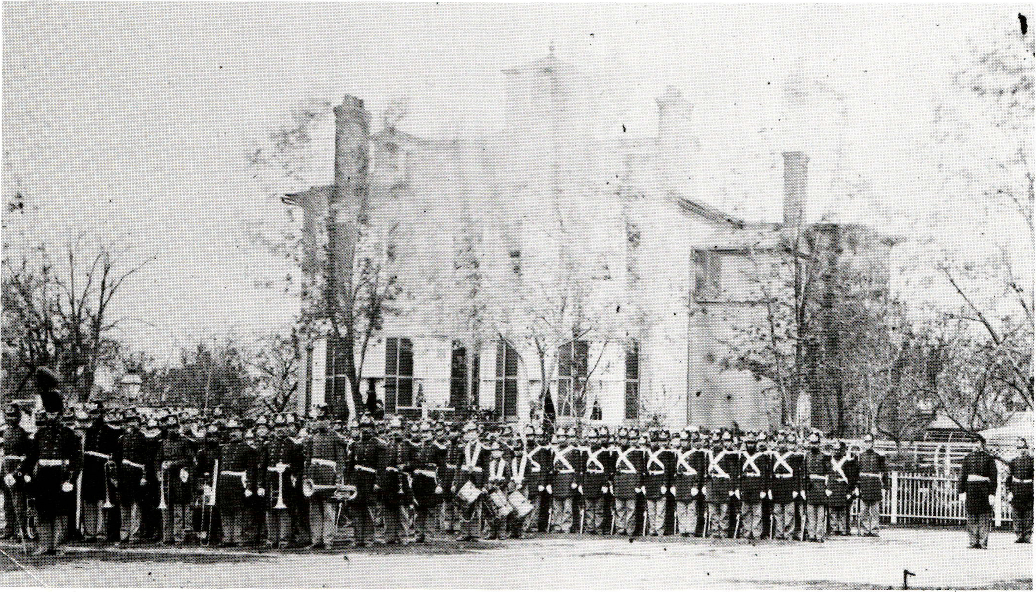
1865—Paris Conservatory morceau de concours: Antoine Guillaume Dieppo, Solo.
1865—Paris, France: A satirical graphic titled Domestic joys of parents whose daughters take part in women’s orchestras, published in Le monde illustré, includes a woman playing a rear-facing trombone (see below image; public domain) (Le monde illustré, 9, no. 442; Sept 30 1865).
1865—Paris, France: A print by caricaturist Honoré Daumier depicting a group of country musicians (Musique de Fete Champetre) includes a rear-facing trombone (see below image; public domain) (Brandeis University Collection; Gartenberg 42).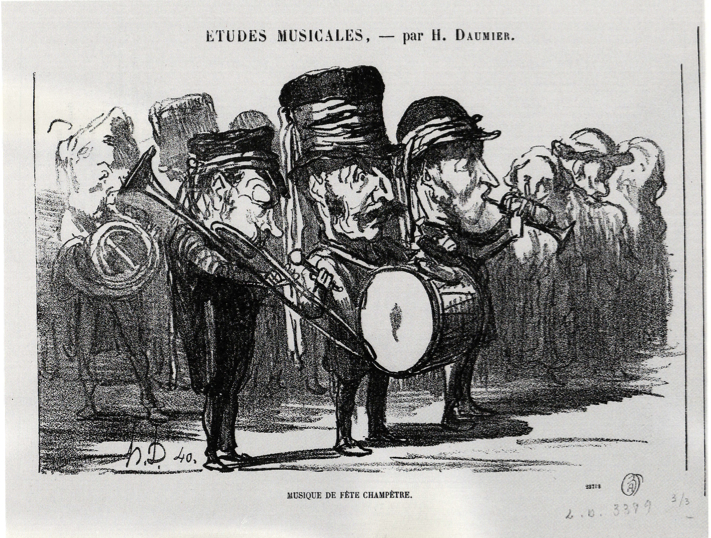
1865—Lancashire, England: A photograph of the 4th Lancashire Rifle Volunteers Band shows trombone players with alto, tenor and bass trombones (see below image; public domain).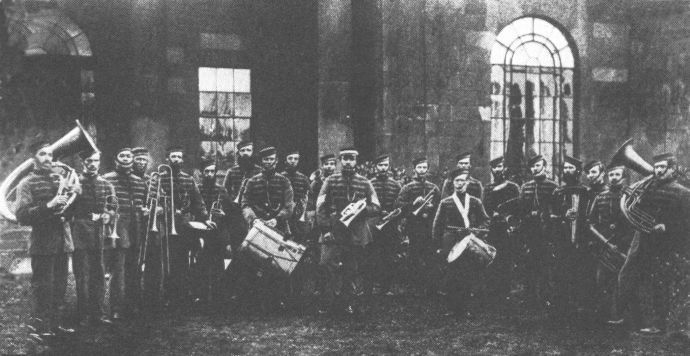
c. 1865-1870—Germany: David Martin Kanning publishes a print, Hamburger Bürger-Militair (Artillerie), which includes a trombone among a group of military musicians (see below detail; public domain) (Ryan 178).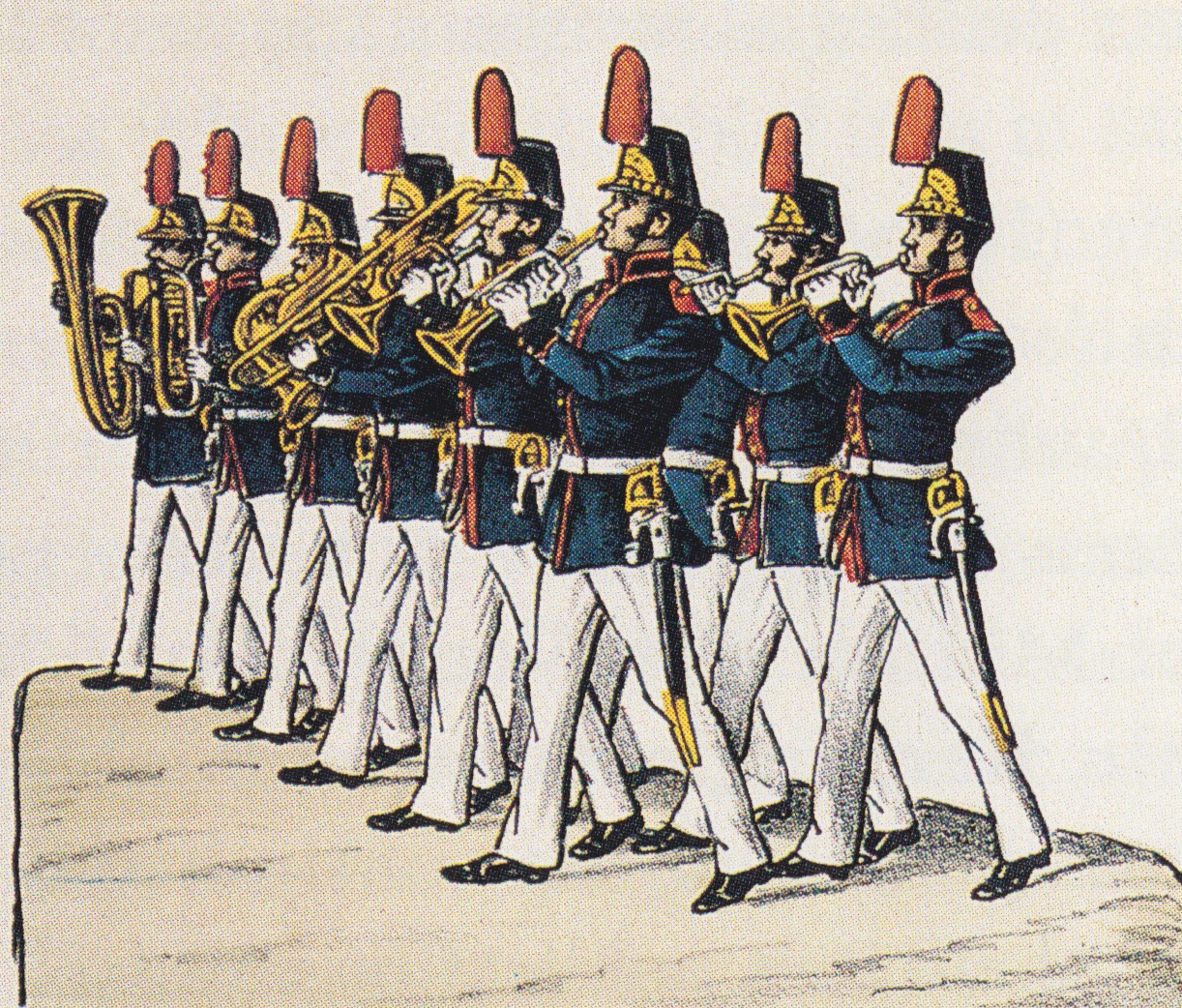
1865-1916—Netherlands: A painting by artist Willem Constantijn Staring (1847-1916) depicts bandsmen of the 9th Regiment Infantry, including a pair of trombonists. Notice also the green-colored serpent (see below image; public domain).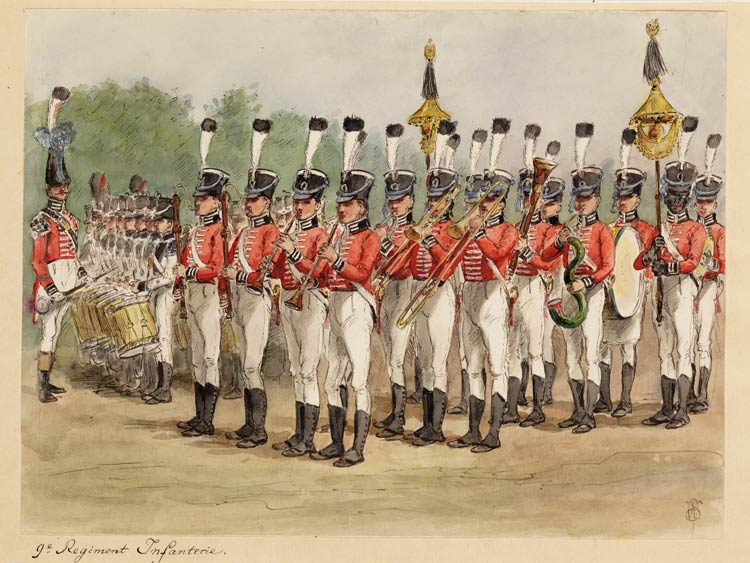
1866—Paris, France: Adolphe Sax manufactures a valve bass trombone. A very tall, narrow instrument, the lowest point apparently rests on the ground as it is played (Haine 151).
1866—Paris Conservatory morceau de concours: François Bazin, Solo.
1866-1871—German-born trombonist Frederick Letsch serves as soloist with the Theodore Thomas orchestra. The program for an 1866 concert at Irving Hall bills him as “the celebrated trombone soloist” and a performance at Steinway Hall announces him as “The Unequaled Trombone Player.” His repertoire includes David’s Concertino, Sachse’s Concerto, Giorgio Stigelli’s “The Tear,” and Peter Joseph von Lindpainter’s “The Standard Bearer.” According to Guion, Letsch performs as soloist with the Thomas orchestra at least 184 times (Guion, Four American).
1866-1897—The Netherlands: Printer Franciscus Anthonius Beersmans publishes a woodcut, Ten strijde! (“To battle!”), that features several Dutch military musicians, including one with a rear-facing trombone (see below image; public domain) (Catchpenny Prints of the Royal Dutch Library).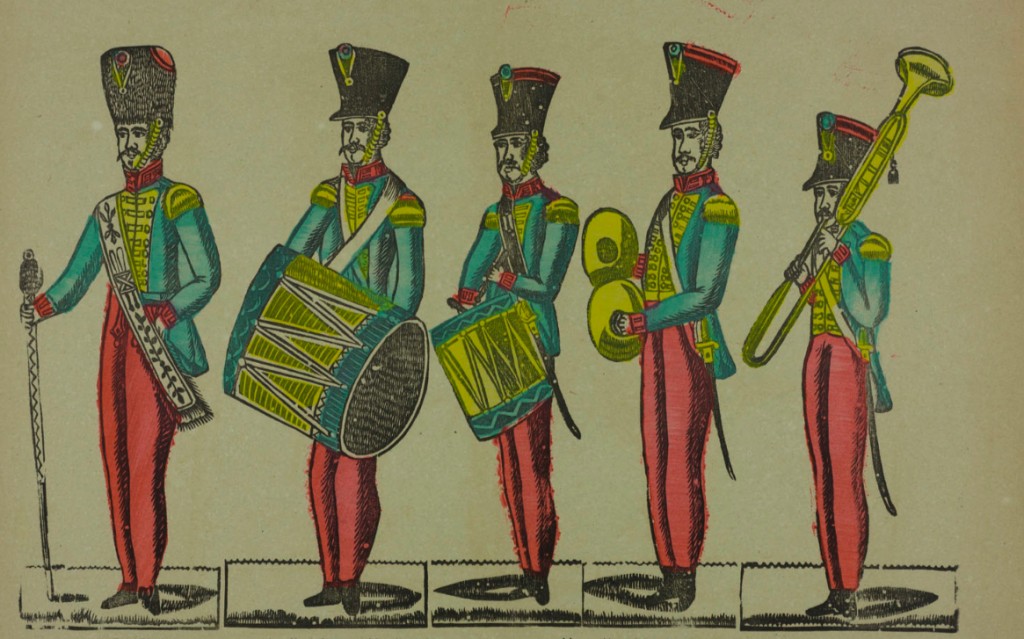
1867—Leipzig, Germany: A trombonist by the name of Nabich performs the David Concertino at the Gewandhaus.
1867—London, England: F. J. Fetis, in his orchestration guide published in the periodical The Musical World, says, “The compass of the trombone alto, like the bass trombone, is not alike in all countries; in Germany the dimensions of the tubes being larger than in France, and the manner in which some portions of it are disposed being different, the bass trombone descends to C, while in France, it only descends to E…The alto trombone is a fifth higher than the bass trombone, and descends to B-flat, reaching up to E-flat….Three parts are generally written for the trombones, which are called bass trombone, tenor trombone, and alto trombone. The tenor trombone part is sometimes played upon the bass trombone. Some composers write these three parts on the one set of lines, with the F, or bass clef; others the tenor part with the key or C upon the fourth line; others write upon the same set of lines, the tenor and bass trombone parts, and on the next lines write the alto trombone part. Others again write each part separately, and in the key of each instrument” (Fetis 477).
1867—Paris Conservatory morceau de concours: Antoine Guillaume Dieppo, Solo.
1867—Bethlehem, Pennsylvania: A photograph of 3 trombonists of the Moravian community shows, from left to right, Charles F. Beckel, Jedidiah Weiss, and Jacob Till, with an empty chair in honor of their deceased colleague, Timothy Weiss (see below image; public domain) (Moravian Archives, Bethlehem, PA).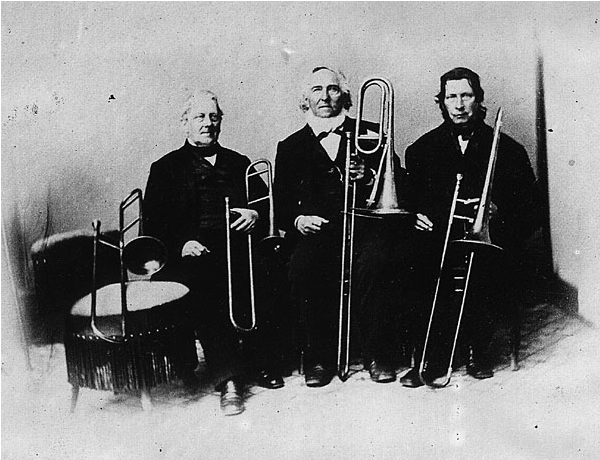
1868—London, England: Boosey becomes a major player in the brass market with purchase of Henry Distin’s instrument factory (Myers, Brasswind).
1868—Paris Conservatory morceau de concours: Antoine Guillaume Dieppo, Solo.
1868—Linz, Austria: Anton Bruckner composes the offertory Inveni David, scored for male chorus and 4 trombones (Kinder 66; Rasmussen, A Bibliography of Choral Music).
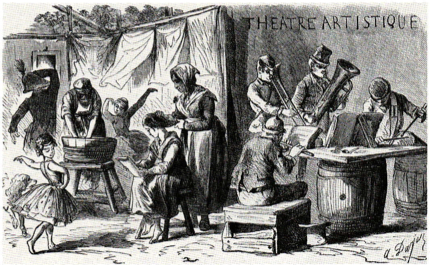 1869—Paris, France: A print by Alfred-Henri Darjou entitledThe Entertainers Behind the Barracks appears in the French illustrated newspaper, L’Illustration. Four musicians–flute, rear-facing trombone, ophicleide, and drums–rehearse together at a makeshift table (see above image; public domain) (L’Illustration vol. LIV, July 24, 1869, p. 60).
1869—Paris, France: A print by Alfred-Henri Darjou entitledThe Entertainers Behind the Barracks appears in the French illustrated newspaper, L’Illustration. Four musicians–flute, rear-facing trombone, ophicleide, and drums–rehearse together at a makeshift table (see above image; public domain) (L’Illustration vol. LIV, July 24, 1869, p. 60).
1869—London, England: Irish artist Daniel Maclise paints King Cophetua and the Beggarmaid, a depiction of a popular legend. The painting includes a trombonist as a member of the king’s party, the player’s instrument silhoutted against the blue sky behind the passing maid (see below image; public domain).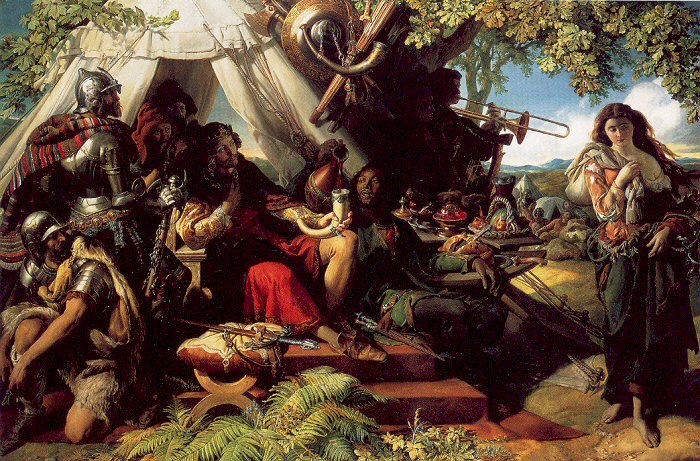
1869—Germany: An anonymous depiction of a ball includes 7 musicians, probably Stadtpfeifer, performing dance music from a loft (see upper-left of below image; public domain) (Eisfeld, Museum Otto Ludwig; Salmen, Tanz im 19, 129).
1869—Germany: A rear-facing trombone is featured in The Concert in the Garden Pavilion, an engraving by Capri, after an illustration by Anton von Werner (Der Trompeter von Säckingen,” 1860) (see below image; public domain).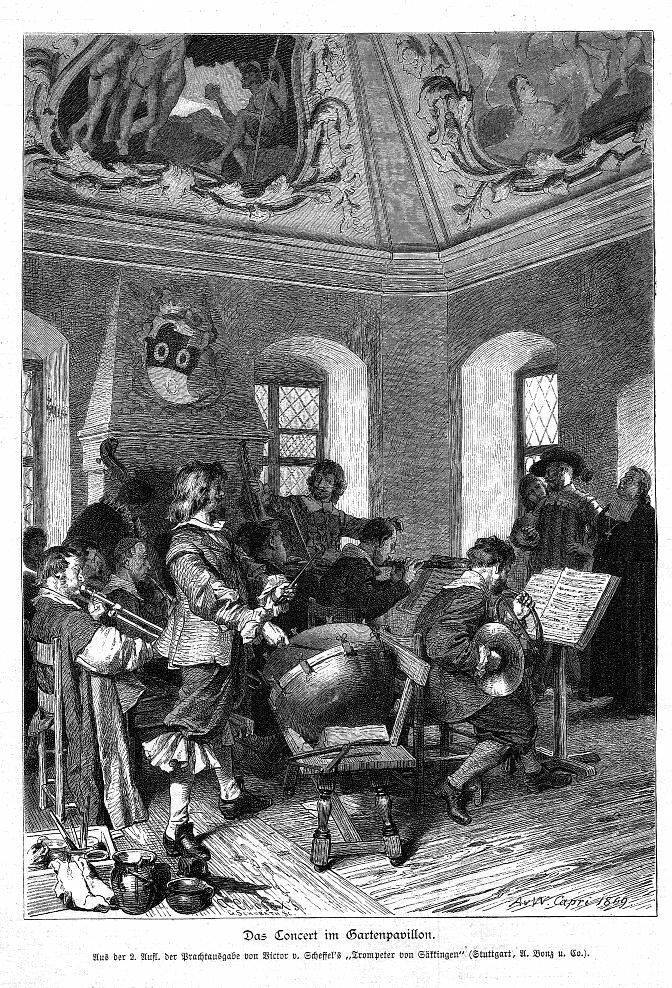
1869—Paris Conservatory morceau de concours: Jules Louis Cressonnois, Solo.
c. 1870—Part books from the Besses o’ th’ Barn band containing important large-scale arrangements by Alexander Owen for brass band, including trombone parts, date from this time (Herbert, Brass Bands 183).
c. 1870—Carl Bernhard Schloesser’s Une Repetition General depicts a lively orchestra rehearsal, probably in Switzerland. A mixture of young and old players are represented, the trombonist taking a break to refresh himself (see below lithograph by Thielly after Schloesser; public domain).
1870s—Manchester, England: A valve alto trombone is manufactured by Joseph Higham, bearing the marking, “Joseph Higham, 127 Strangeways, Manchester, Exhibition prize medal awarded London 1852 and Dublin 1863” (see below image; used by permission of Brass Players Museum: www.neillins.com/brass.htm).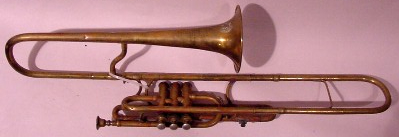
c. 1870—English artist Robert Alexander Hillingford (1828-1904) paints Trombone Player. The unusual grip and posture of the player reflect a humorous struggle (not to mention the impossible configuration of the instrument’s tubing). See below image; public domain.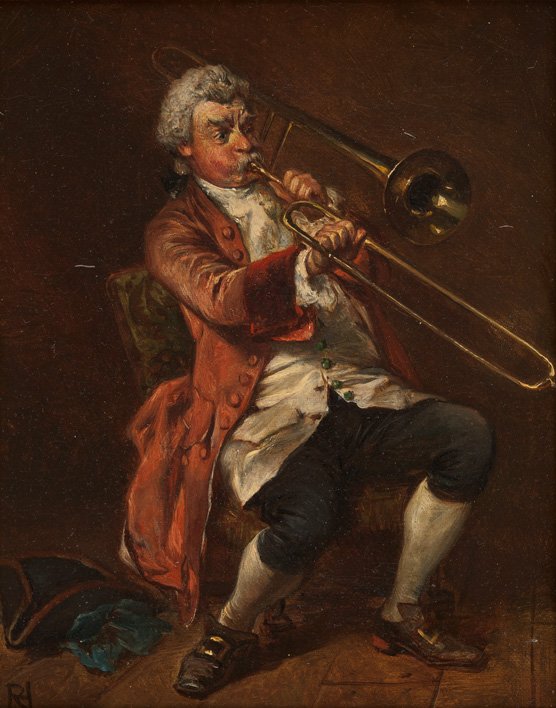
1870—London, England: Adam Wirth’s trombone method, Posaunen-Schule für Alt, Tenor und Bass-Posaune…Instruction Book of the Simple and Valve-Trombone, written in both German and English, is apparently intended for a wide audience. It includes a “Table of the different Trombones” that shows alto trombone in E-flat (like the vast majority of written sources), valve and slide tenors in B-flat, and bass in F (see below image; public domain) (Herbert, Trombone 192).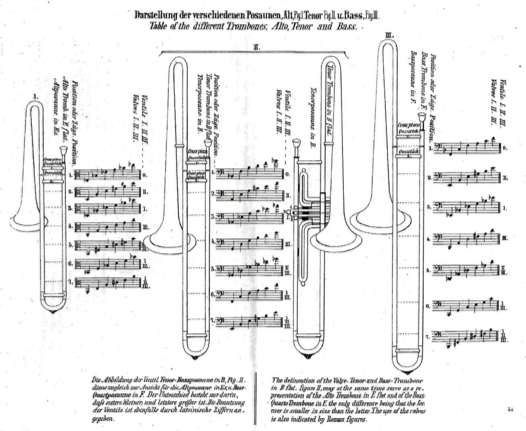
1870—First trombone teacher hired at St. Petersburg Conservatory (8 years after opening of school).
1870—Paris Conservatory morceau de concours: Olivier Métra, Concerto.
1870—Turnov, Czech Republic: An engraving after a drawing by A. J. Levy (1845-1897) portrays a trombone playing with a brass band in the public square in Turnov (see detail below; public domain) (Volek plate 347).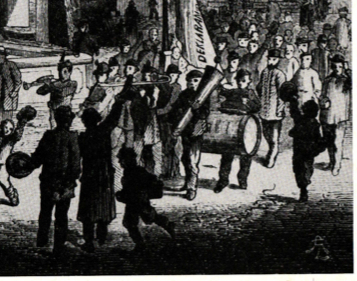
1870-71—Paris, France: A satirical lithograph by caricaturist De La Tramblais shows German Emperor Wilhelm I and Otto von Bismarck with a guitar and trombone, respectively, serenading an obviously unreceptive woman (see below image; public domain) (Victoria & Albert Museum).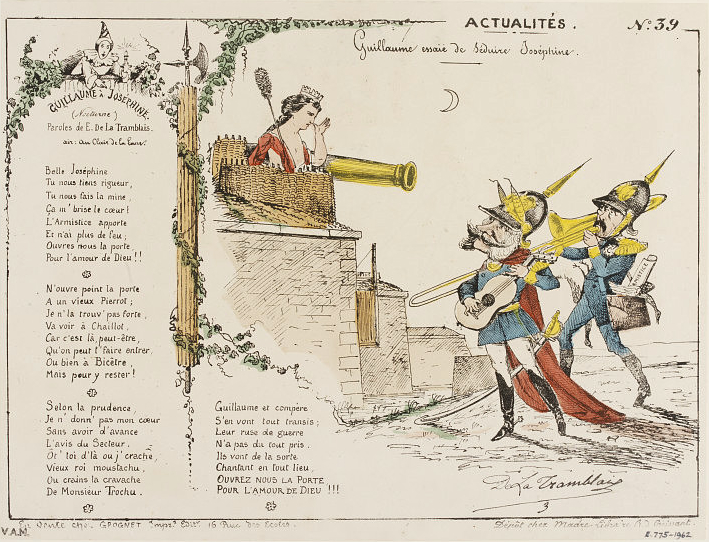
1870-76—Adolph Sax manufactures a valve bass trombone in F with six independent piston valves (Haine 175).
1871—Milan, Italy: Giuseppe Verdi makes the following comment about bass trombone in a letter to his publisher about the forthcoming Italian premiere of Aida: “I must insist on the fourth trombone. That bombardon is impossible. Tell Faccio [the conductor] to consult the first trombonist if he thinks fit, to see what should be done. I should prefer a bass trombone, which is of the same family as the others: but if it proves too tiring and difficult to play, take one of the usual ophicleides which go down to low B. In short, do whatever you please, but not that devil of a bombardon which does not blend with the others” (Leavis, Cimbasso).
1871—Paris, France: Léonce Schérer depicts a man with a rear-facing trombone in his lithograph, Souvenirs de la Commune (see below image; public domain) (Victoria & Albert Museum).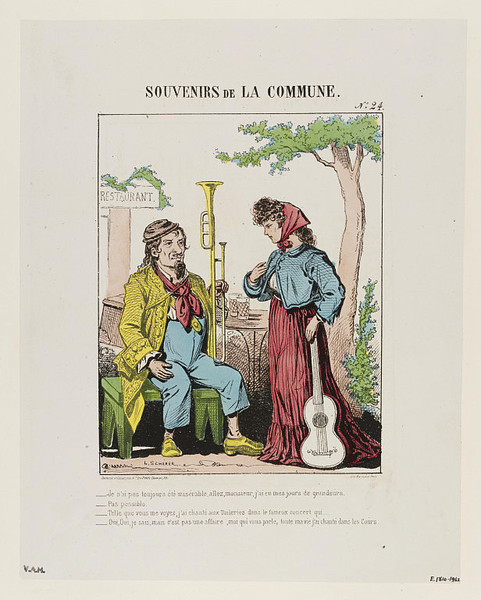
1871—Franz Liszt completes his Requiem for Men’s Voices and Organ. The organ is supplemented with 2 trumpets, 2 trombones, and timpani for dramatic outpourings, including the “Tuba mirum,” “Lacrymosa,” and “Hosanna in excelsis” (Chase 280).
1871—Paris, France: A lithograph titled A propos de la crise monétaire (“about the currency crisis”) from a series of prints by French caricaturist B. Moloch (B. Colomb) called Les Silhouettes de 1871 depicts a woman playing a rear-facing trombone, along with a well-dressed man wearing a sign asking for pity and donations (see below image; public domain).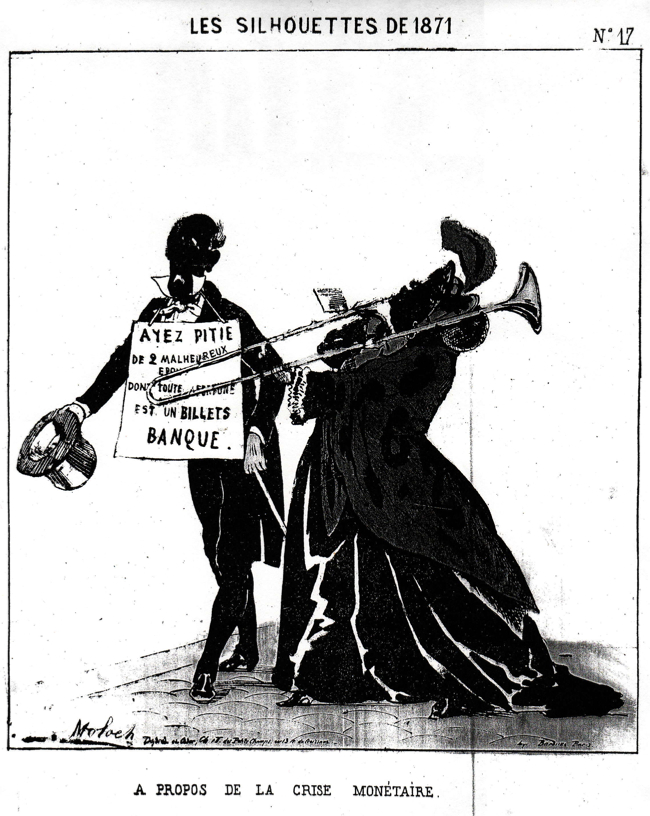
1871-88—London, England: Production records for Boosey & Co. show a surprisingly high number of alto trombones: 89 alto valve trombones in E-flat, 3 alto slide trombones in E-flat, and 2 alto slide trombones in F (Myers, Brasswind).
1871-88—Paul Delisse runs the trombone studio at the Paris Conservatory (Dudgeon 195).
1872—Date marked on unusually large bass trombone, now housed in Städt.Musik-instrumentensammlung, Munich. The instrument, pitched in F, has a typical slide extension handle, but also features a brace midway down the slide, probably to stabilize the unusually long, heavy slide. Overall length is 130 cm; bell diameter is 22.2 cm.
1872—Paris Conservatory morceau de concours: A. Fessy, Solo de concours.
1872—London, England: A humorous depiction of an ensemble titled German Band is published in The Graphic, an illustrated weekly newspaper (see below image; public domain).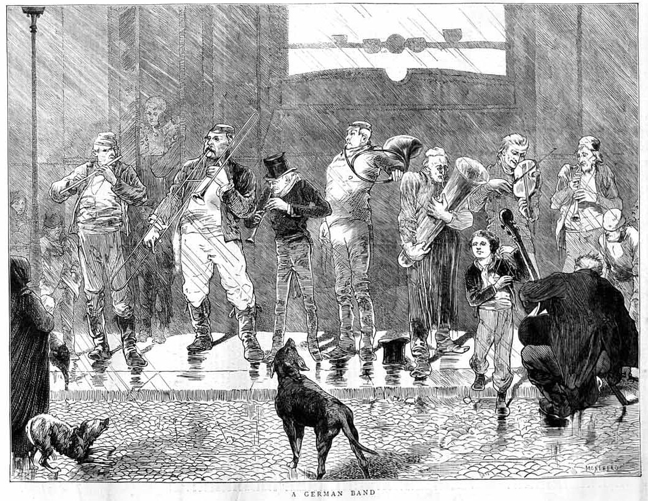
1873—Leipzig, Germany: August Bruhns performs the David Concertino at the Gewandhaus.
1873—Paris Conservatory morceau de concours: Frederic Berr, Air varié sur le Pirate.
1873—France: L’Alsace d’autrefois, an engraving from Le Monde Illustré, depicts a trio of musicians, including trombone, playing for a dance in old Alsace, France. 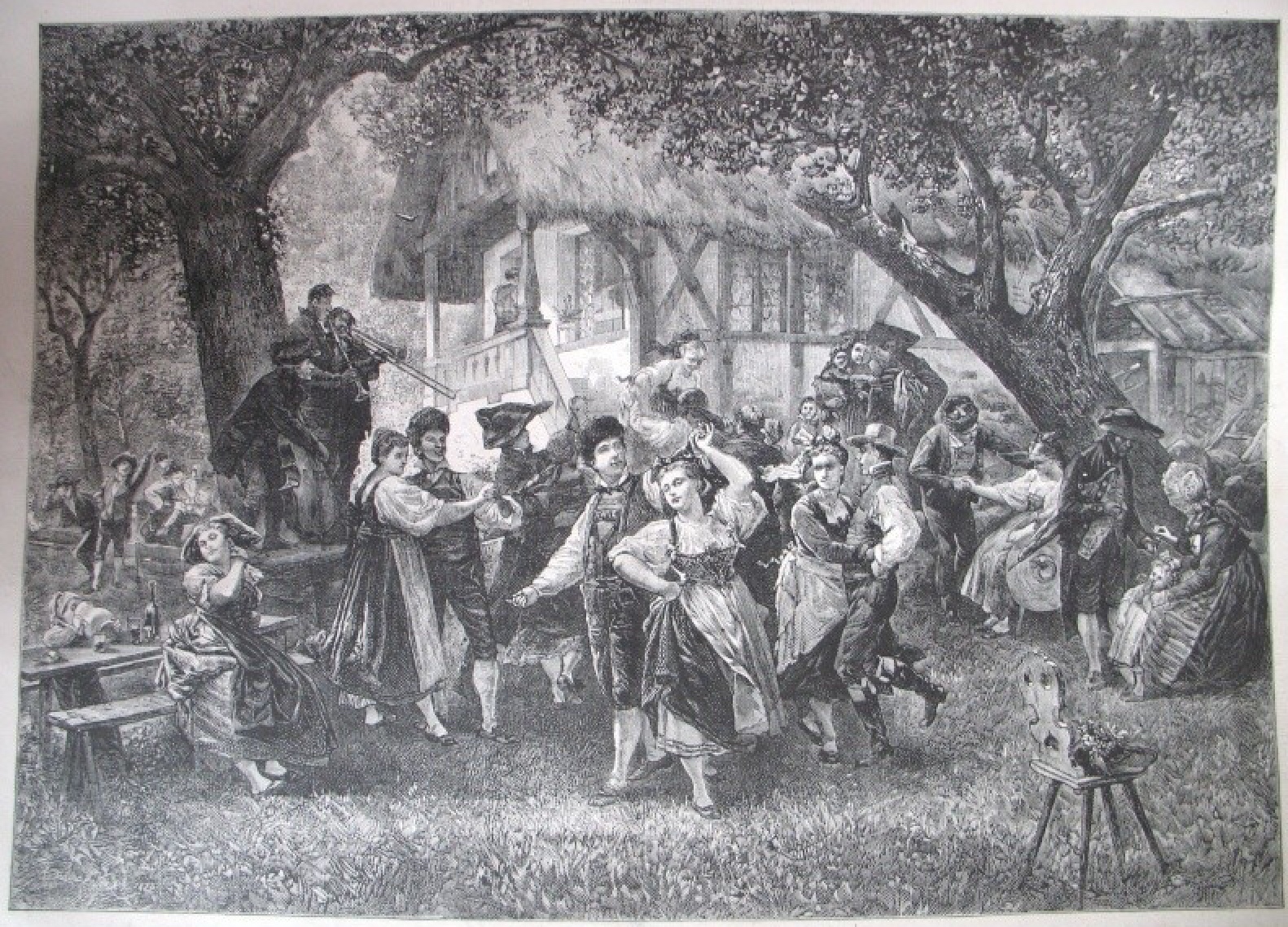
1873—Paris, France: Christmas Eve in a Spanish Church, a print after Miranda appearing in the Paris illustrated newpaper, L’Illustration, features a buccin, or trombone with a bell in the shape of a dragon’s head (see below image; public domain) (L’Illustration, January 4, 1873, pp. 10-11).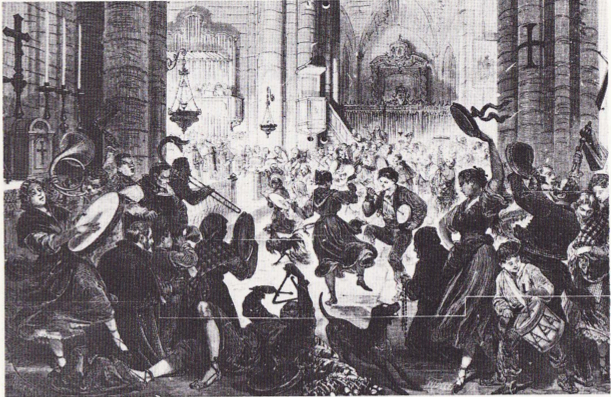
1873—Leipzig, Germany: The Women’s Orchestra of Frau Amann-Weinlich, A woodcut after a drawing by Vincent Katzler, includes a female trombonist as part of a depiction of an all-female orchestra. The trombonist is situated in the upper-left (see below image; click to expand; public domain) (Schwab 159).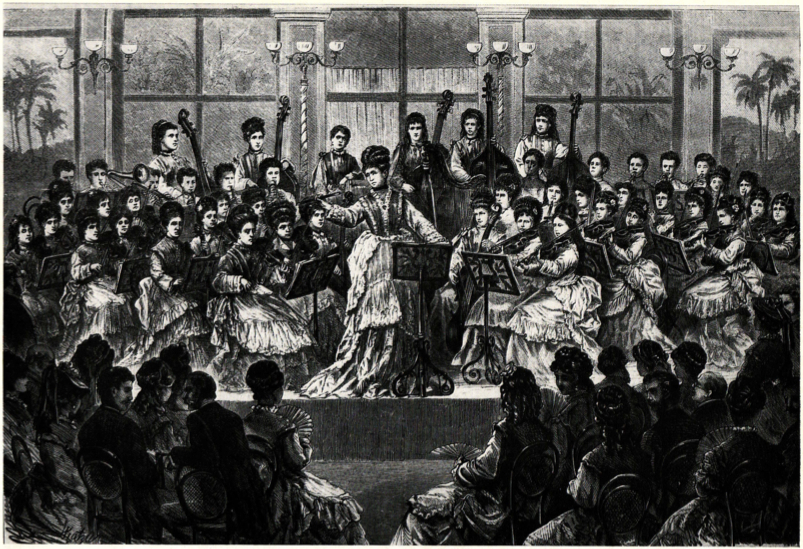
1873—Italy: Angelo Inganni’s painting, Festa di nozze in un cortile (Wedding Party in a Courtyard) includes a trombone playing with a small ensemble (see detail and full image below; public domain) (Trieste, Civico Museo Revoltella).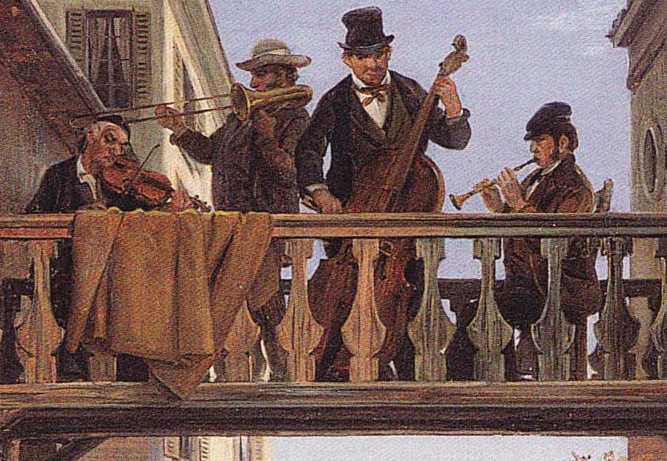
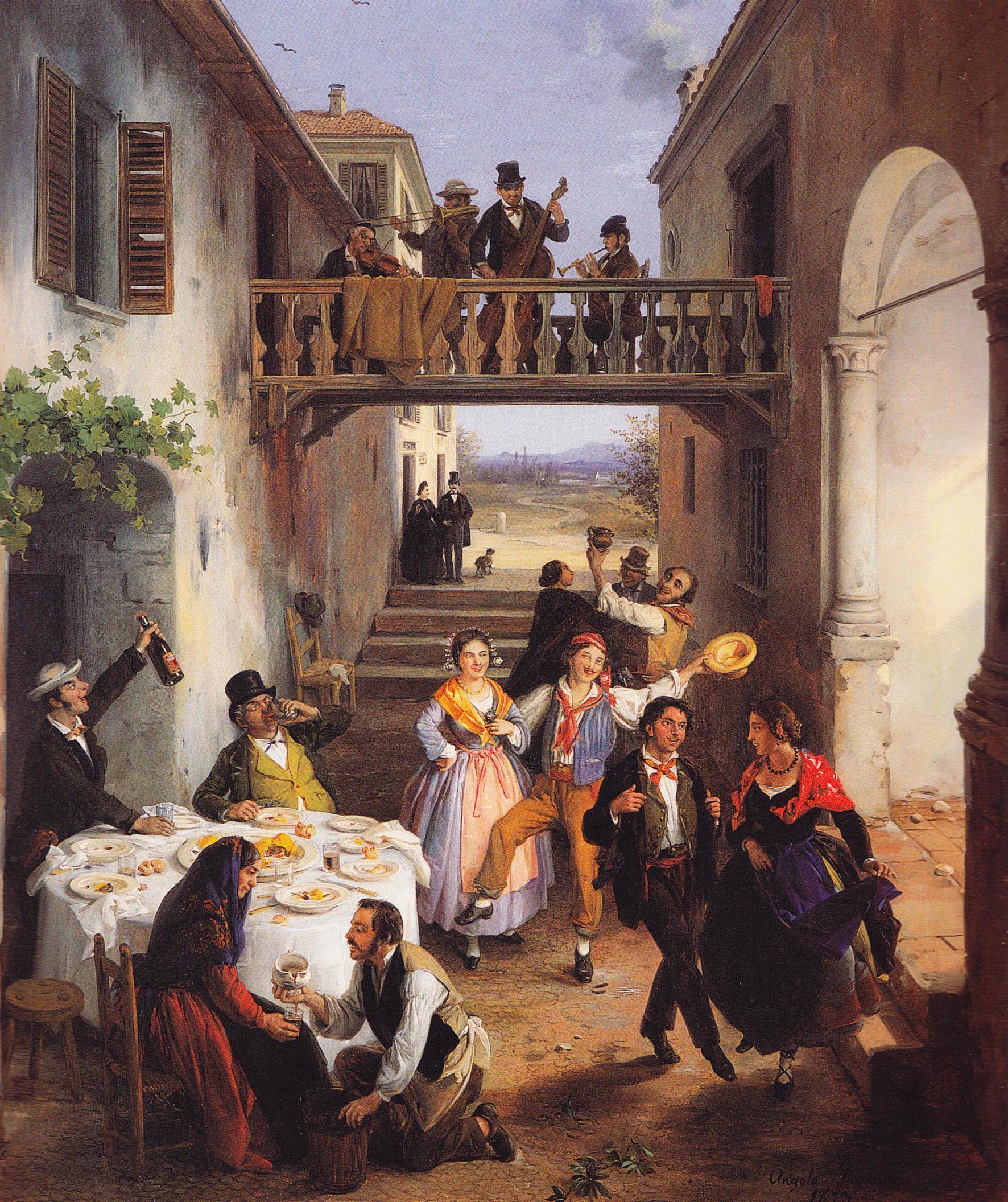
1873-1901—England: The brass band movement is dominated by 3 conductors: John Gladney, Alexander Owen, and Edwin Swift. Every Open Contest except one during this span is won by bands conducted by one of these 3. The standard brass band format is established during this time and features instrumentation favored by these 3 conductors. It includes 2 tenor trombones and a bass trombone (Herbert, Brass Bands 182).
1874—Bethlehem, Pennsylvania: The Moravians at Bethlehem, Pennsylvania, an engraving by A.R. Waud published in Harper’s Weekly, depicts trombone ensembles performing from a church tower (“Funeral Notes”) and at a graveside service (“Burial Service”) (see below detail; public domain) (Harper’s Weekly, 1874, Issue 4/18, p. 346).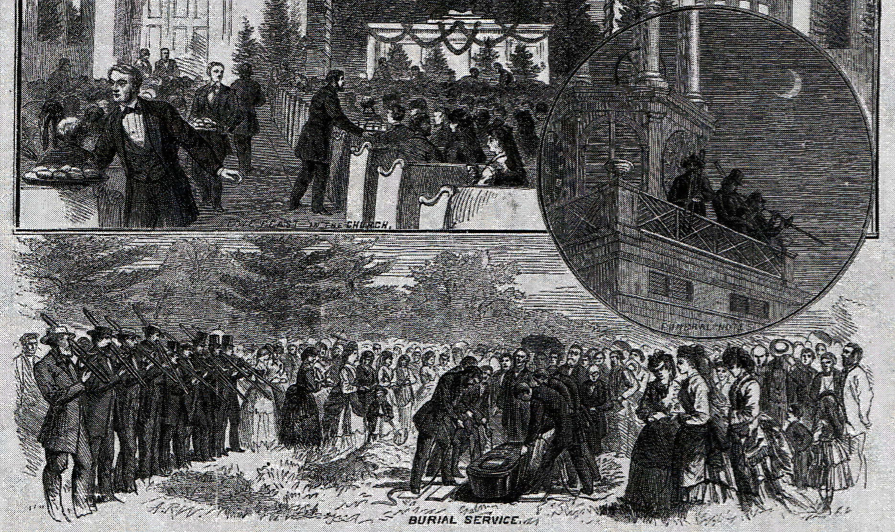
1874—Giuseppe Verdi composes his Manzoni Requiem, often called his “greatest opera,” in honor of poet-patriot Alessandro Manzoni. Premiered a year later at the Church of San Marco, Milan, the work calls for 3 trombones. The “Dies irae,” in particular, in which “volcanic anger is depicted by the powerful brass and timpani,” utilizes trombone prominently (Chase 300).
1874—Paris Conservatory morceau de concours: Jules Demersseman, Solo de concert en si.
1874—New York: Harper’s Weekly publishes an engraving, entitled “Italian Acrobats,” after a painting by Román Ribera. It includes a man carrying a buccin, or trombone with dragon-head bell, which is possibly part of a one-man-band configuration (see below image; public domain) (June 20, 1874).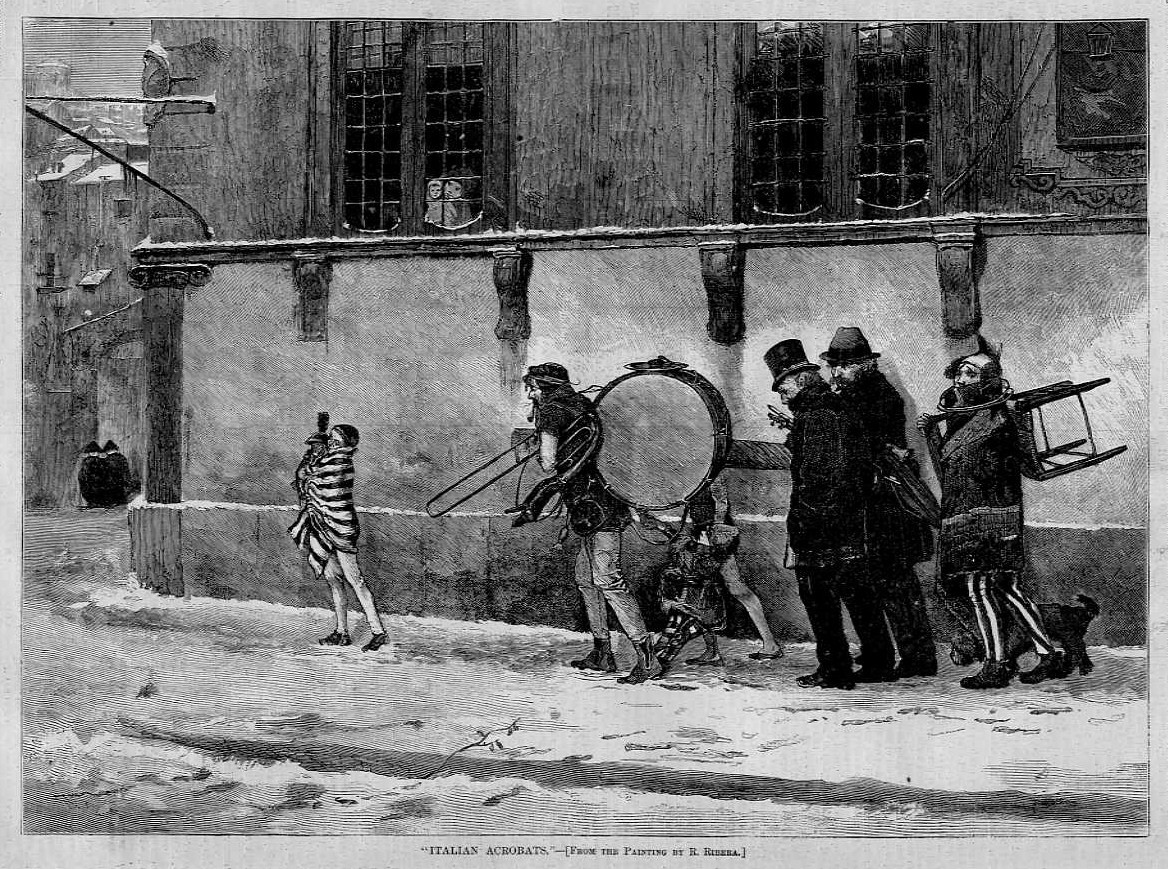
1874—Richard Wagner completes Ring des Nibelungen, which features trombone extensively.
c. 1875—France: Jules Denneulin’s painting, A Sad Recital, includes a trombonist performing in a wintry outdoor setting with what appears to be a town band (see below image, after painting by Denneulin; click to enlarge; public domain image) (Seidl, vol. 1, 122).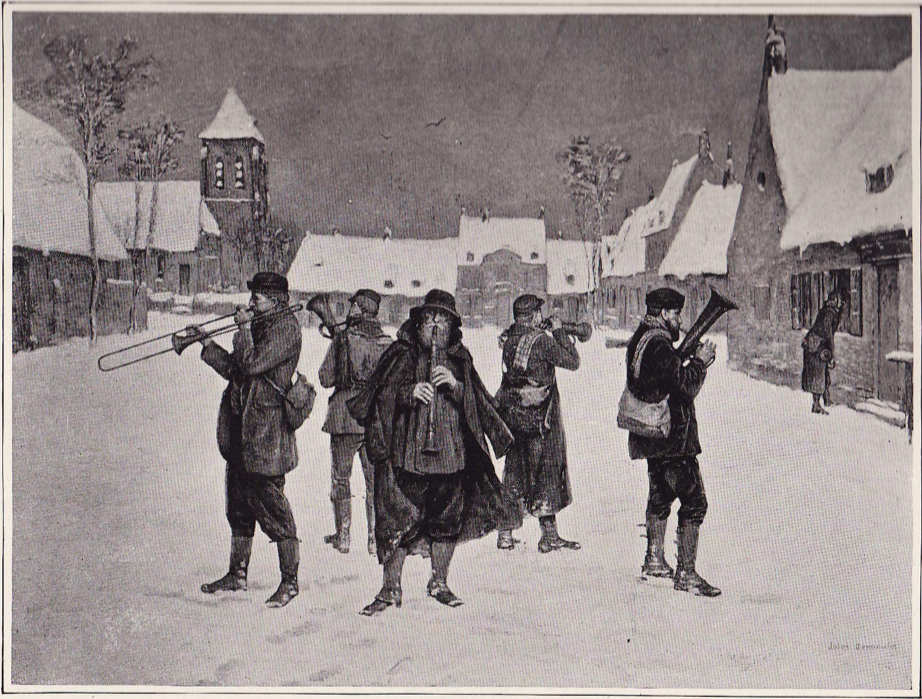 c. 1875—Vienna, Austria: A set of paper theater figures by Matthäus Trentsensky for Der Letzte Zwanziger includes a bear playing trombone (see below image; public domain) (Germanic National Museum, Nuremberg).
c. 1875—Vienna, Austria: A set of paper theater figures by Matthäus Trentsensky for Der Letzte Zwanziger includes a bear playing trombone (see below image; public domain) (Germanic National Museum, Nuremberg).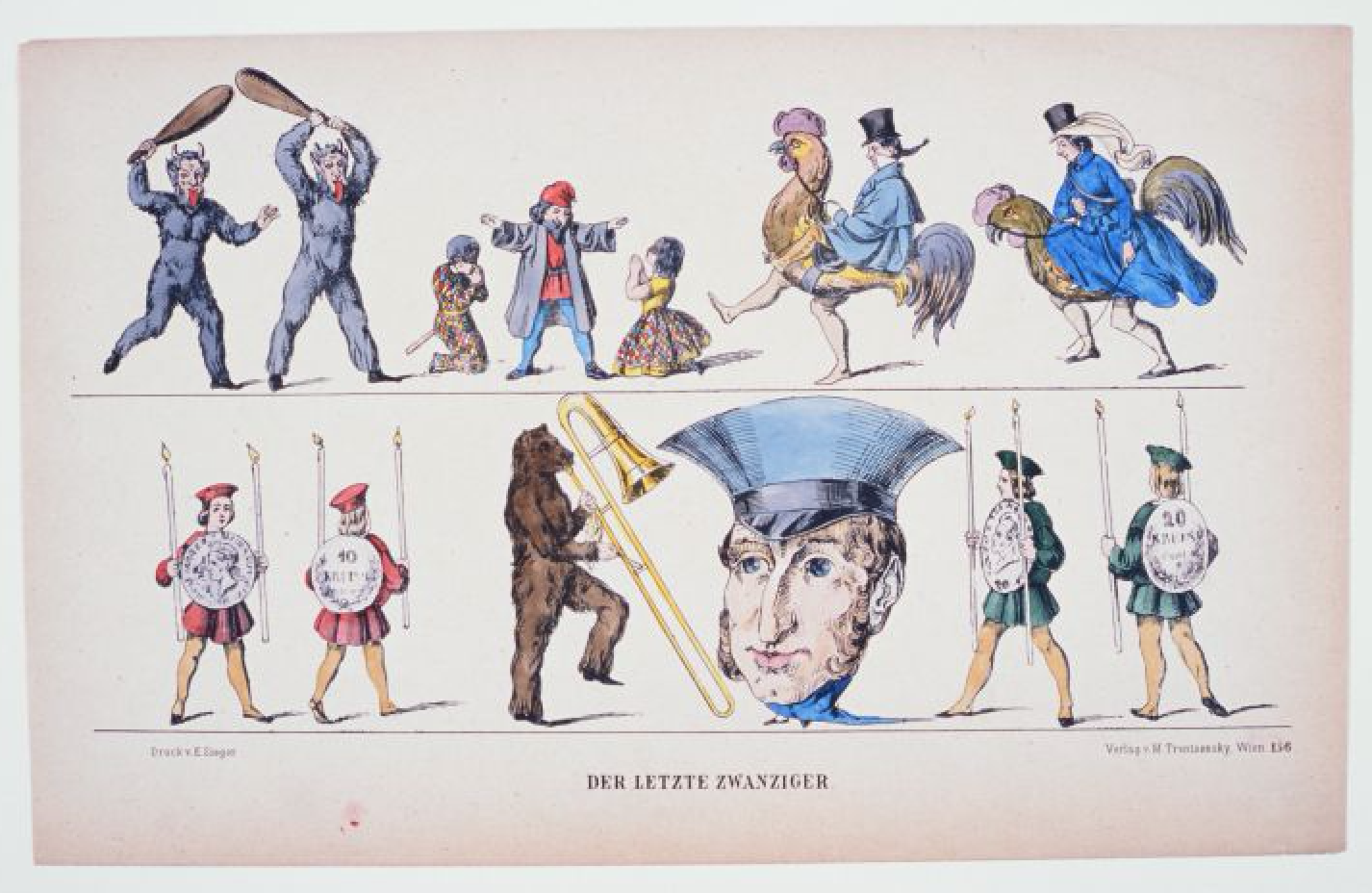 c. 1875—Barcelona, Spain: Colección de Monos Filarmónicos, a satirical woodcut by Llorens Printing, depicts monkeys playing a variety of musical instruments, including a buccin, or trombone with dragon-head bell (see detail and full image below; public domain).
c. 1875—Barcelona, Spain: Colección de Monos Filarmónicos, a satirical woodcut by Llorens Printing, depicts monkeys playing a variety of musical instruments, including a buccin, or trombone with dragon-head bell (see detail and full image below; public domain).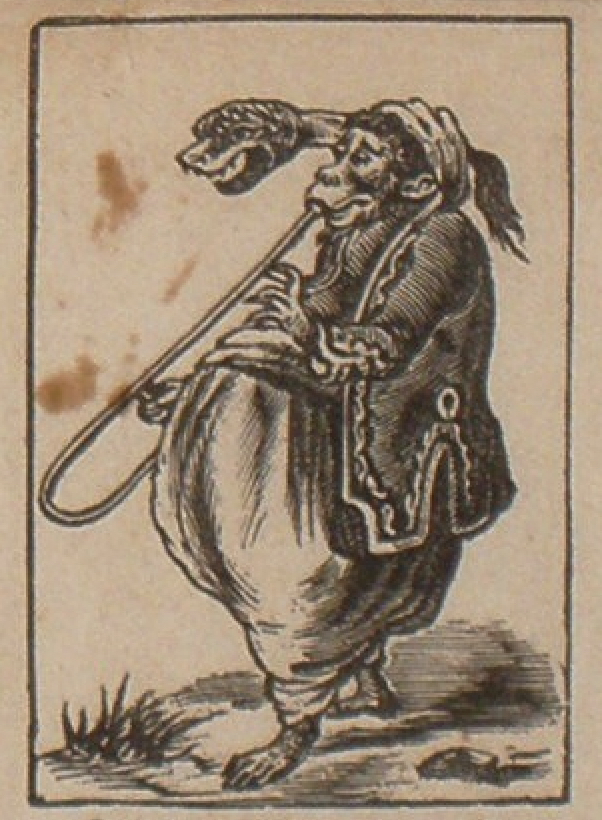
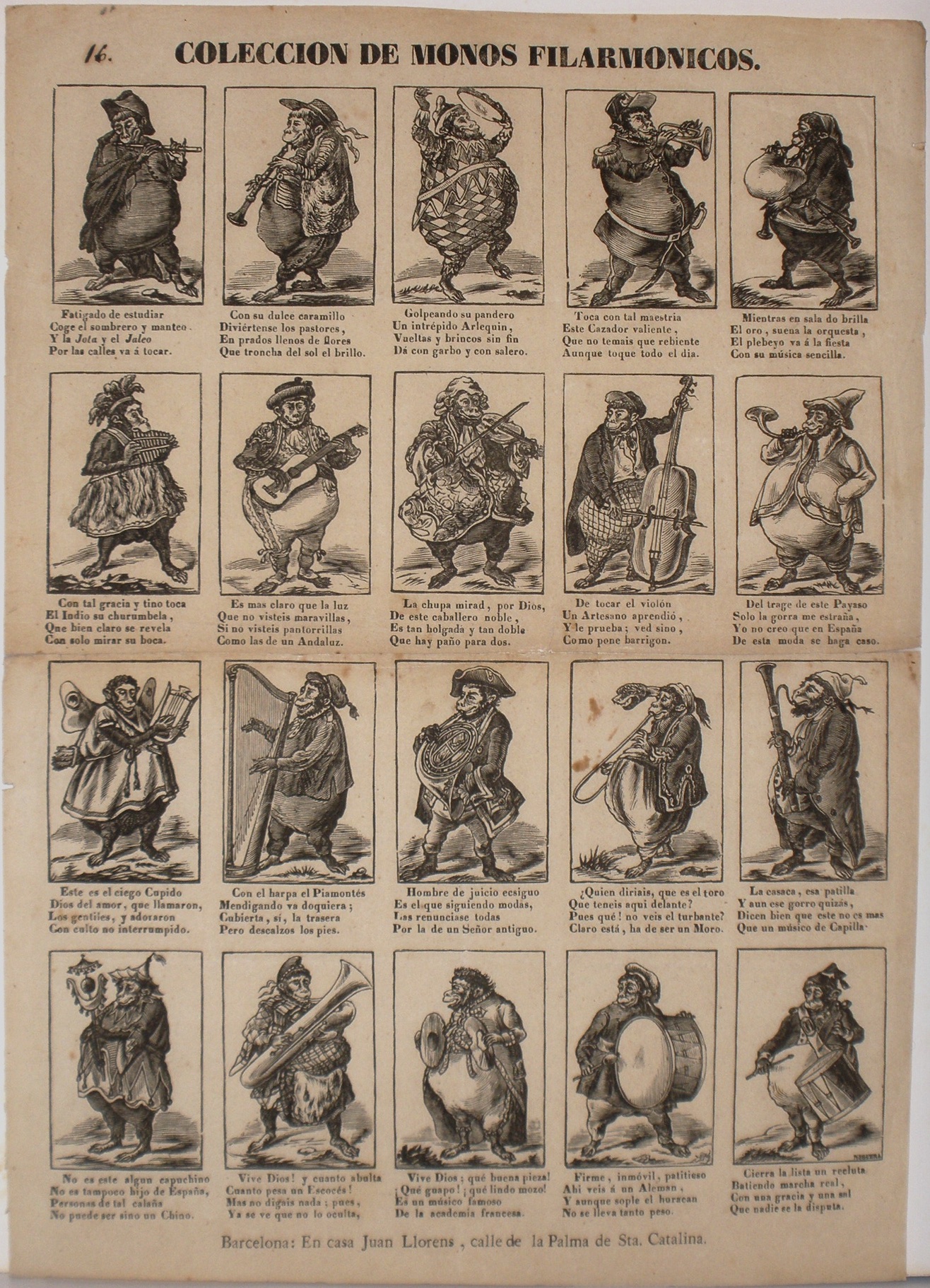
c. 1875—Switzerland: Artist Karl Jauslin (1842-1904) sketches a portrait of Hans Ramstein playing trombone (see below image; Museen Muttenz; public domain).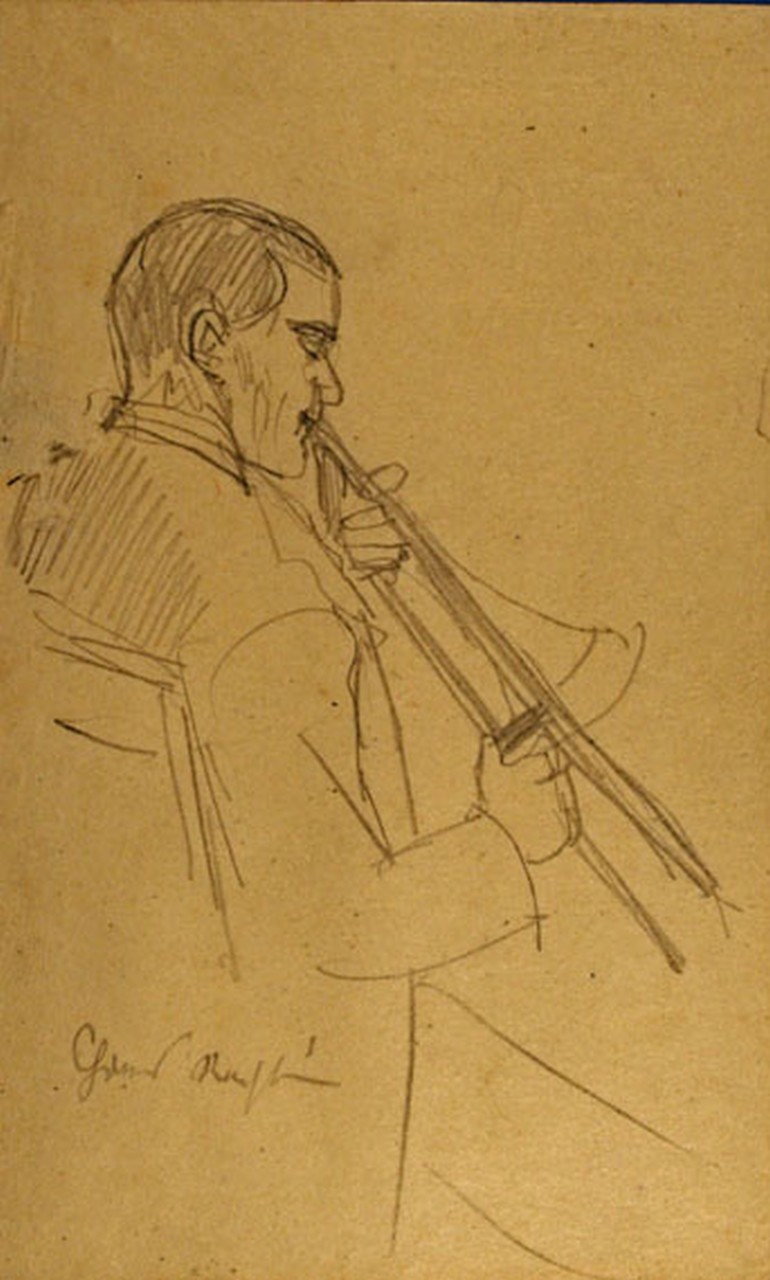
c. 1875—Polish artist Franciszek Streitt’s oil painting, Traveling Musicians Performing in a Galician Village, includes two trombonists (see cluster of musicians in front of largest building and cluster of musicians in front-center; public domain). Source: Lempertz Auction Hourse, Lempertz.com.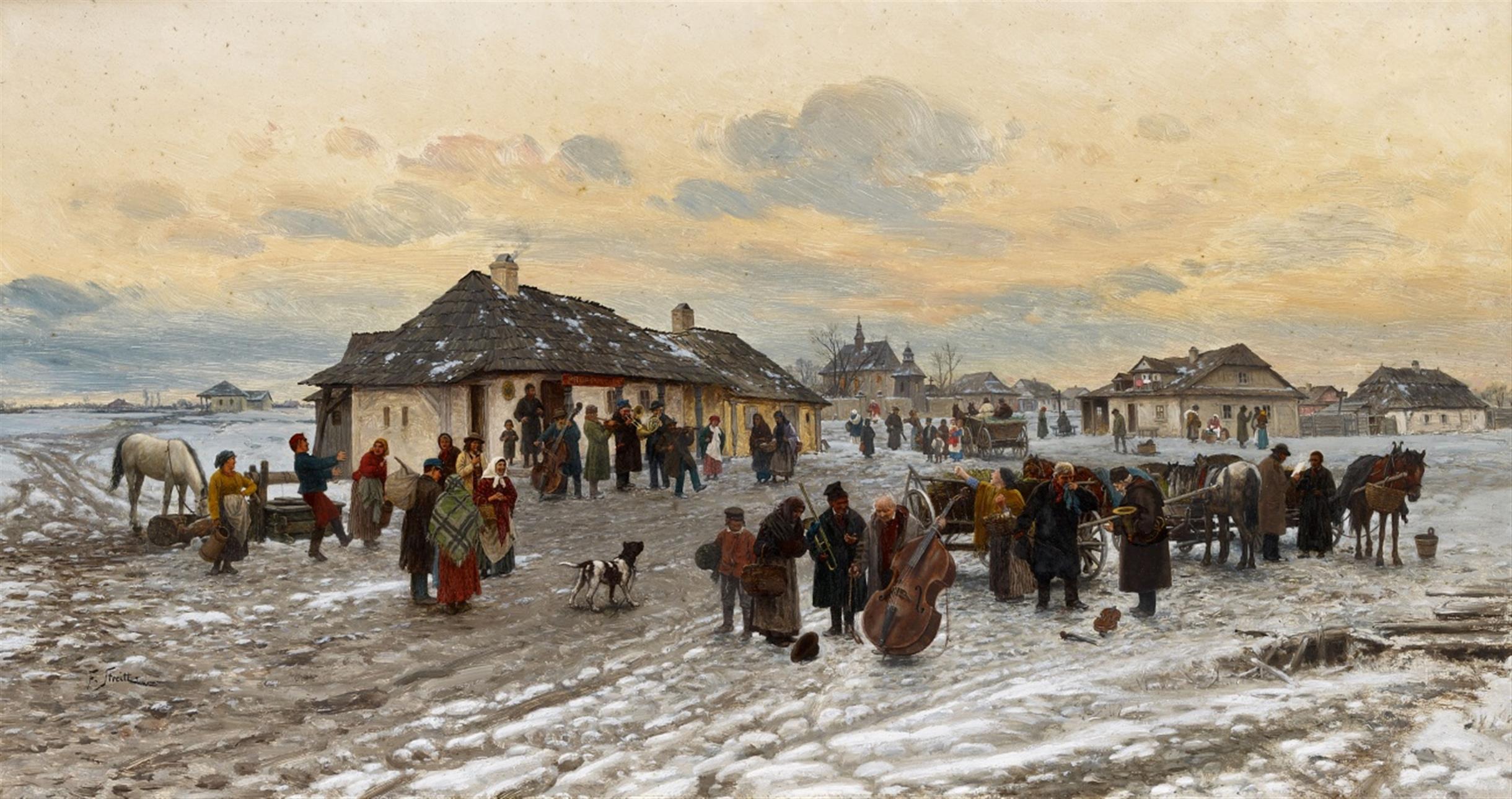
c. 1875—Franciszek Streitt’s oil painting, Dorfalltag (Everyday Village Life), includes a trombonist (see center of below image; public domain).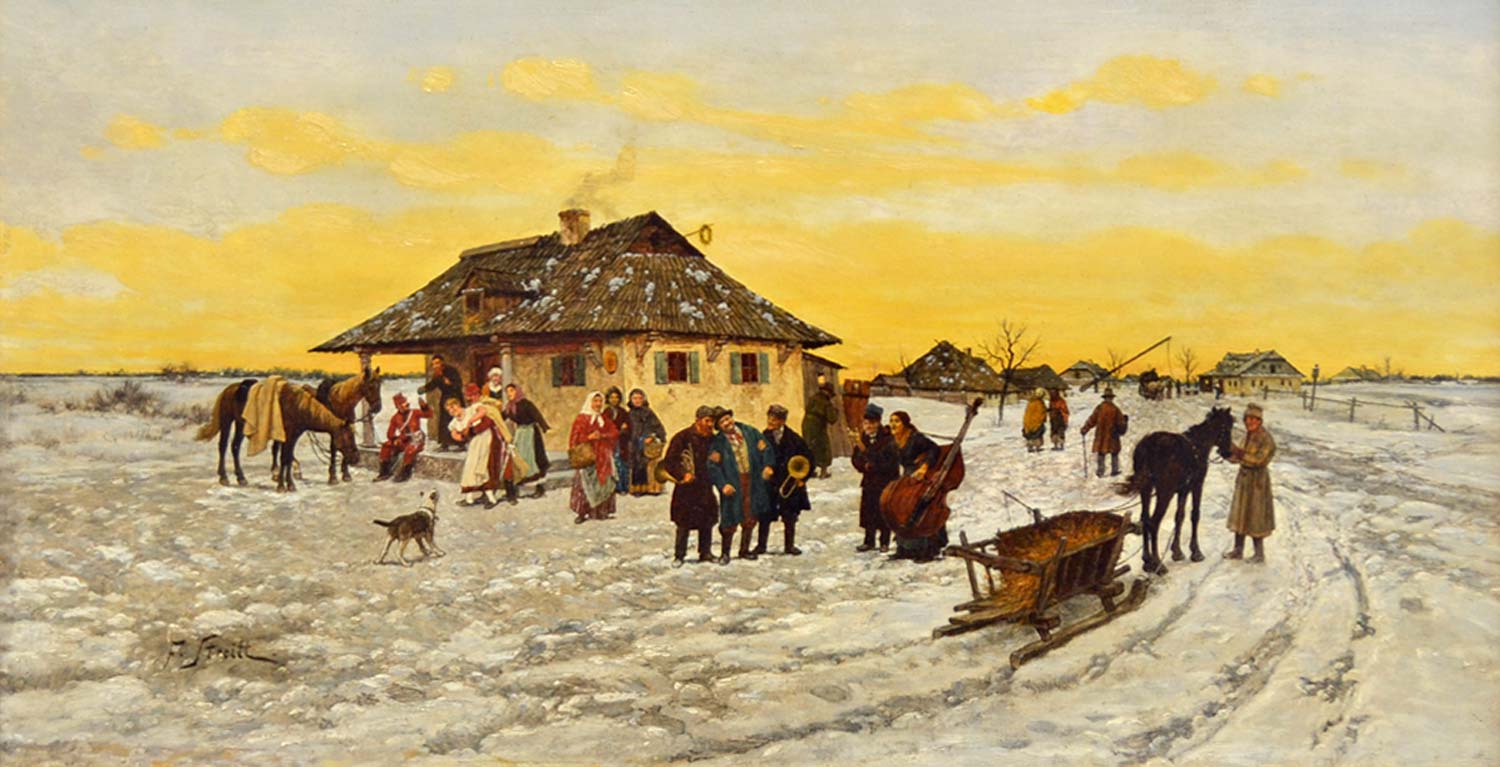
c. 1875—Munich, Germany: Polish artist Franciszek Streitt’s oil painting, Musicians in a Winter Landscape, includes a trombonist (see below image; public domain). A print after the painting with the caption “Am Wegweiser. Nach dem Oelgemälde von F. Streitt” is later published in 1882 (see second image below; public domain). Source: Wikimedia commons. 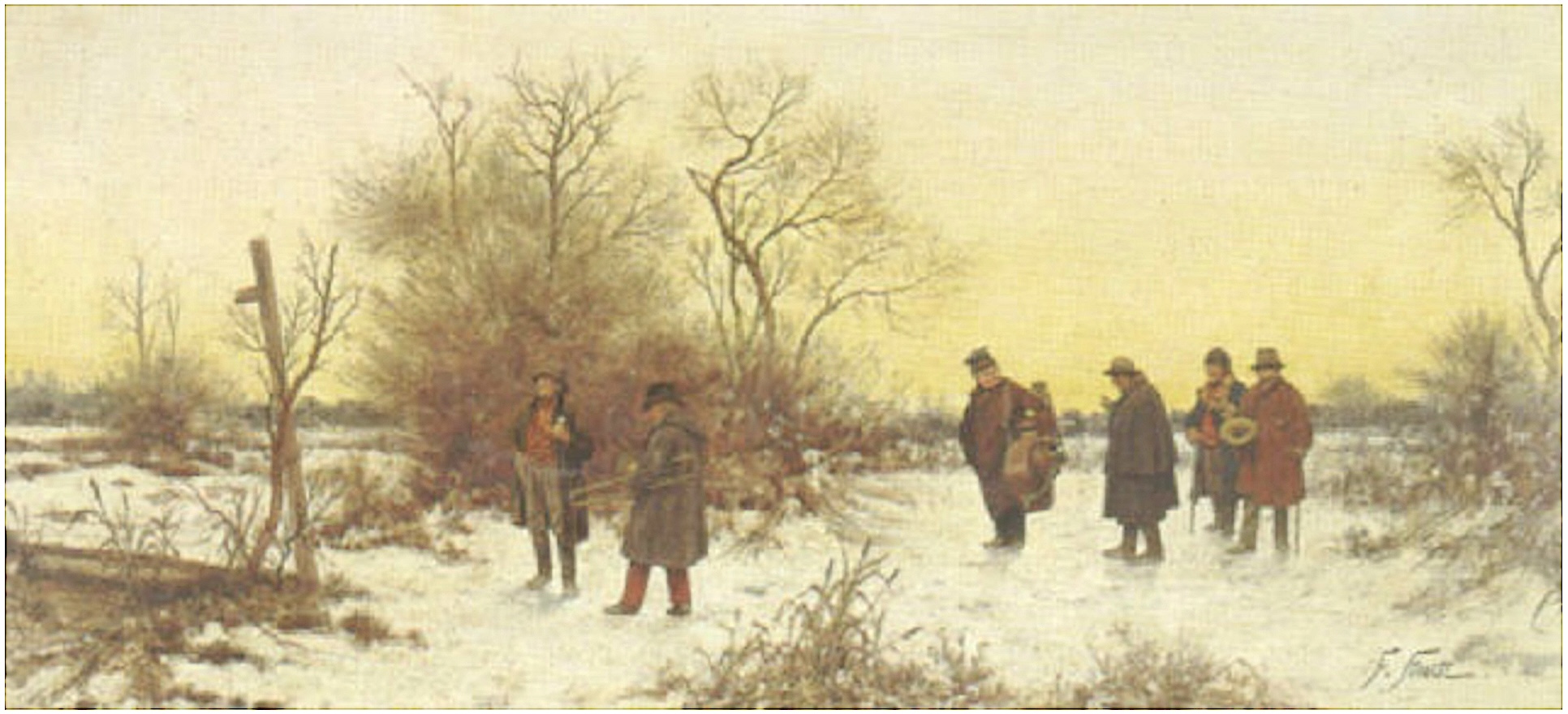
c. 1875—Munich, Germany: Polish artist Franciszek Streitt’s oil painting, One False Note, includes a trombonist (see below image; public domain). Source: artnet.com.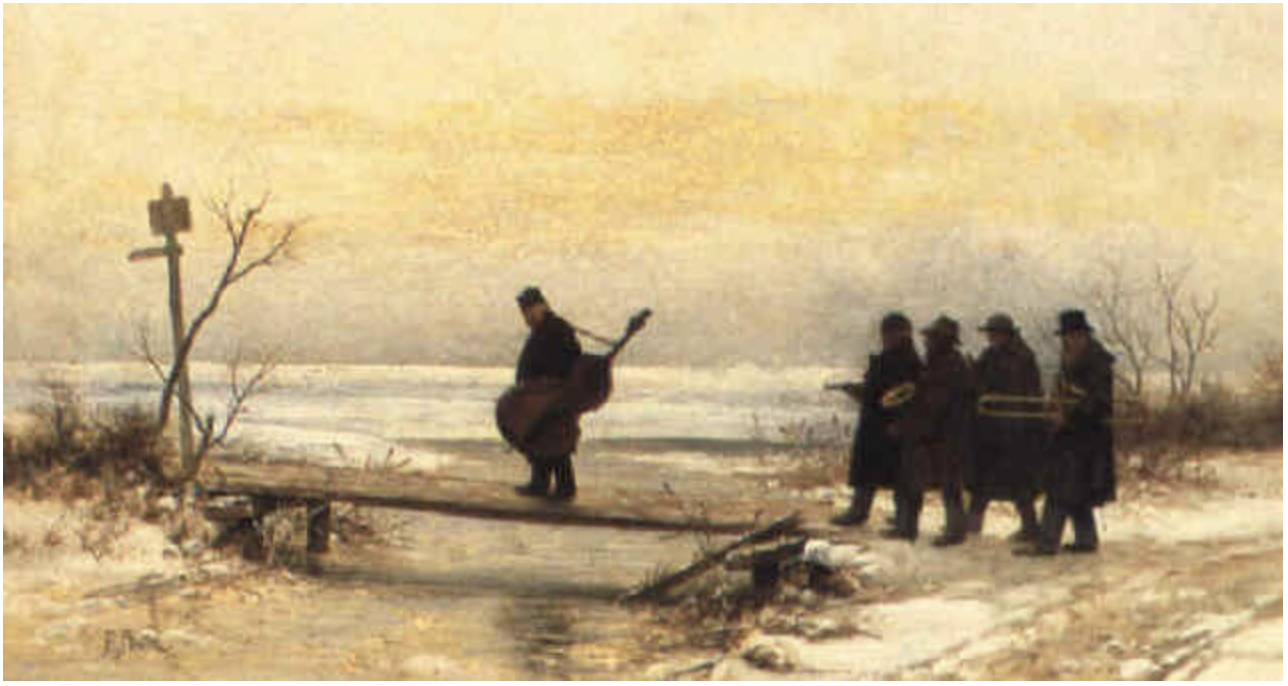
c. 1875—Munich, Germany: Polish artist Franciszek Streitt’s oil painting, Musikanten auf frostiger Landstrasse dahinziehend (Musicians on a Frosty Country Road), includes a trombonist (see below image; public domain). Source: artnet.com.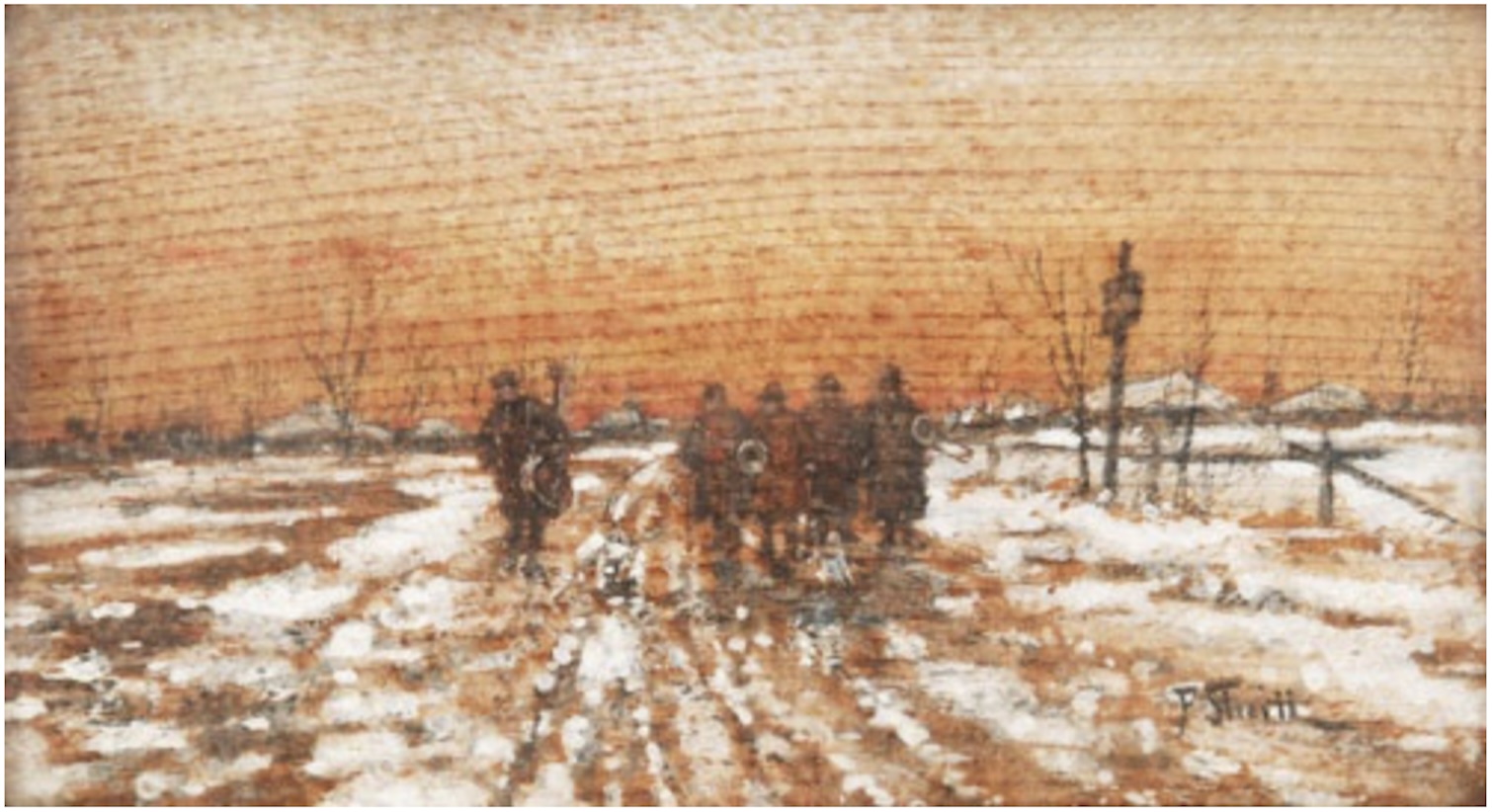
1875—Paris Conservatory morceau de concours: Jules Demersseman, Solo de concours.
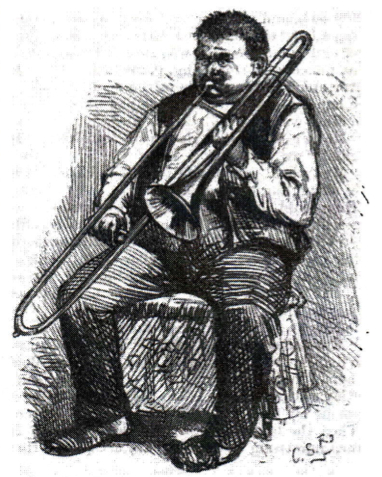
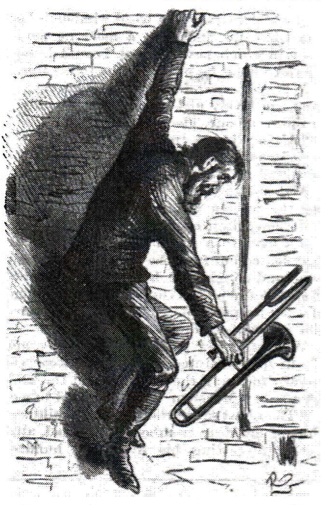 1875—New York: Harper’s Magazine publishes a humorous fictional piece, “The Story of a Trombone,” with illustrations by Charles Reinhardt. The story is about a man who lives below a French trombonist whose practicing has become an annoyance. “It is not to be endured,” the man complains to the landlord. “My rest is disturbed, my waking hours tortured, by this rasping fiend of a horn!” This complaining neighbor soon finds out, however, that the trombonist has an attractive daughter, and he is faced with the difficulty of putting aside his dislike for the trombonist’s playing in order to court the daughter (who, of course, is soon to join a convent). The conflict comes to a head when a fire threatens to destroy the apartment building and the daughter sends the suitor to rescue her father. After saving the father, the suitor is forced back into the flames to rescue the trombone (“I will not leave it to perish,” the father cries; “My dear trombone!”). In his escape after reclaiming the trombone, the suitor is ultimately saved by the instrument, the slide of which he bends in order to assist in scaling the wall of the burning building. The trombone is easily repaired, the father gladly gives his daughter’s hand, and they all live happily ever after. The captions to the illustrations read, “The cheeks of Monsieur Rigaud became like huge balloons” (upper-left image) and “Then I sprang over the yawning chasm” (upper-right image) (public domain) (Harper’s New Monthly Magazine, Vol. 51, No. 302 [July 1875], 225-230).
1875—New York: Harper’s Magazine publishes a humorous fictional piece, “The Story of a Trombone,” with illustrations by Charles Reinhardt. The story is about a man who lives below a French trombonist whose practicing has become an annoyance. “It is not to be endured,” the man complains to the landlord. “My rest is disturbed, my waking hours tortured, by this rasping fiend of a horn!” This complaining neighbor soon finds out, however, that the trombonist has an attractive daughter, and he is faced with the difficulty of putting aside his dislike for the trombonist’s playing in order to court the daughter (who, of course, is soon to join a convent). The conflict comes to a head when a fire threatens to destroy the apartment building and the daughter sends the suitor to rescue her father. After saving the father, the suitor is forced back into the flames to rescue the trombone (“I will not leave it to perish,” the father cries; “My dear trombone!”). In his escape after reclaiming the trombone, the suitor is ultimately saved by the instrument, the slide of which he bends in order to assist in scaling the wall of the burning building. The trombone is easily repaired, the father gladly gives his daughter’s hand, and they all live happily ever after. The captions to the illustrations read, “The cheeks of Monsieur Rigaud became like huge balloons” (upper-left image) and “Then I sprang over the yawning chasm” (upper-right image) (public domain) (Harper’s New Monthly Magazine, Vol. 51, No. 302 [July 1875], 225-230).
1875—New York: Breaking up of Our Summer Concert, an engraving by F.S. Church, is published in Harper’s Weekly. The picture includes a rear-facing trombone among several other instruments (see below image; public domain).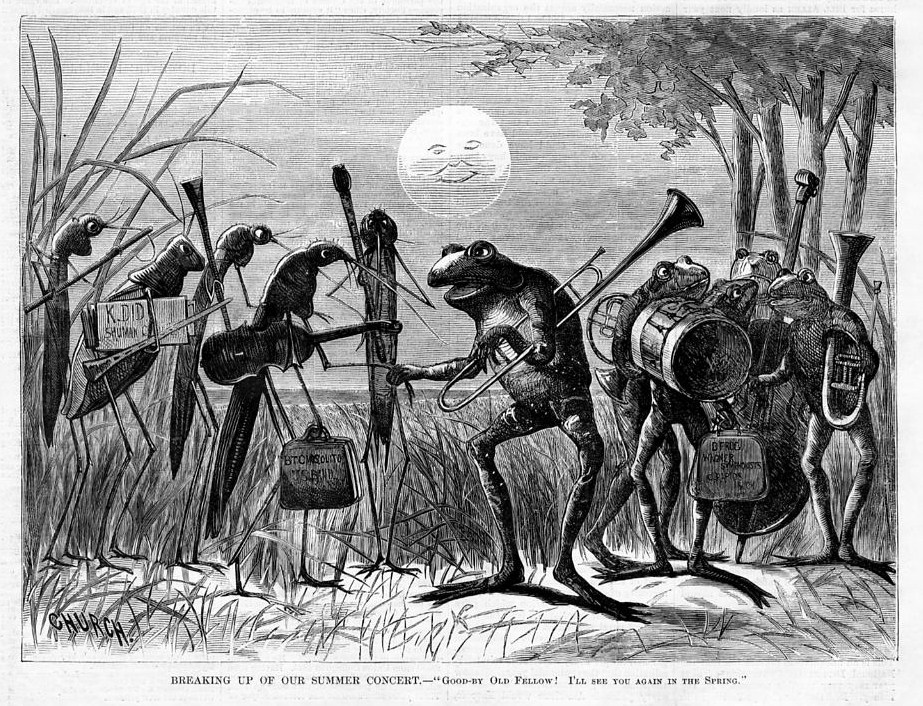
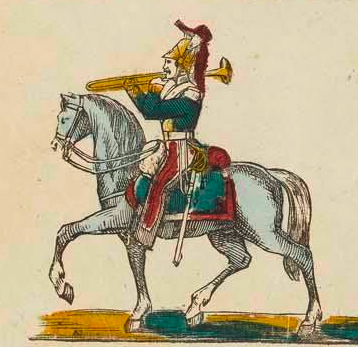 1875-1900—Epinal, France: An image published by Pellerin, entitled French Music (Dragoons), depicts a group of military musicians on horseback, including one playing a rear-facing trombone (see facing detail; public domain) (Museum of European and Mediterranean Civilization).
1875-1900—Epinal, France: An image published by Pellerin, entitled French Music (Dragoons), depicts a group of military musicians on horseback, including one playing a rear-facing trombone (see facing detail; public domain) (Museum of European and Mediterranean Civilization).
1876—Paris Conservatory morceau de concours: Jules Demersseman, 1er solo.
1876—Leipzig, Germany: Robert Müller performs the David Concertino at the Gewandhaus. The review in Allgemeine musikalischeZeitung says, “Mr. Müller is to be commended for the tasteful handling of his instrument, and will certainly be successful with every educated audience” (Lewis, Gewandhaus).
1876—Johannes Brahms, Symphony No. 1.
1876—Germany: Caricaturist Adolf Oberländer features a trombonist in one portion of his print, Das Orchester (see below detail; public domain) (Nuremberg, German National Museum).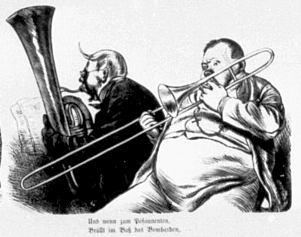
1876—Munich, Germany: Artist Franciszek Streitt’s oil painting, Wandering Town Musicians, portrays an interesting grouping of trombone, horn, violin, and double bass, traveling along an icy country road. The setting could be Germany or the artist’s native Poland countryside (see below image; public domain) (Posen, Museum Naradowe).
1876—A caricature by Solomon Eytinge and William Redding titled De Jubilee Am Come, featured in Harper’ Weekly, depicts a trombonist leading a procession of troops (see below image; public domain) (Harper’s Weekly 20, no. 1020, 15 July 1876).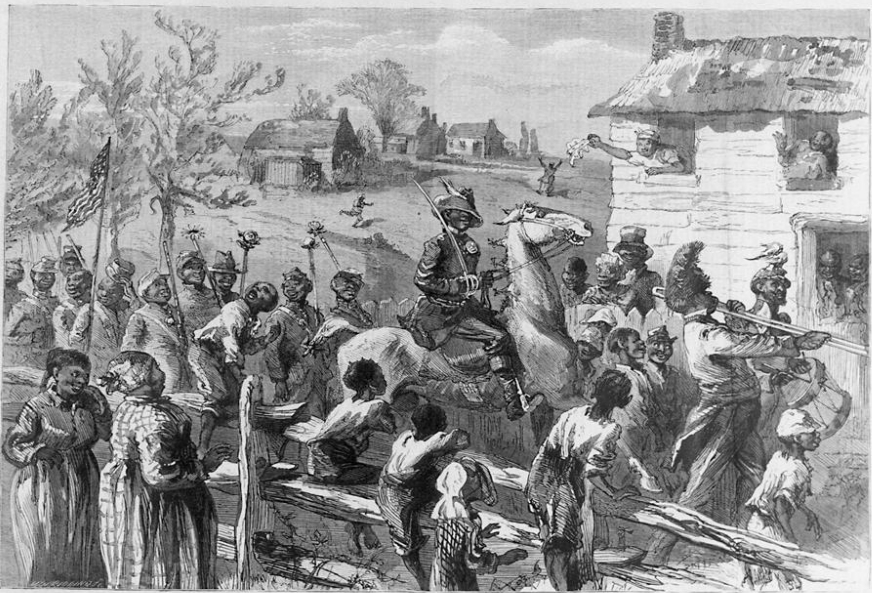
1877—Artist Jules Worms depicts an ensemble of musicians with animal heads for the cover the piano score of La Lutte Artistique (The Artistic Struggle), a quadrille by E. Marie. The trombonist has what appears to be the head of a rooster. The conductor, of course, is represented by a monkey (see below image; public domain) (source: Library of Congress).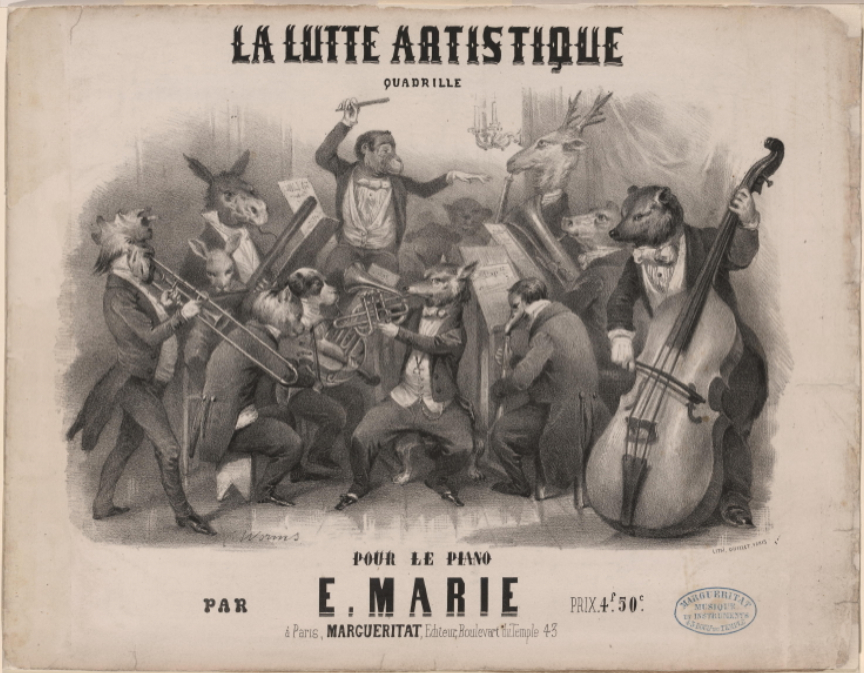
1877—Kronstadt, Russia: Nicolai Rimsky-Korsakov, Concerto for Trombone and Military Band. Written for the band concerts at Kronstadt, the imperial Russian navy base, while Rimsky-Korsakov is inspector of navy bands. Trombonist Leonov plays the first performance in 1878 with the composer conducting (Rimsky-Korsakov, My Musical Life 181).
1877—Spanish artist Jose Garcia y Ramos features a trombonist in his painting, After the Concert (see below image; public domain).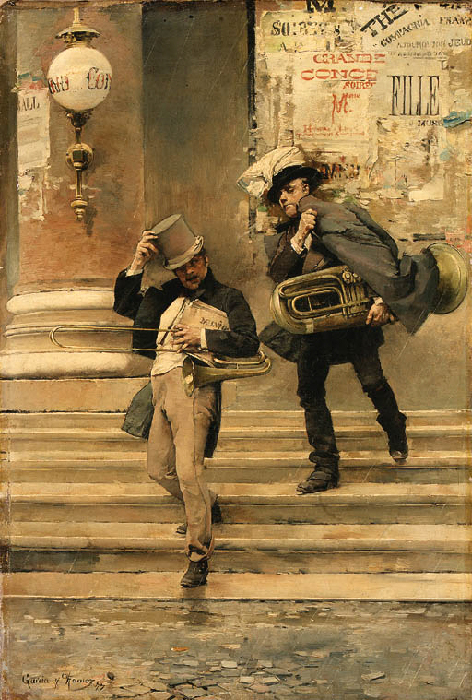
1877—Paris Conservatory morceau de concours: Jules Demersseman, Cavatine.
1877—Johannes Brahms, Symphony No. 2.
1878—Thoissey, France: A photograph of the Thoissey brass band, the band to which the famous French commander Jean Marchand belonged, includes at least 3 valve trombones. The photograph is later printed in the French illustrated newspaper, L’Illustration (see below image; public domain) (L’Illustration, June 3, 1899, p. 360).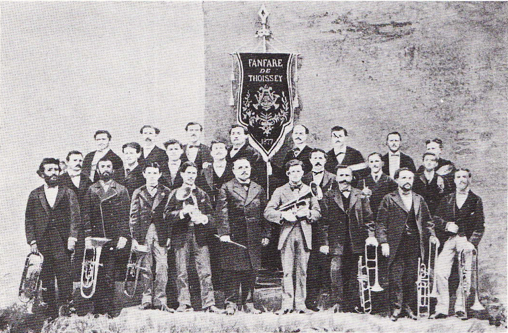
1878—Paris Conservatory morceau de concours: Jules Demersseman, Le Carnaval de Venice.
1878—England: The first Salvation Army band is formed, consisting of members of the Fry family: a father and 3 sons who play trombone, euphonium, and cornet (Whitwell, 19th Century 191).
c. 1878—Benjamin Vautier’s painting, Dancing Break at an Alsatian Wedding, features a small group of musicians, including a trombonist apparently emptying the water out of his horn (see below image; public domain). Click image to expand.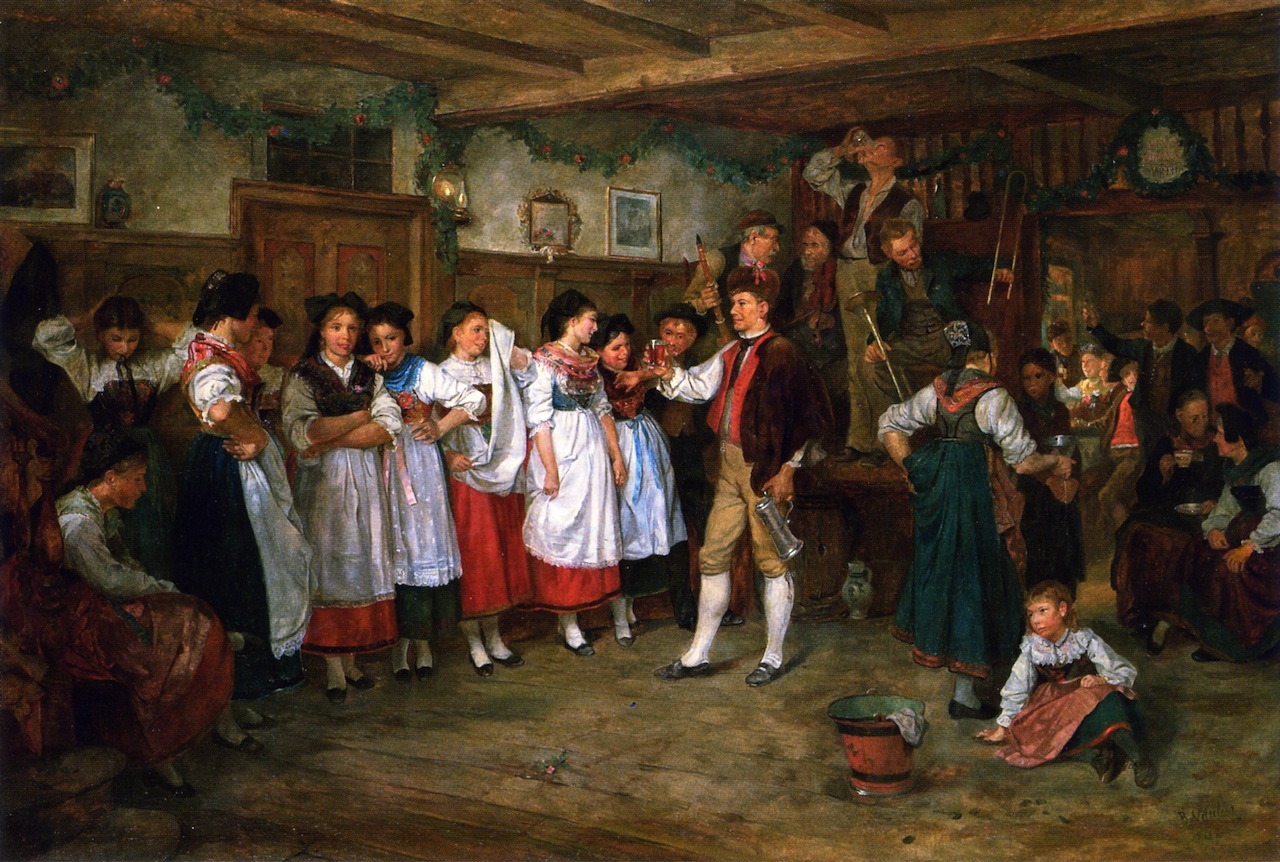
1878—Camille Saint-Saëns writes Requiem, op. 54, wherein the only brass utilized are 2 horns and an offstage trombone (Chase 289).
c. 1879—Munich, Germany: Polish artist Franciszek Streitt’s oil painting, Muzykanci (Musicians), includes a trombonist (see below image; public domain). Sources: mutualart.com, artnet.com.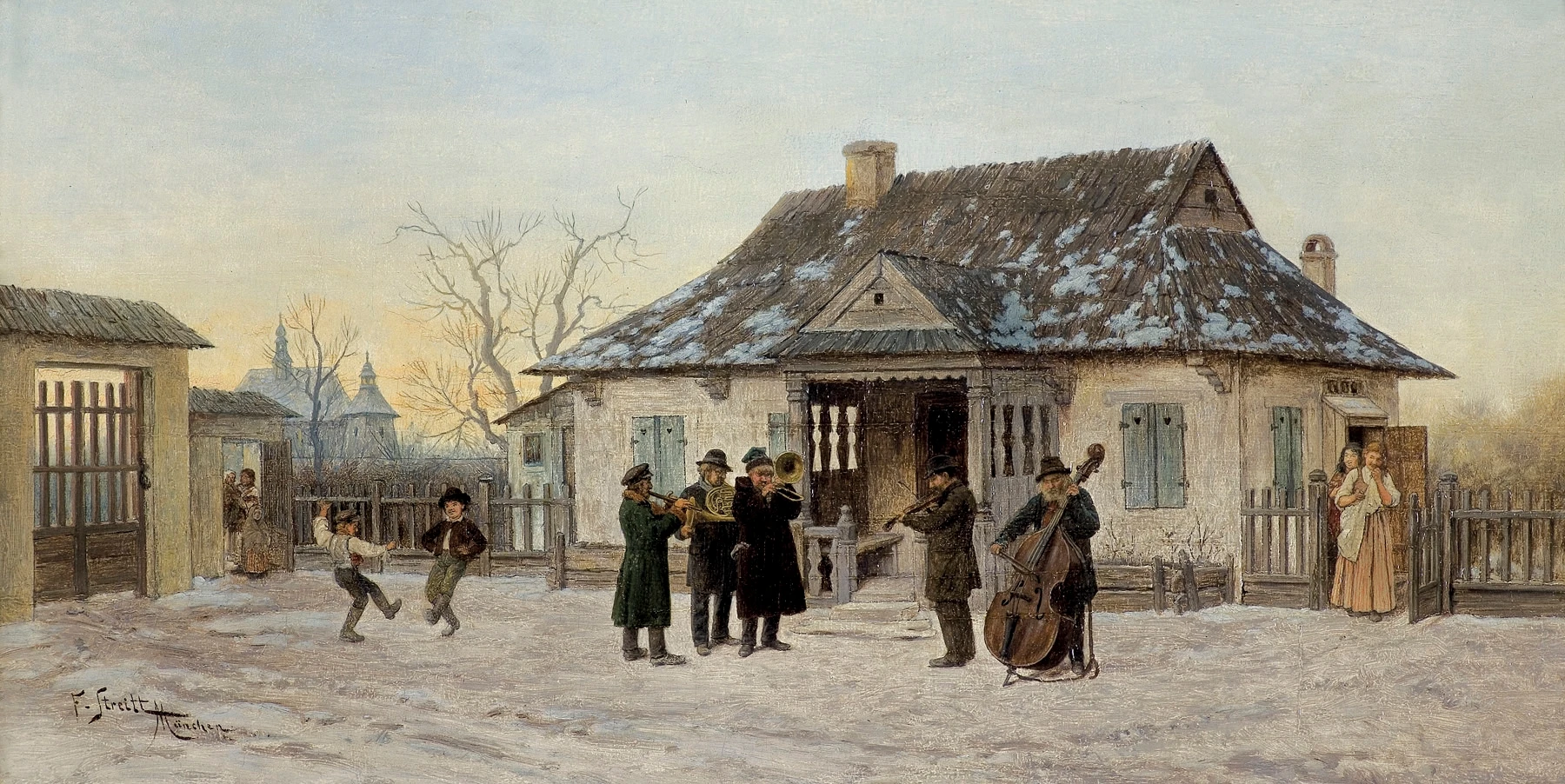
1879—Munich, Germany: Polish artist Francisz Streitt’s painting, Wędrowni muzykanci(Wandering Musicians), features a trombone player among 5 musicians (see below image; public domain).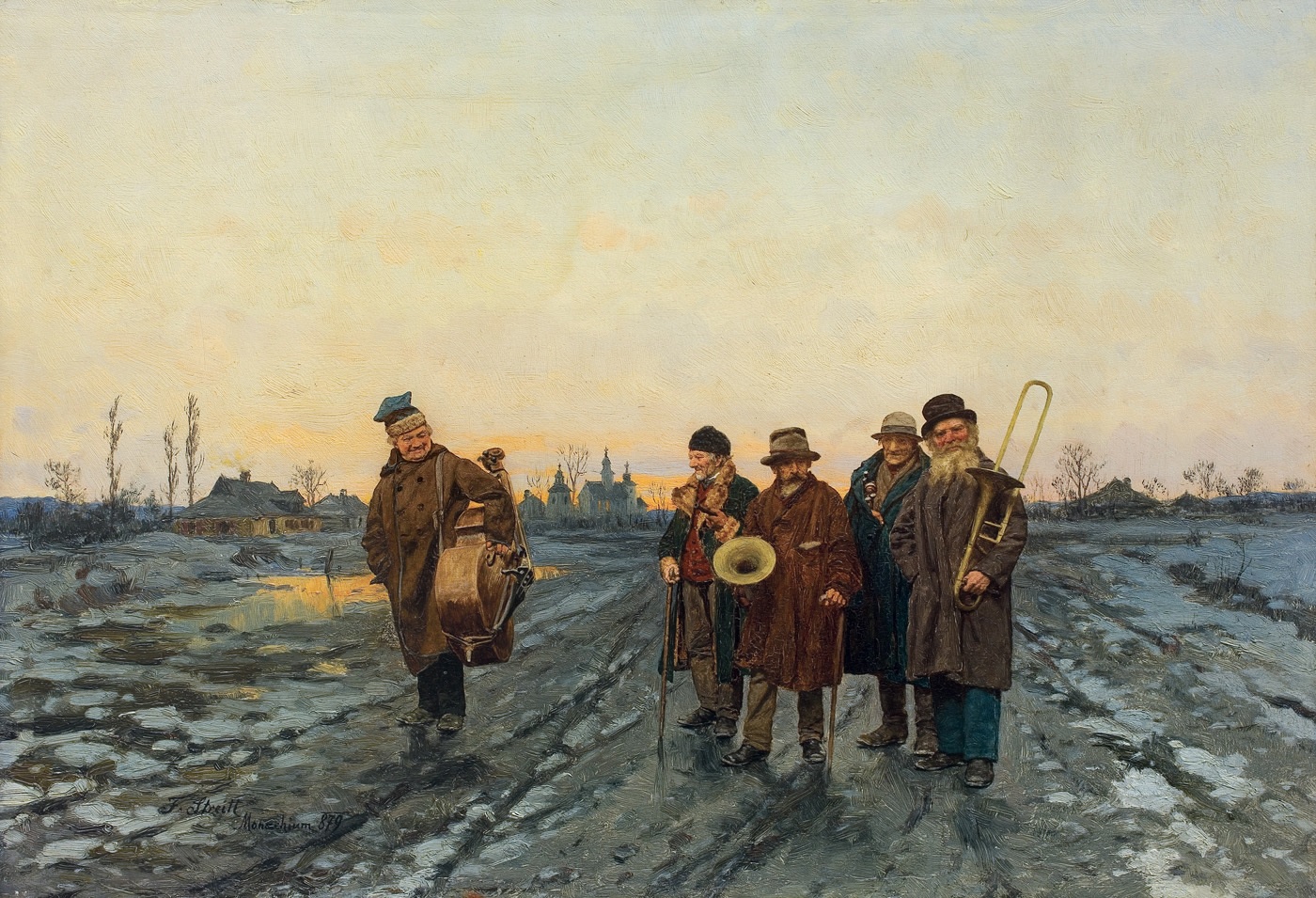
1879—Munich, Germany: Polish artist Franciszek Streitt,’s painting, Nowy rok—pozdrowienie poranne (New Year—Morning Greeting) includes a trombonist (see below image; public domain). Source: MutualArt. This painting has also been called Twilight Serenade in a version that is more yellow (see second image below). Source: Bamfords Auctioneers & Valuers.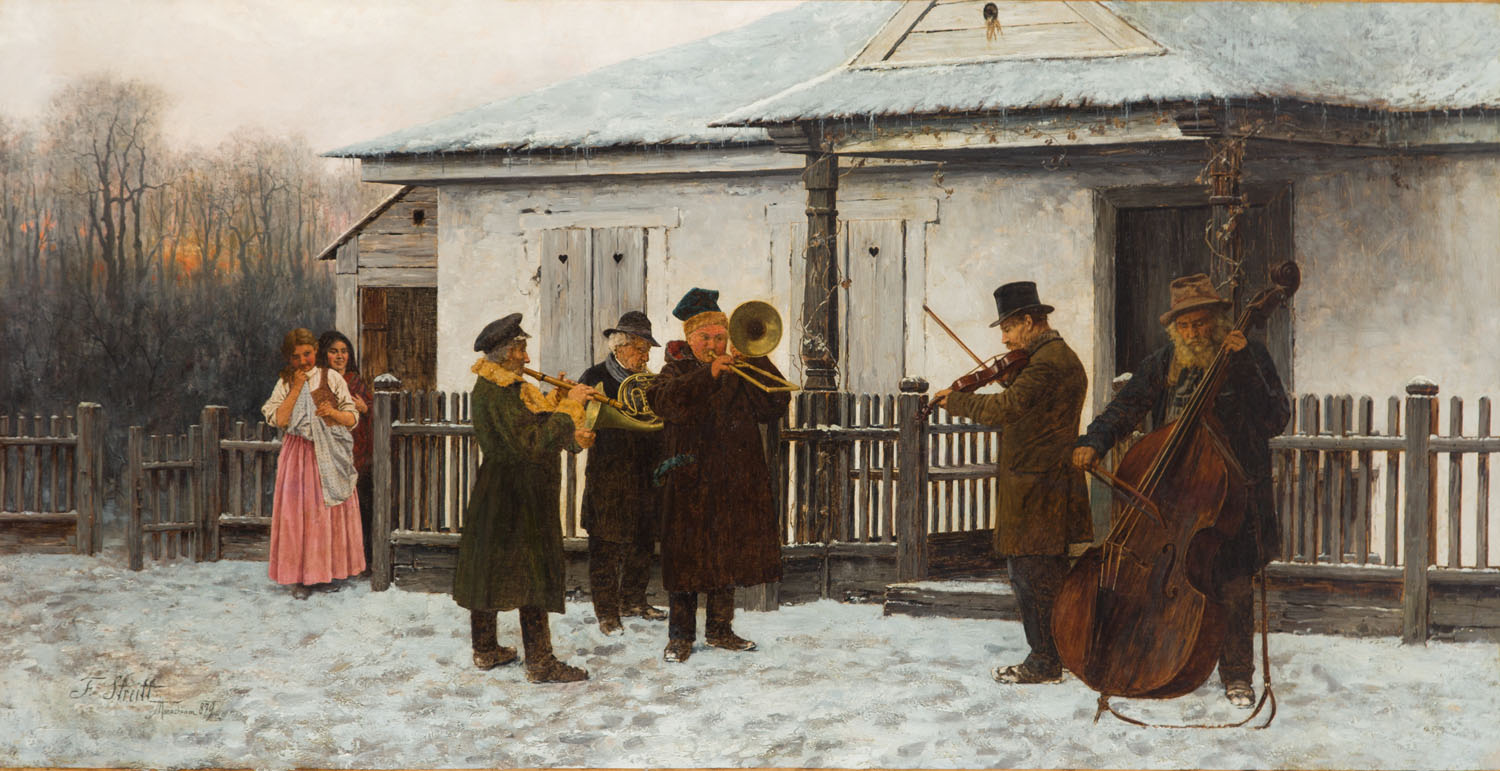
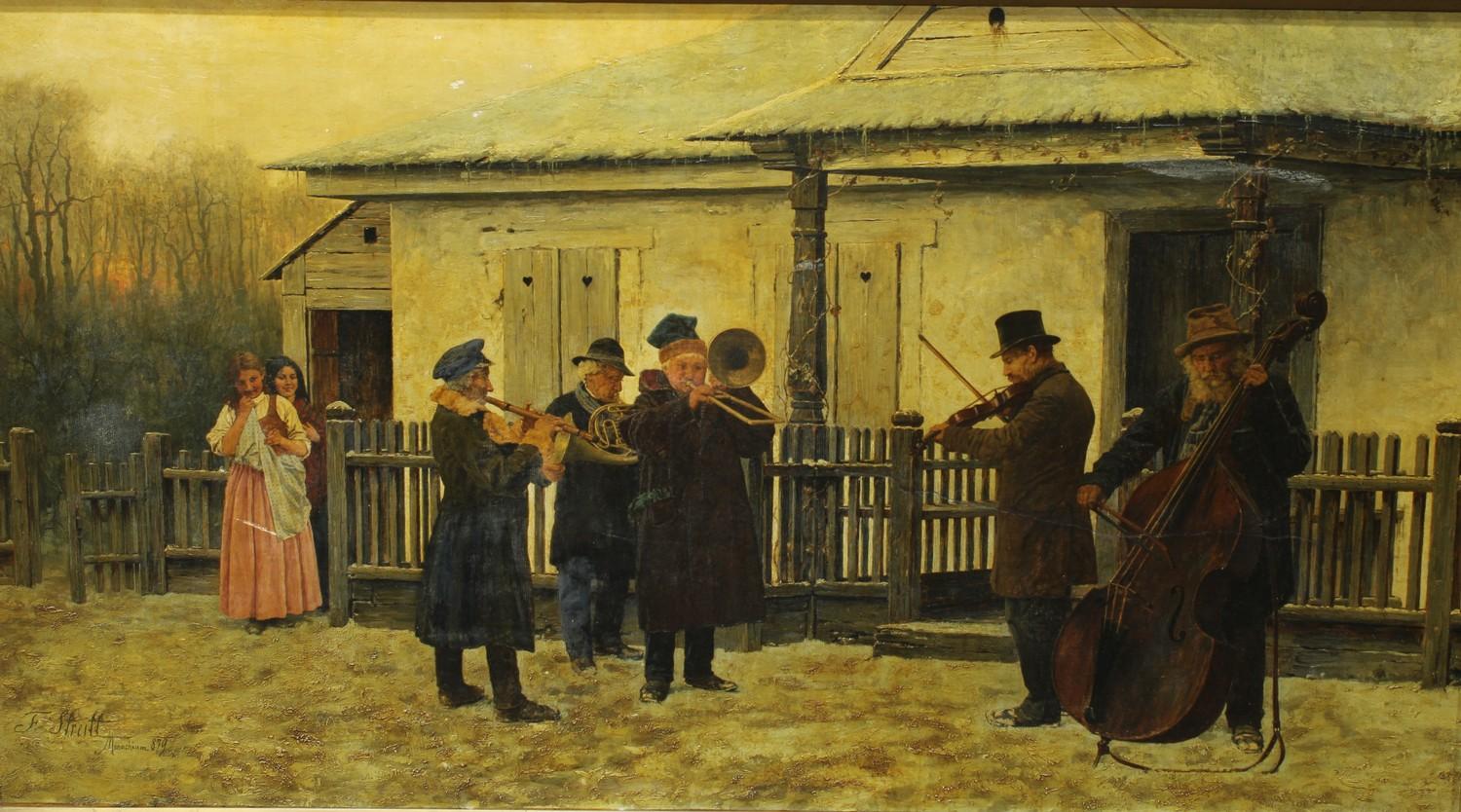
1879—Munich, Germany: Polish artist Franciszek Streitt’s painting, Musicians at a Crossroads, includes a trombonist (see below image; public domain). Source: MFABoston, collections.mfa.org.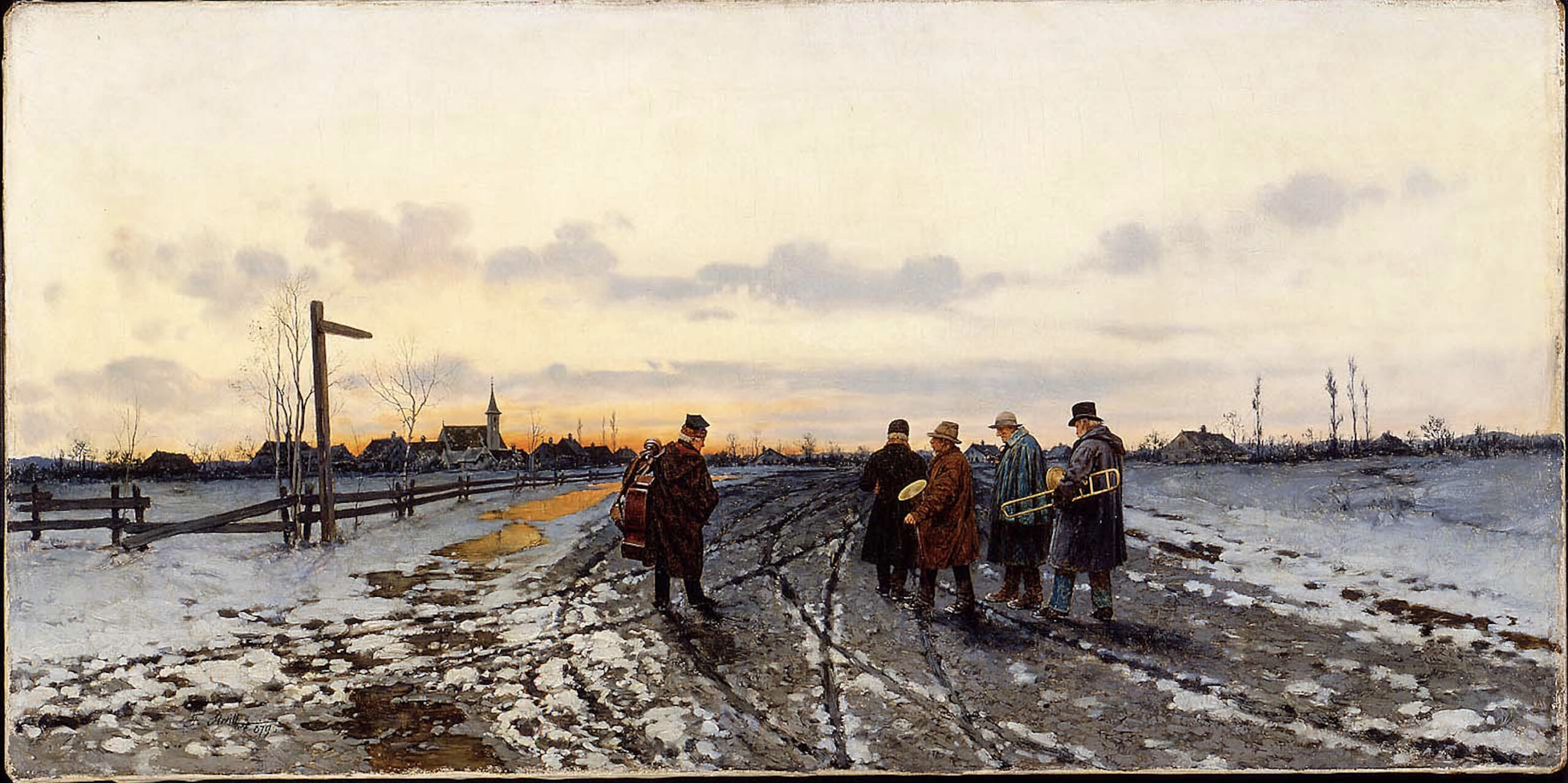
1879—New York: Harper’s Weekly publishes John George Brown’s engraving, The German Band, which includes a trombone playing in the back of a small band on the street (see facing image; public domain). The description reads, in part, “The painting from which our engraving is made is also a faithful study from the streets of New York. The German bands are becoming a feature here, and there can be no doubt in the minds of our citizens that, if we are to be compelled to listen to music whether we will or no, at almost any hour of the day or evening, the brass band is a great improvement on the Italian hand-organ. To say nothing of the superior strains of music to which they give expression, there is rarely any likelihood that more than one band will play on a single block at one and the same time, whereas three or four organ grinders may inflict their discordant airs at once upon our agonized and frenzied ears” (Harper’s Weekly, August 26, 1879, p. 325).
1879—Paris Conservatory morceau de concours: Jules Demersseman, Concerto (1er solo).
1879—New York: Harper’s Weekly magazine publishes an engraving titled “The Afghan War—The Fourth Goorkhas Marching through the Bazar, Jelalabad” that includes a trombone at the front of a military band (March 15, 1879, 208-209) (see below image; public domain). The 2nd Anglo-Afghan War is a conflict between British India and Afghanistan, and the Fourth Gurkhas is a regiment of the Indian army.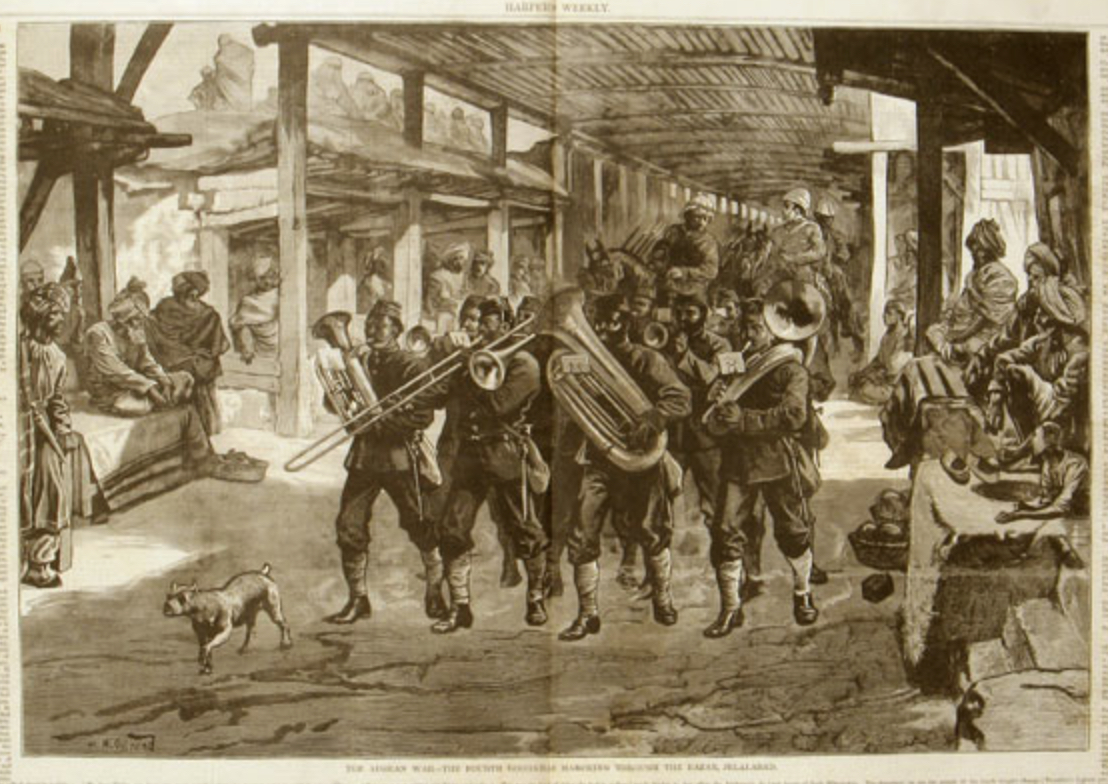
c. 1880—Wissembourg, France: A poster by publishing firm C. Burckardt advertising for a circus features a life-sized caricature of a trombonist (see below image; public domain).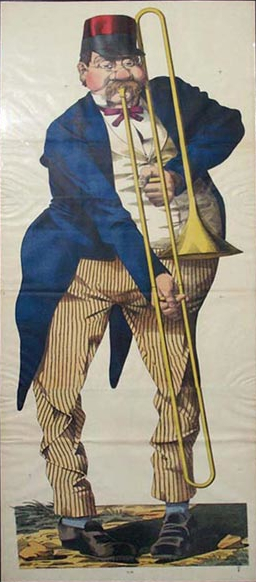
c. 1880—Vorstudium für den Pfingstchoral, an engraving after Th. Lederström, features an aproned trombonist (see below image; public domain).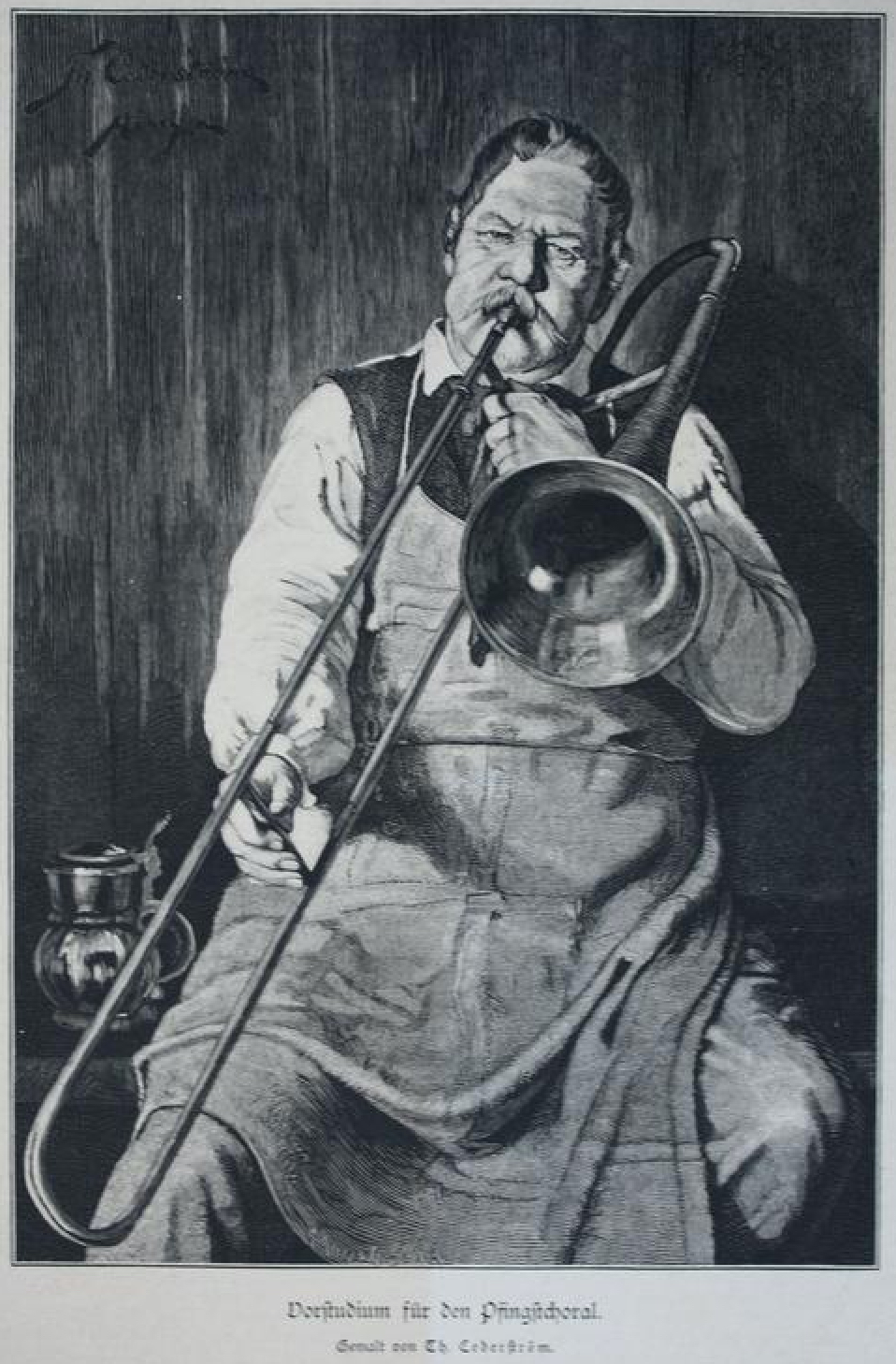
c. 1880—England: An artist from the English School creates a color lithograph of a frog playing trombone. The lithograph is subsequently made into a New Year card (see below image; public domain).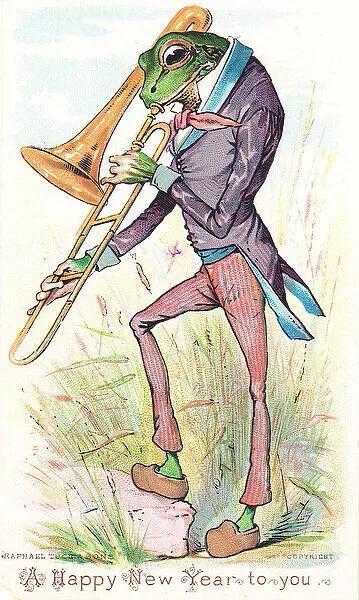
1880—Paris Conservatory morceau de concours: Jules Demersseman, Solo de concours.
1880—London-born trombonist Frederick Neil Innes, who had moved to Boston at the age of 20 become a popular soloist with Patrick Gilmore’s band, is called “the best trombone player in this country” in an interview given by Gilmore. In 1880-81 Innes tours Paris, Berlin, Hamburg, and St. Petersburg as a soloist. Several years later (1893), the Chicago Herald reports, “All the press of Europe combined in hailing him as the exemplar of a new school of playing this instrument (Guion, Four American).
1880—Germany: A pen and wash drawing by Hugo Kauffmann features a trombone in a wind ensemble setting (see below image; public domain).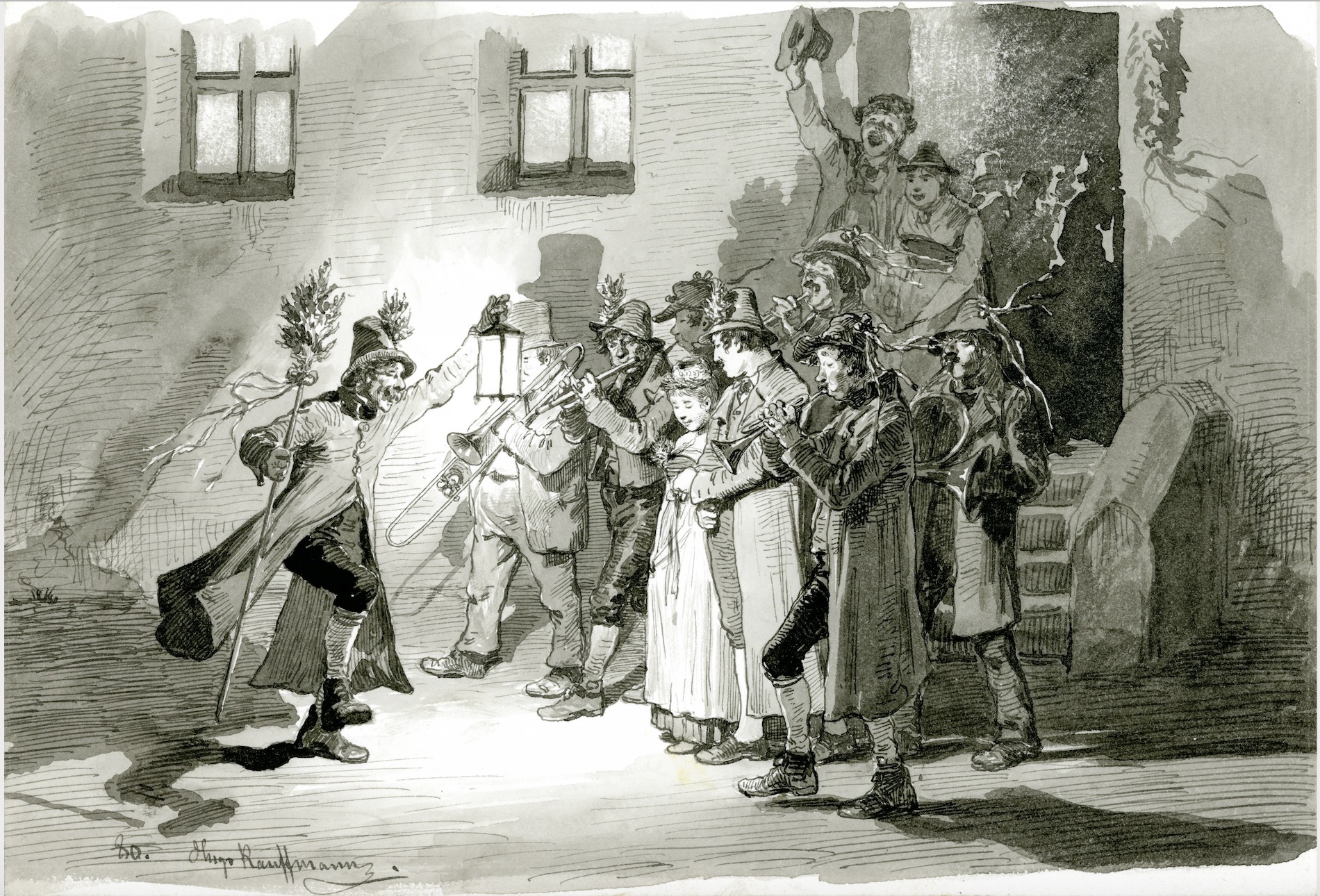
1880—Stuttgart, Germany: “Eine ziemlich lange Wurst,” a lithograph illustration in Märchengarten, Lustige Bilder und Geschichten für die Jugend, features a small band leading a very long sausage. The image is after a watercolor by Karl Offterdinger (see below image; public domain).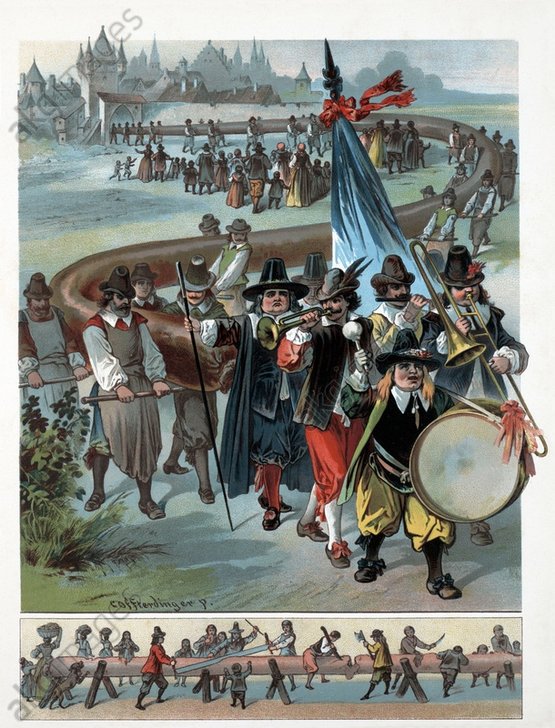
1880—Munich, Germany: Before this date, Polish artist Franciszek Streitt’s oil painting, Village Musicians on Tour, depicts 6 somewhat ragged winter travelers, including a trombonist with his horn aloft, apparently hailing another group of travelers (see below image; public domain).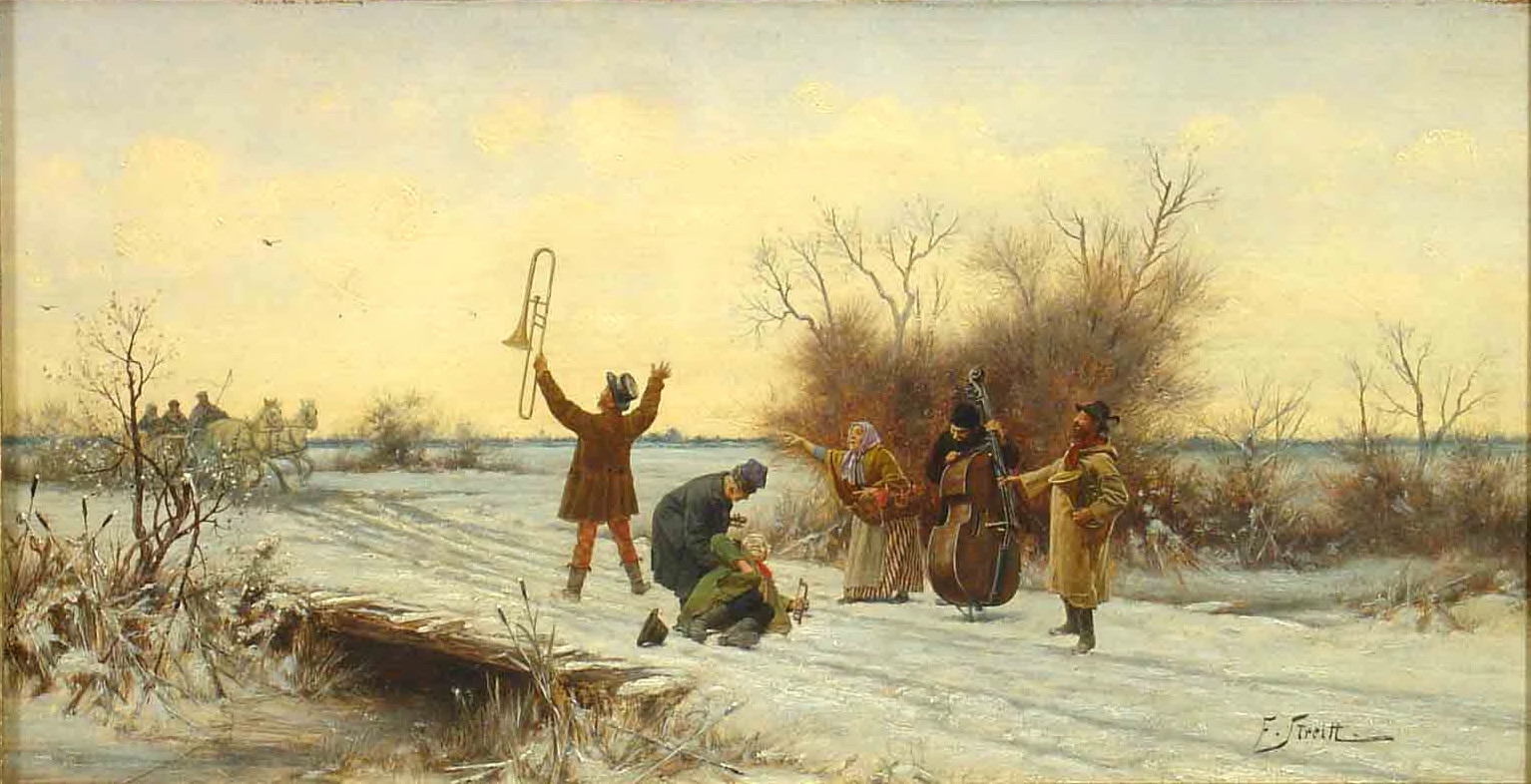
1880—Polish artist Franciszek Streitt’s sketch (pen, ink on paper), Muzykanci, perhaps a sketch for an unknown version of his country musicians, includes a rear-facing trombone (see below image; public domain; source: MutualArt).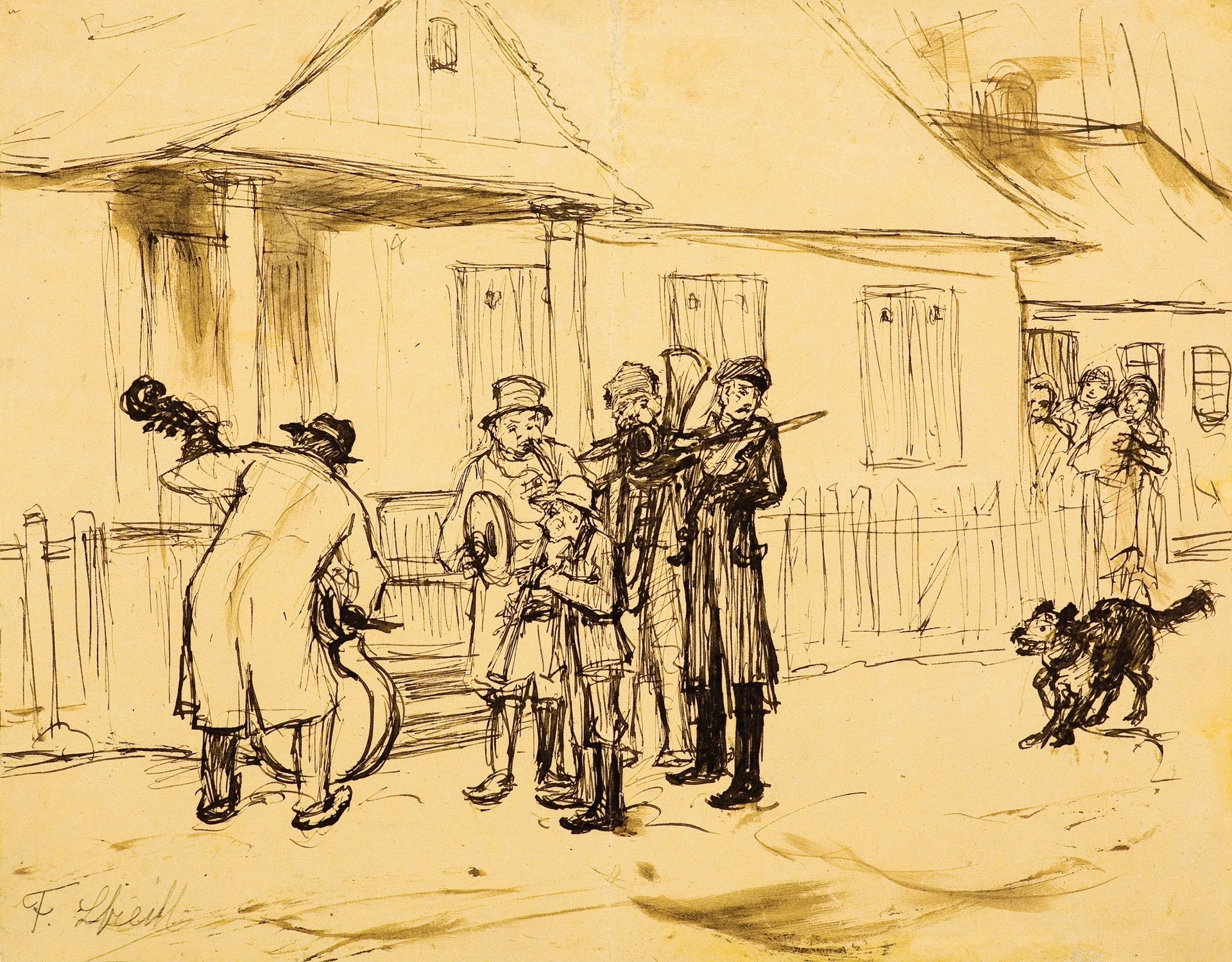
1880-1905—New York: A valve alto trombone with 3 Périnet valves is made by manufacturer Henry Pollmann (Heyde, Metropolitan).
1881—New York: A poster for Edmond Audran’s operetta, The Mascot (La Mascotte in the original), features a trombone player. The comic operetta, set in 17th century France, is a popular success in France, as well as, shortly thereafter, at New York’s Bijou Theatre and in Brighton, England (see below image; public domain) (source: Library of Congress).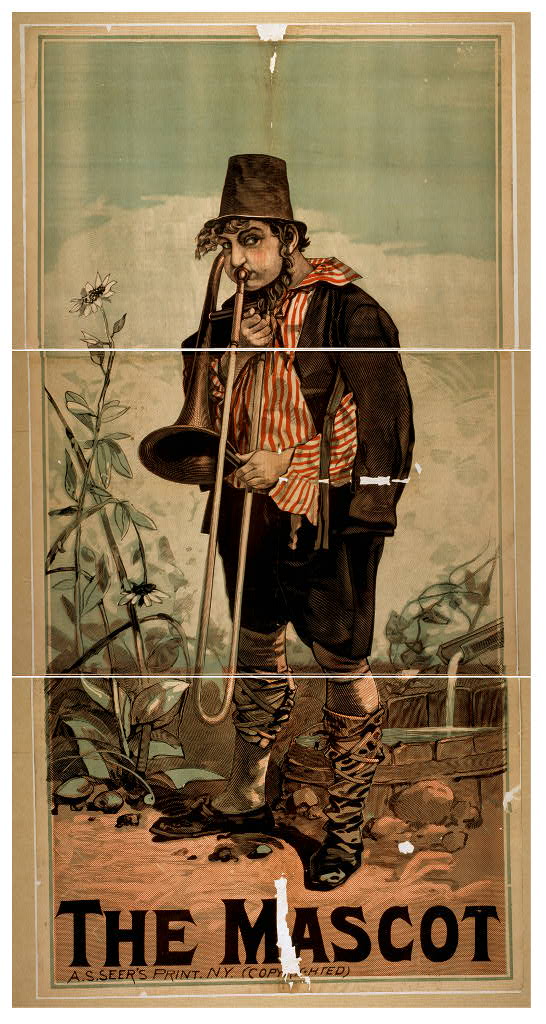
1881—Milan, Italy: The newspaper Gazzetta Musicale di Milano runs an article titled “Visit by Verdi to the Pelitti factory,” detailing Verdi’s interest in the contrabass trombone. It says, in part, “Verdi having, however, expressed certain wishes regarding the range of the trombone basso, Cav. Pelitti undertook to build a new one for the following Thursday which would satisfy the Maestro’s requirements. Verdi, accompanied by maestro Boito and signor Giulio Ricordi, went accordingly on that day to the Pelitti factory where repeated experiments were made with the new trombone in B flat pitched one octave lower than the tenor. The new instrument gave splendid results regarding range, timbre, sonority, power, ease and facility of execution, blending perfectly with the other trombones. Resulting from this, two B flat tenor trombones, a bass trombone in F and the new bass trombone in B flat are necessary in order to achieve a trombone quartet that is perfect, homogeneous and effective without bringing into the orchestra a timbre from the band that would affect the instrumental blending of the various instruments” (Meucci).
1881—Paris Conservatory morceau de concours: Georg Friedrich Haëndel, Air varié sur Machabée.
1881—Benjamin Vautier’s painting, Jahrmarkt, features a small group of musicians, including a trombonist, performing at a marketplace (see detail and full image below; public domain). Click full image to expand.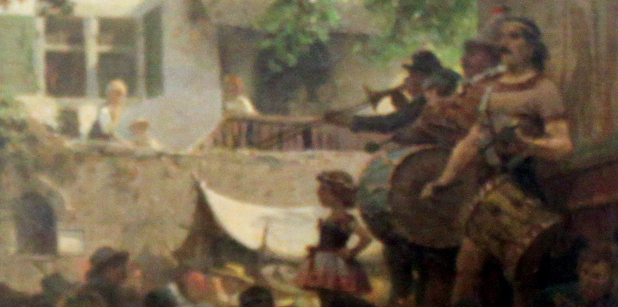
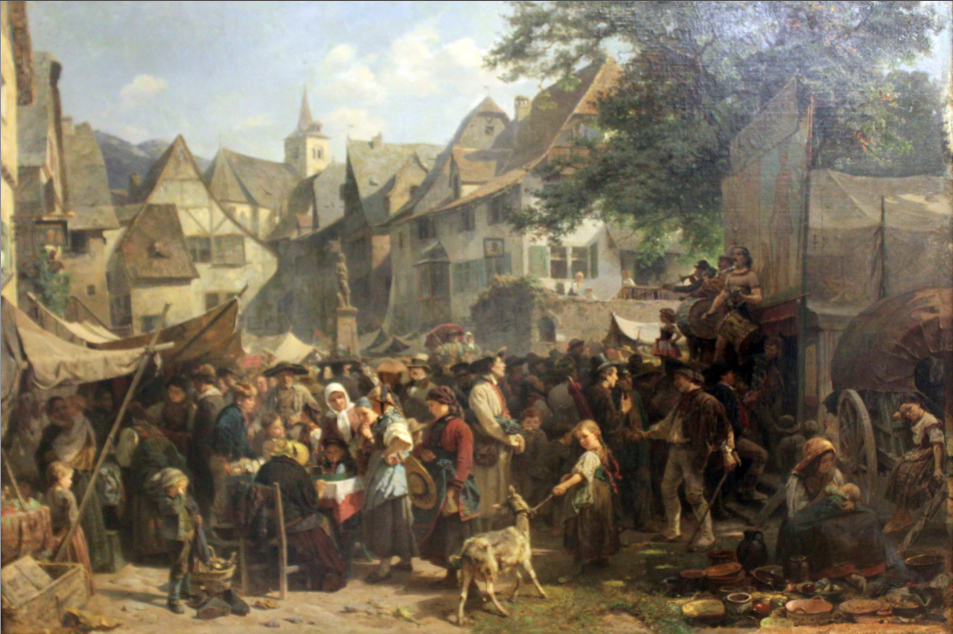
1881—New York: Harper’s Weekly publishes a print by illustrator Thurs de Thulstrup titled The Music Festival in the Seventh Regiment Armory. Depicted from a viewpoint of the back of the orchestra are what appear to be 2 trombone players (see below image; public domain).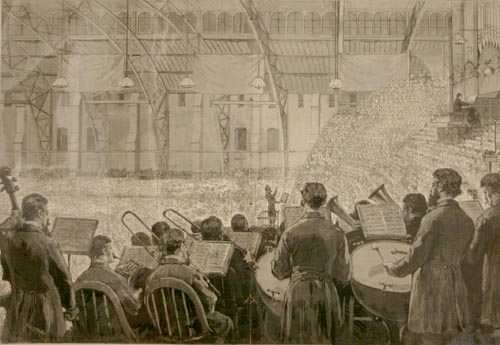
1881-1942—Russia: Vladislav Blazhevich, trombonist, composer, and pedagogue, writes numerous important method books and solo works for trombone. Methods include School for Slide Trombone (1925), 26 Sequences for Trombone (1946), Concert Duets for Two Trombones (1948), and Clef Studies for Trombone (1948).
1882—Germany: Artist Carl August Wilhelm Zimmer (1853-1937) depicts a trombonist among a group of brass musicians in the painting The Bowling Champion (see below image; click to expand; public domain) (source: wikimedia commons). For another painting by the same artist that includes trombone in an outdoor setting, see The Orchestra, Biergarten, below (c. 1900).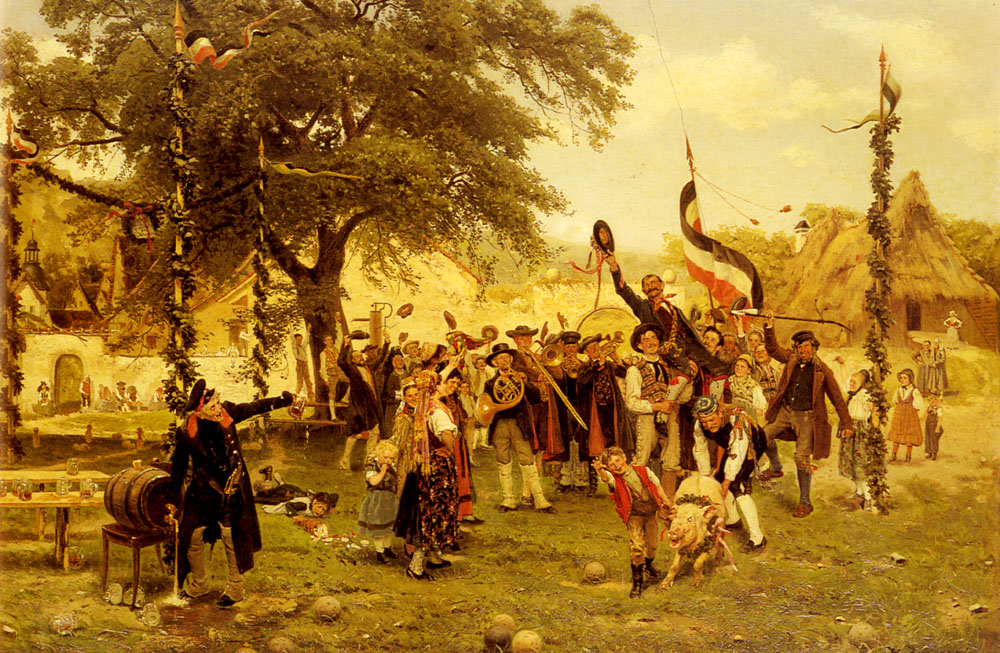
1882—Paris Conservatory morceau de concours: Jules Demersseman, Solo de concours.
1882—Raleigh, North Carolina: Dodworth of New York advertises several instruments for sale, including an alto trombone in E-flat (Raleigh News and Observer).
1882—Poem appearing in the publication Music includes the following derogatory stanza about trombone: “The trombonist when playing looks savage and severe; He loves the works of Wagner and the scores of Meyerbeer; He loves the drums and trumpets; his head is always bent; He has lots of execution and little sentiment” (Slonimsky 304).
c. 1883—Paris, France: Jean Beraud’s painting, The Box by the Stalls, offers a view, through a patron’s box seat, of a Parisian orchestra. Included is a clear depiction of a trombone (see below image; public domain).
1883—Pitanguy, Brazil: Englishman Hastings Charles Dent visits church near town of Pitanguy in Minas Gerais, Brazil, and is entertained with music that includes “guitar, trombone and concertina.” He asks the priest “why they had no sacred music, only dance music in church; he said the people were not educated up to it yet, but he hoped in time to introduce it.”
1883—Cincinnati, Ohio: Oscar Coon publishes his text, Harmony and Instrumentation, and says the following about the trombone in the orchestra: “In this country, the Alto and Bass are seldom seen, and the three Trombone parts are played on Tenor Trombones….The prevailing fashion of getting as much noise as possible from a few instruments seems to sanction this abuse of one of the noblest instruments in the orchestra” (Coon 73).
1883—Cincinnati, Ohio: Oscar Coon publishes his text, Harmony and Instrumentation, which says the following about trombones in military bands: “Slide trombones in the full Military Band should not be treated like the E-flat Tenors in a Brass Band. They are to be held in reserve for the strong, sonorous chords, and for the heavy, crashing effects of the grand climax. It is not to be inferred from this that they are out of poace in piano passages. On the contrary, most beautiful effects can be obtained from Trombones played pianissimo” (Coon 238).
1883—Paris Conservatory morceau de concours: Jules Demersseman, 3e solo.
1883—Royal Waits Outside Marlborough House (London residence of the Prince of Wales), a caricature by an unidentified artist, includes a trombonist playing with a small group of musicians in the cold (see below image; public domain).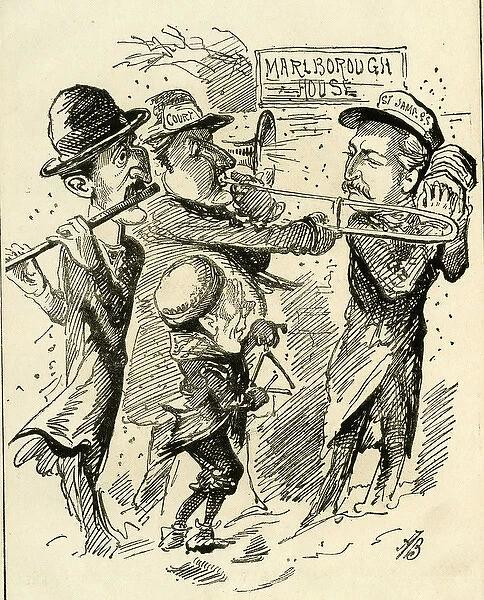
1883—Munich, Germany: Thurmbläser, a print by Carl Schultheiss, features a group of trumpets and trombones performing from a tower (see below image; public domain) (Illustrirter Katalog der internationalen Kunstausstellung im Königl, September 1883).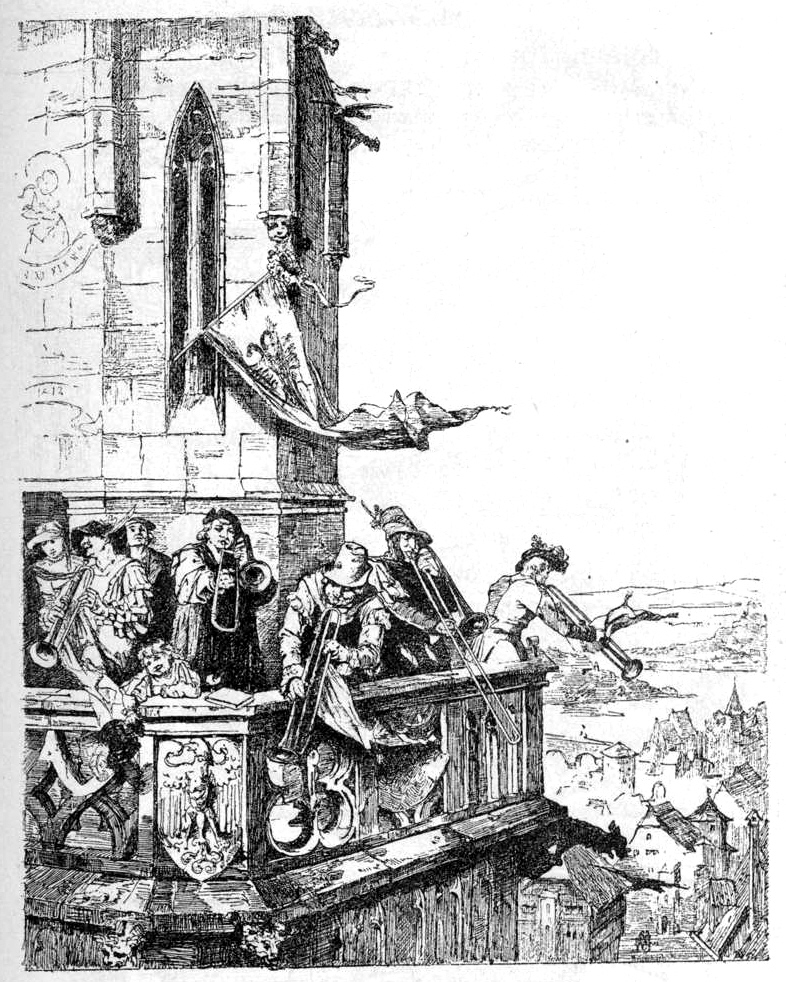
1883—London, England: The Musical Standard, a wide-ranging British musical periodical with a publication run of 72 years (1862-1933), publishes the following as part of an unsigned review of the Leeds Festival: “The constitution of the Leeds orchestra for large choral works has proved as before to be a satisfactory one; and generally it is that adopted at Birmingham, with the wood wind doubled. Sir M. Costa’s first experiment included the doubling of the brass as well, but experience proved this to be unnecessary, so the brass remains the same as usual, save that two trumpets and two cornets are secured to form the upper group. Sir Arthur Sullivan deserves to be complimented upon his efforts to secure the proper trio of alto, tenor, and bass trombones. The French custom of using three in B flat, and the usual plan in England of employing two tenors and one bass, are not altogether satisfactory. The bass trombone in G is necessary to do justice to the lower notes below F, and the alto is equally necessary for the proper sustentation of the upper part, for the tenor cannot produce with effect the high B natural, C, etc., which appear in the scores of the great masters, as in ‘Elijah’” (emphasis added; Leeds Festival 240).
1883—Johannes Brahms calls for 3 trombones in his Symphony No. 3.
1883—New York: The Great Rival Advertising Shows to “Boom Up” Stocks, a print by Bernhard Gillam, is published in Puck (v. 14, no. 339). It shows three advertising sideshows, one of them represented by a man playing a rear-facing trombone (see below image; public domain).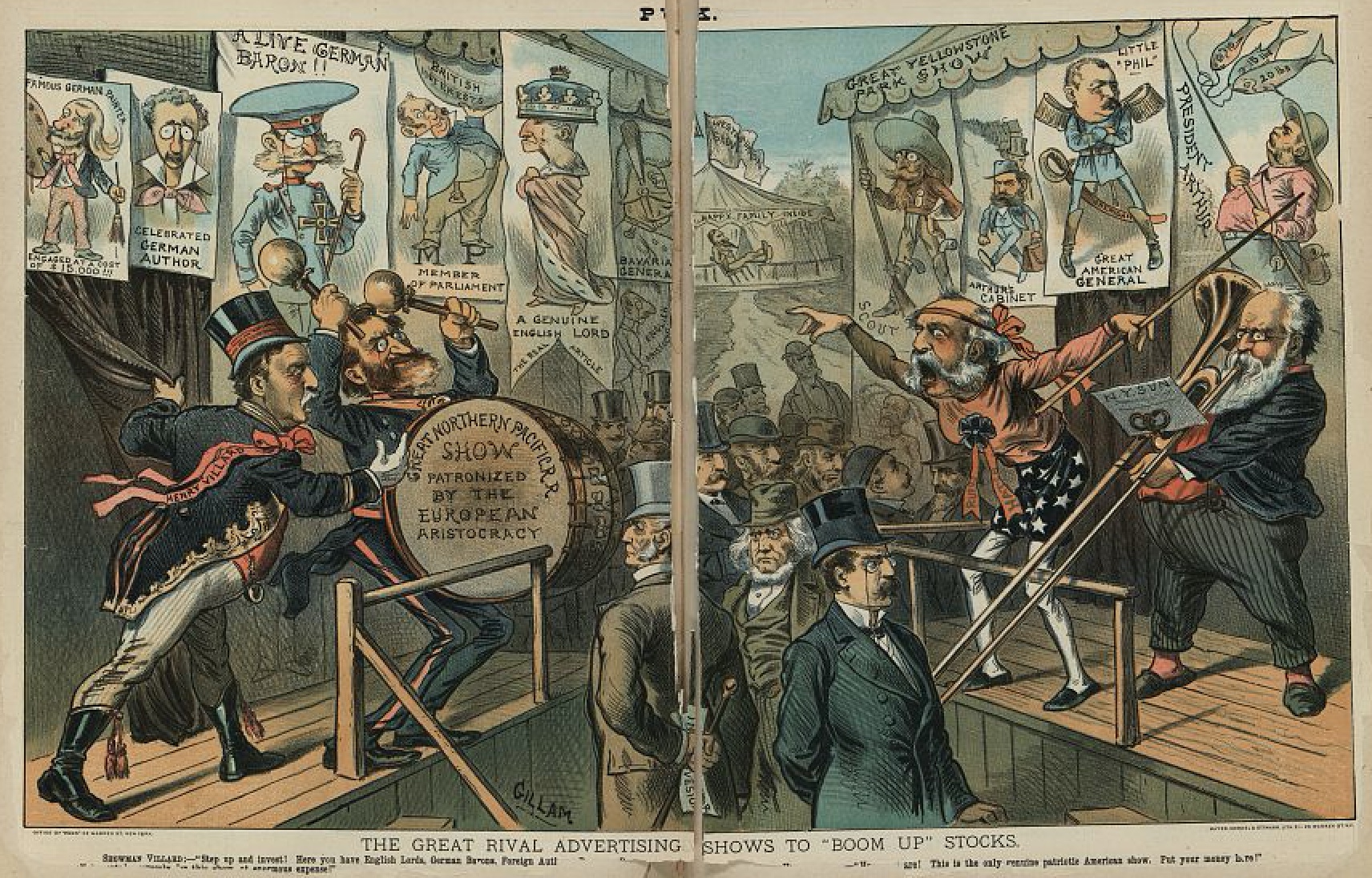
1884—Paris, France: A print from G. Bruno’s Le tour de la France, depicting the principal musical instruments of the time, includes a rear-facing trombone (see below image; public domain) (Bruno 53).
1884—Paris, France: Gustave Chouquet’s catalog of holdings of the Paris Conservatory includes a print of a buccin, or trombone with dragon-head bell (see below image; public domain) (Chouquet 161).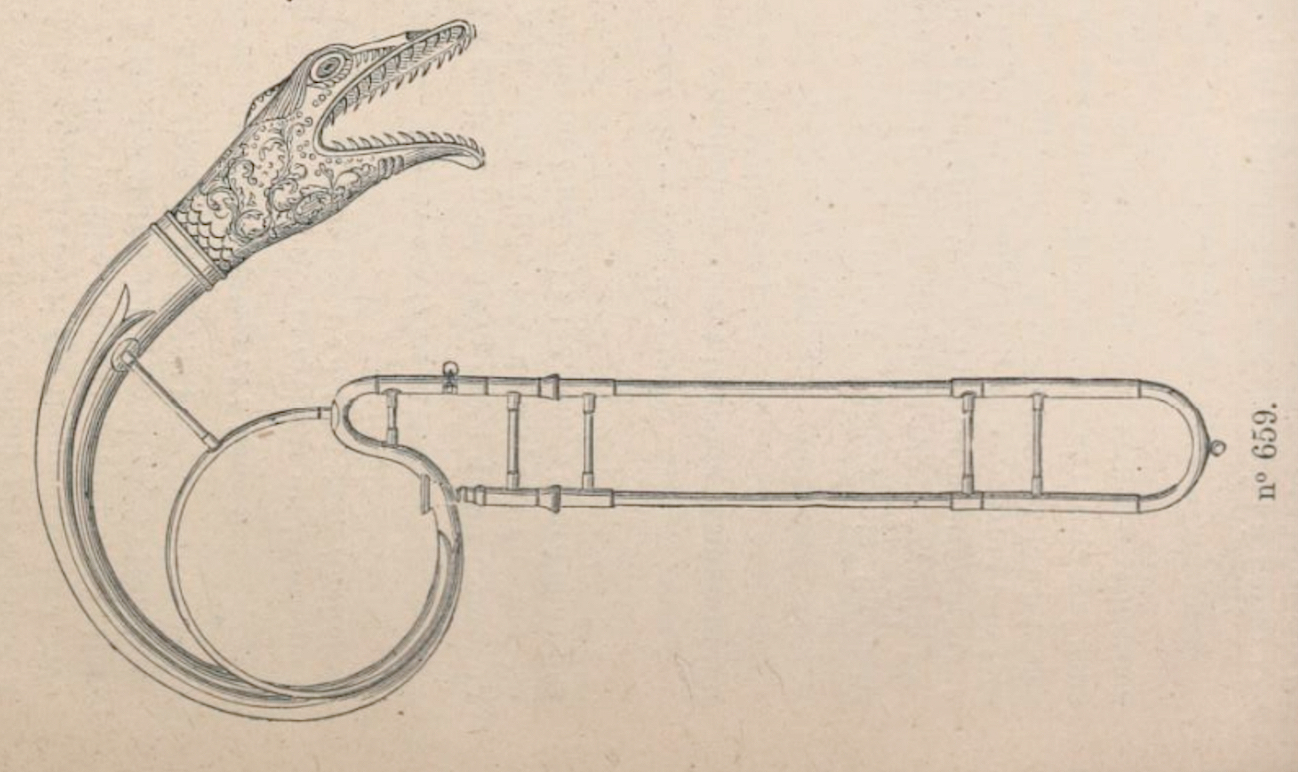
1884—Frederick Niecks, in A Concise Dictionary of Musical Terms, provides the following: “Trombone. A brass wind instrument with a slide, by which means it can extend its compass downwards, and produce all the chromatic notes within this compass….Besides the notes comprised in the compass…each of the three trombones has four so-called ‘pedal-notes:’ those of the alto and bass trombones, however, are bad and not easily practicable; and of those of the tenor trombone (B-flat, A, A-flat, G), only the first three are good, the fourth being difficult to produce….Three is the usual number of trombones employed in the orchestra. But the bass trombone is becoming more and more rare, and instead of it a second tenor trombone is frequently employed. In France we find even three tenor trombones. Besides the slide trombones there are also valve trombones, which, however, are inferior with regard to tone” (Niecks 246).
1884—Owensboro, Kentucky: A photograph labeled Sell’s Bros Side Show Band, Prof. Solomon White, leader, features a group of 10 African American brass and percussion players, including valve trombone (see below image; public domain).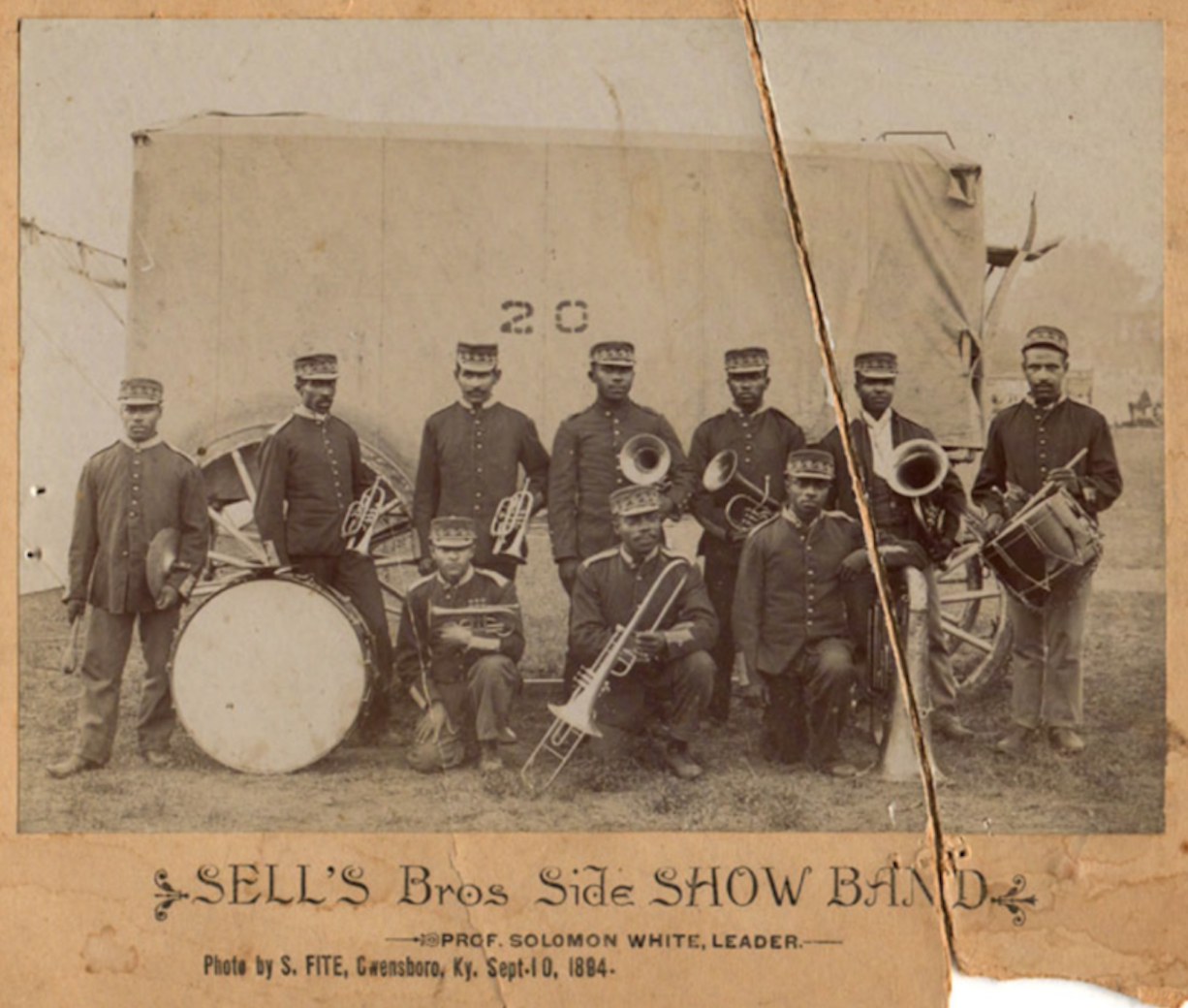
1884—Anton Bruckner’s Christus factus est calls for 6 voices and trombones (Rasmussen, A Bibliography of Choral Music).
1884—Paris Conservatory morceau de concours: Jules Demersseman, 1er solo de concert.
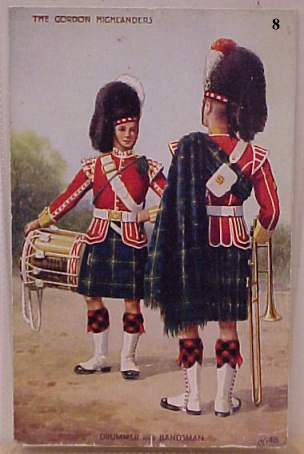 c. 1885—Scotland: Military musicians from the The Gordon Highlanders, a British army infantry regiment from 1881 to 1994, are depicted in an image subtitled Drummer and Bandsman. The regiment takes its name from the Clan Gordon and recruits largely from Scotland (see facing image; public domain). For a similar image, see 1908 in the 20th century timeline.
c. 1885—Scotland: Military musicians from the The Gordon Highlanders, a British army infantry regiment from 1881 to 1994, are depicted in an image subtitled Drummer and Bandsman. The regiment takes its name from the Clan Gordon and recruits largely from Scotland (see facing image; public domain). For a similar image, see 1908 in the 20th century timeline.
1885—Vienna, Austria: Anton Bruckner calls for 8-part chorus, organ, and 3 trombones in his motet, Ecce sacerdos magnus. The piece is written for celebrations marking the one-hundredth anniversary of the founding of the diocese of Linz and is specifically intended to be performed while the Bishop enters the church (Kinder 113; Rasmussen, A Bibliography of Choral Music).
1885—Johannes Brahms utilizes 3 trombones in chorale style in his Symphony No. 4.
1885—Paris Conservatory morceau de concours: Jules Demersseman, Solo de concours.
1885—France: An illustration by Leon Benett in Mathias Sandorf, and adventure novel by French author Jules Verne, includes a trombone (see below image; public domain).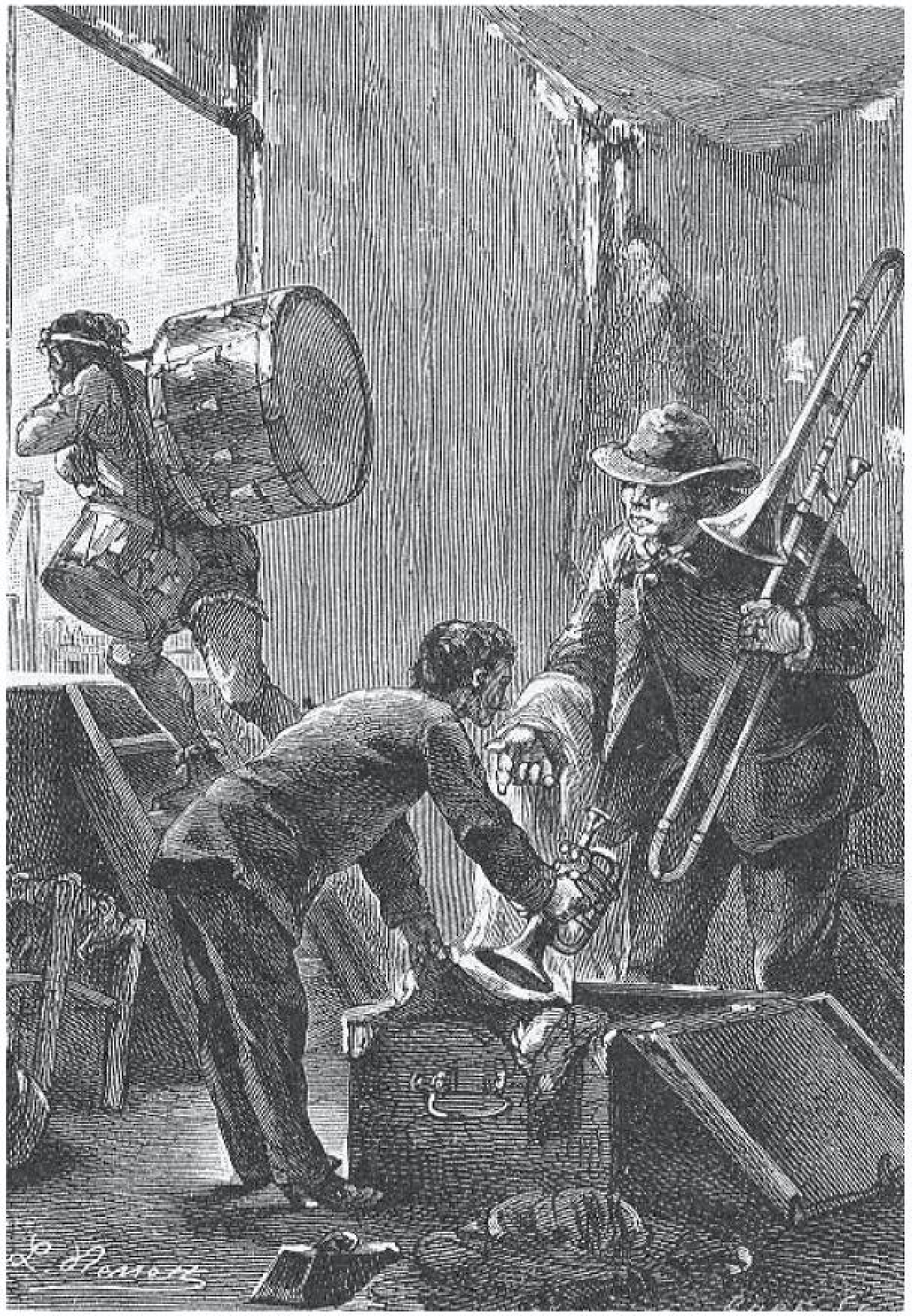
1885—London, England: Boosey & Co. makes 13 different “Case Model” trombones (instruments made in collaboration with trombonist George Case), including alto in E-flat; slide trombone in C; trombones in B-flat small, [standard], medium and bass; bass slide trombone in G; and bass slide trombone in F. One unique feature of these instruments is the tuning slide at foot of the hand slide (Myers, Brasswind).
1885—Germany: Artist Hugo Kauffmann’s artistic depiction of musicians includes a trombonist (see below image; public domain) (special thanks to Whelden Merritt).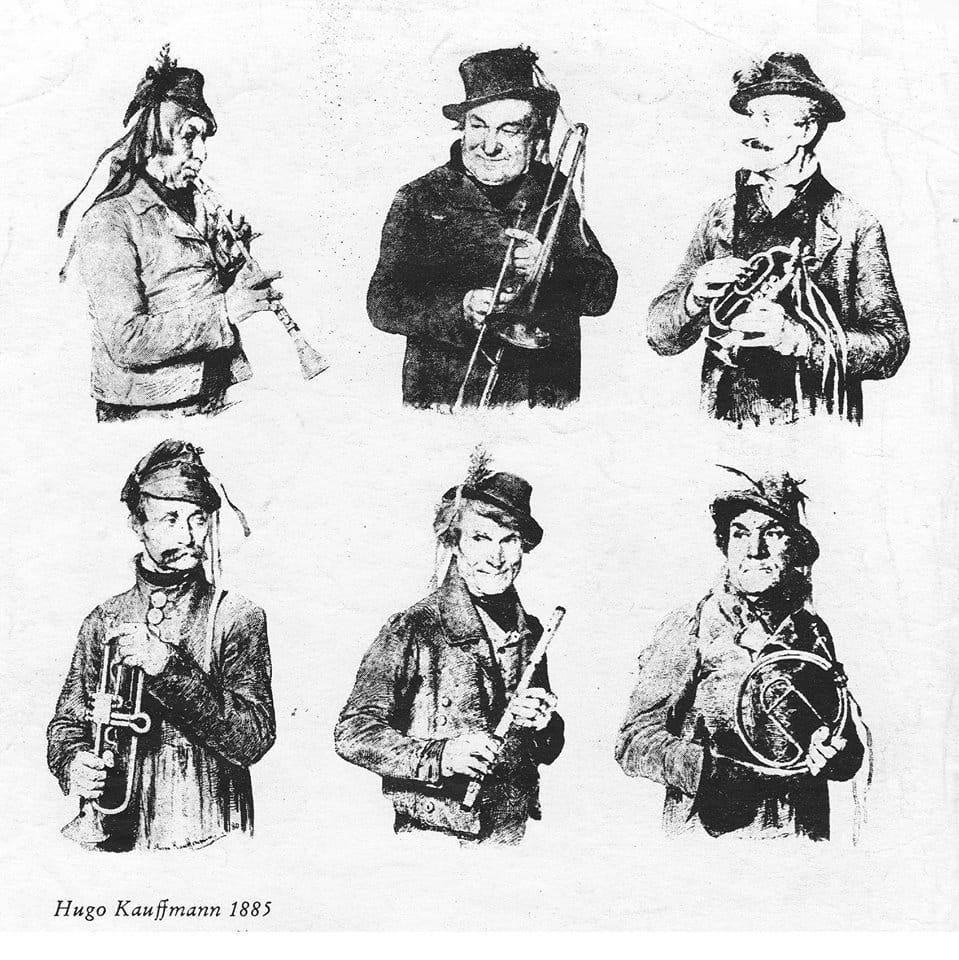
1885—Sunderland, England: A photograph of the Sunderland Monkwearmouth Salvation Army Band shows trombone players with alto, tenor and bass trombones (see below image; public domain).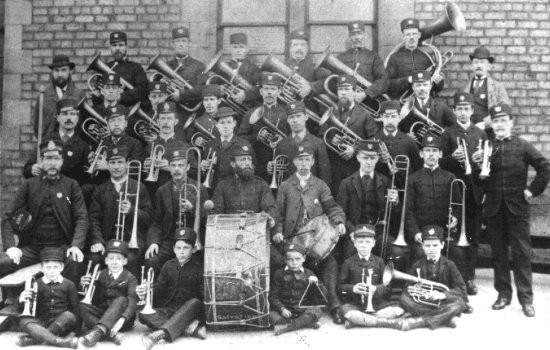
1885—Jean Béraud’s painting, Theatre Variétés, shows several instruments of a pit orchestra, including trombone (see bottom-right of below image; public domain) (Musee des Arts Decoratifs, Paris).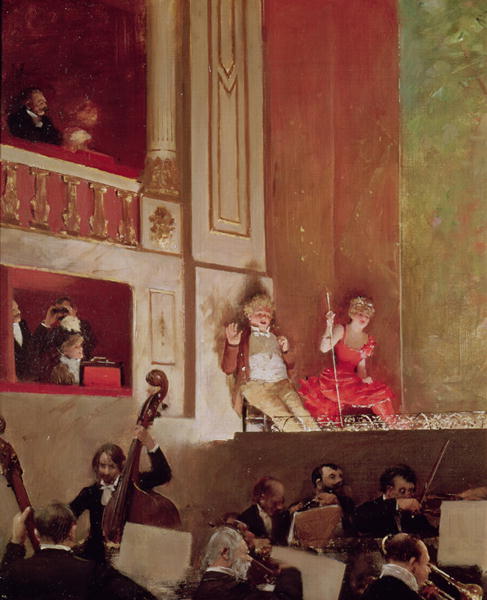
1885—Paris, France: A print by M. Eugene Chaperon entitled La répétition, published in L’Illustration, features a pair of trombonists rehearsing with a band (see below image; public domain) (l’Illustration vol. 86, September 12, 1885, pp. 172-173).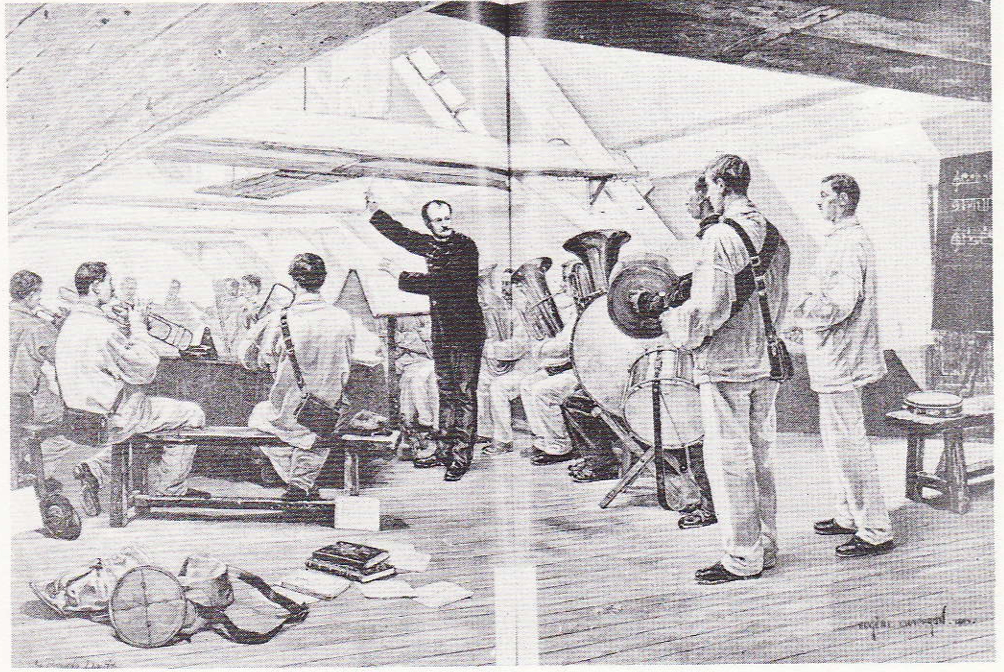
1885-1887—Cincinnati, Ohio: Peter G. Thomson publishes a print of paper soldiers figures, called Brass Bands, which includes a trombone (see below image; public domain) (Ryan 280).
c. 1886—New York: A political cartoon published by Puck magazine targeting the labor movement includes a depiction of an orchestra with a trombone player (who represents the “anarchist press”). See below image; public domain.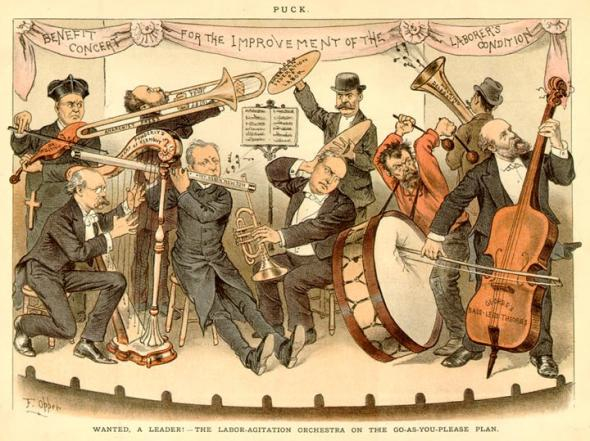
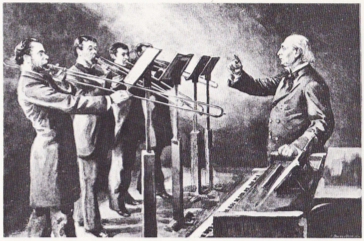 1886—Paris, France: The French periodical L’Illustration publishes Au conservatoire: Classe de trombone, professeur M. Delisse (drawing by Paul Renouard), a depiction of the trombone studio of the Paris Conservatoire (see facing image; public domain) (L’Illustration, vol. 88, 1886, p. 56). Paul Delisse, the instructor named, was trombone professor at the Paris Conservatoire from 1871 to 1888 (Herbert, Trombone 136).
1886—Paris, France: The French periodical L’Illustration publishes Au conservatoire: Classe de trombone, professeur M. Delisse (drawing by Paul Renouard), a depiction of the trombone studio of the Paris Conservatoire (see facing image; public domain) (L’Illustration, vol. 88, 1886, p. 56). Paul Delisse, the instructor named, was trombone professor at the Paris Conservatoire from 1871 to 1888 (Herbert, Trombone 136).
1886—Paris Conservatory morceau de concours: Hedwige Chrétien, Solo (andante et allegro).
1886—Saint-Saëns, Symphony No. 3, includes important trombone solo.
1886—Spain: Ricardo Villegas Cordero paints After the Mass. The painting features children playing a buccin and a standard trombone, as well as another child picking up a buccin (see below image; public domain).
1886—Macon, France: Hippolyte Perrin’s painting, Instruments de musique, includes two trombones (see below image; public domain) (museé des Ursulines).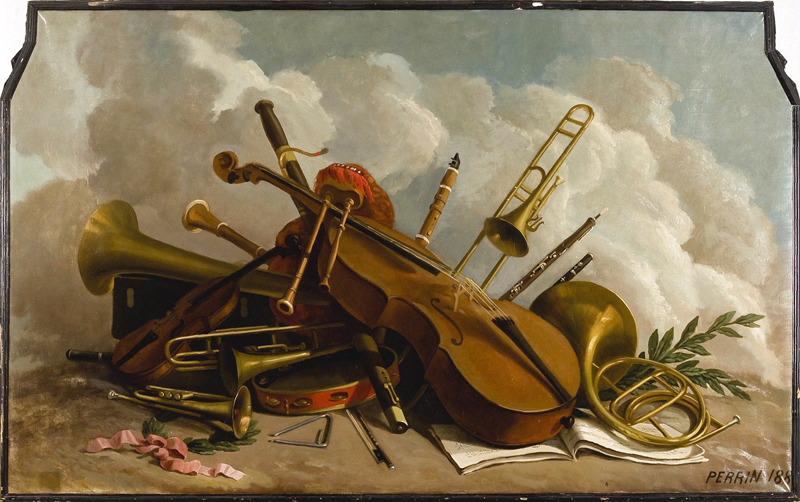
1887—Verdi’s Otello makes prominent use of trombones.
1887—Paris Conservatory morceau de concours: Jules Demersseman, 1er solo de concert.
1887-88—France: Georges Seurat draws a crayon and chalk study that features a trombonist as a preparatory drawing for his painting, Circus Side Show/Parade de cirque (see below image for drawing and 1888 for painting; public domain images) (Philadelphia Museum of Art).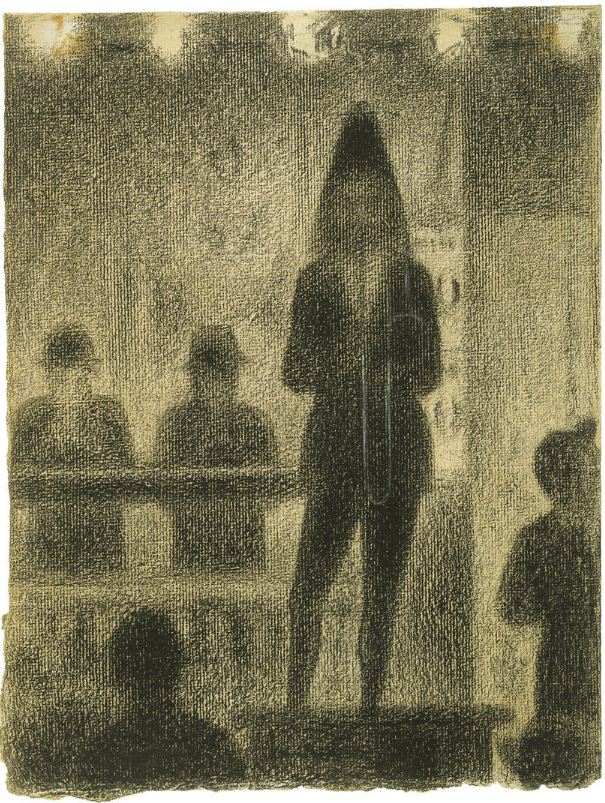
1888—Georges Seurat depicts a circus trombonist in Parade de cirque (see below image; public domain). In contemporary photographs the circus that Seurat portrays, identified as the popular Cirque Corvi, reveals a trombone hanging from a pillar near its entryway. Advertisement posters of the time depict a clown standing on the central pedestal occupied by the trombonist in Seurat’s painting (Herbert, Seurat 137-143). An exact contemporary of Seurat’s work is seen in Fernand Pelez’s Grimaces and Misery, which depicts a similar scene, this time with two clowns on the central pedestal and three musicians, a clarinetist, trombonist, and bassoonist, seated to the right of center (see below) (Herbert, Seurat 152).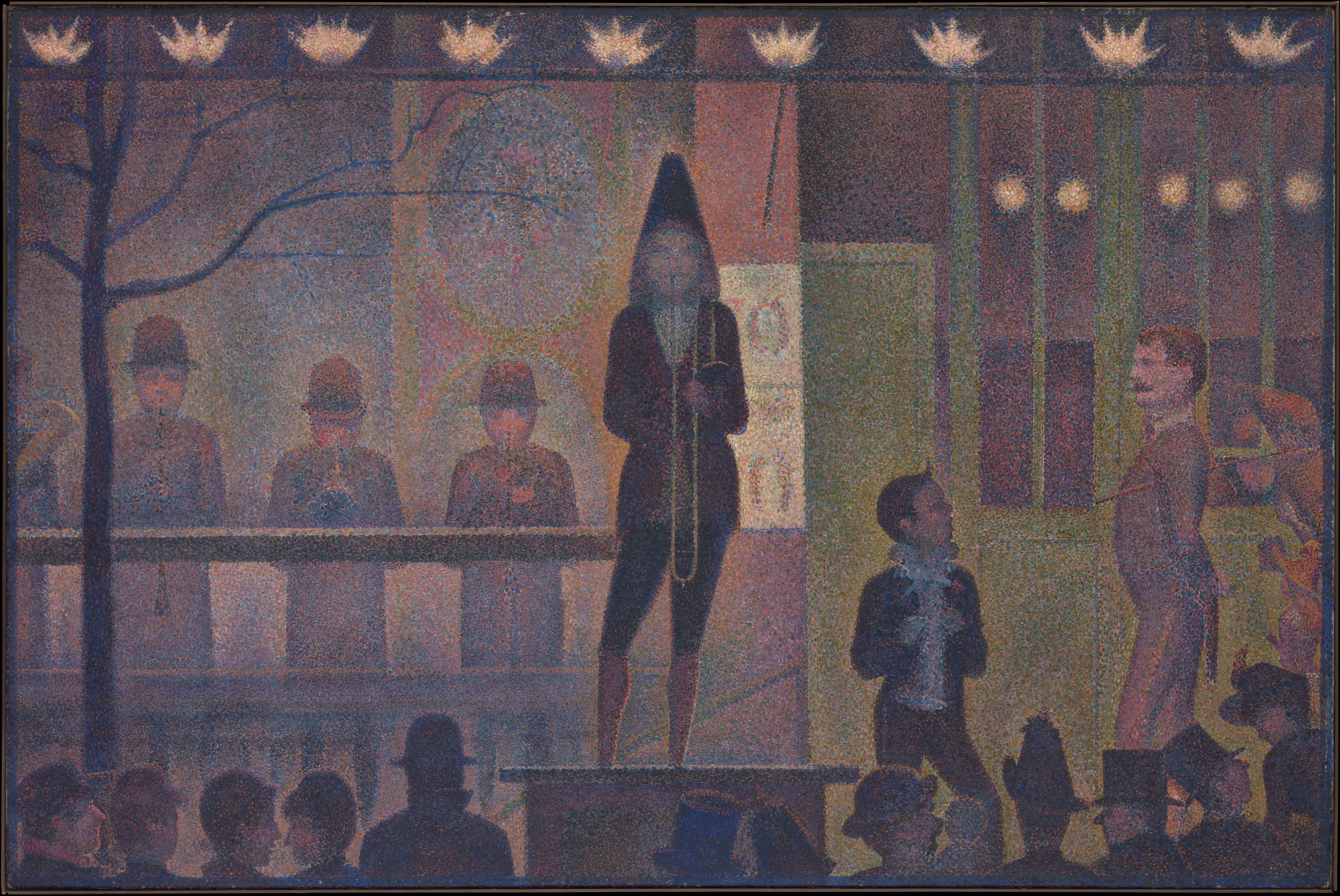
1888—Russia: When Koussevitzky enters the Moscow Conservatory, trombone and string bass are the only 2 instruments that can be learned there without the payment of fees.
1888—A series of cigarette cards advertising W. Duke Sons & Co. cigarettes depicts women playing various musical instruments, one of the cards depicting a woman holding what appears to be a valve trombone (see below detail; public domain).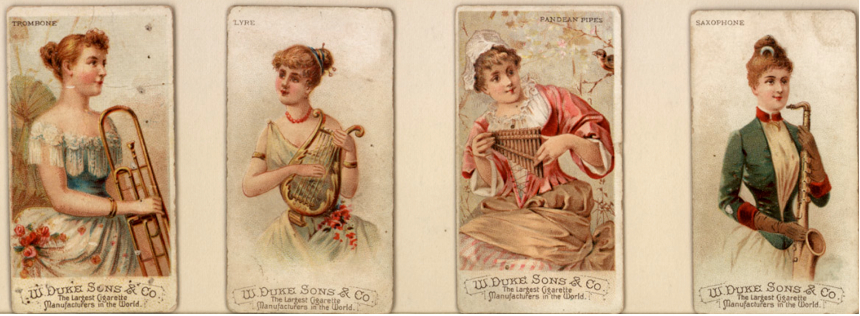
1888—Bethlehem, Pennsylvania: An engraving published in Harper’s Weekly features the Bethlehem Moravian trombone choir playing by torchlight for arrivals at the Easter Dawn service (see below image; public domain) (Harper’s, March 31, 1888).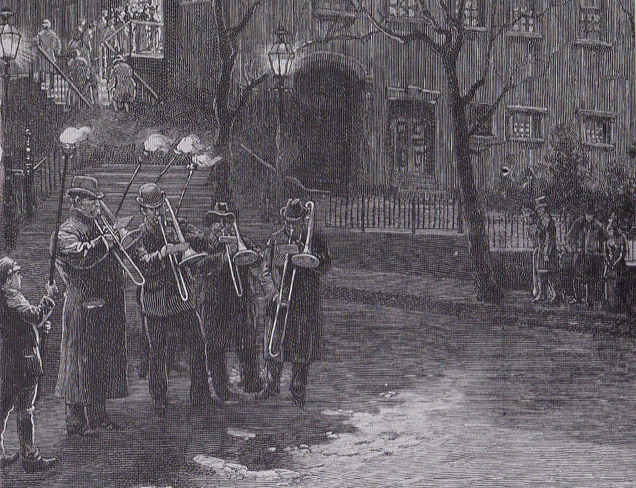
1888—Bethlehem, Pennsylvania: An image in Harper’s Weekly portrays Moravian trombones accompanying singing at the town cemetery at an Easter sunrise service (see detail and full image below; public domain).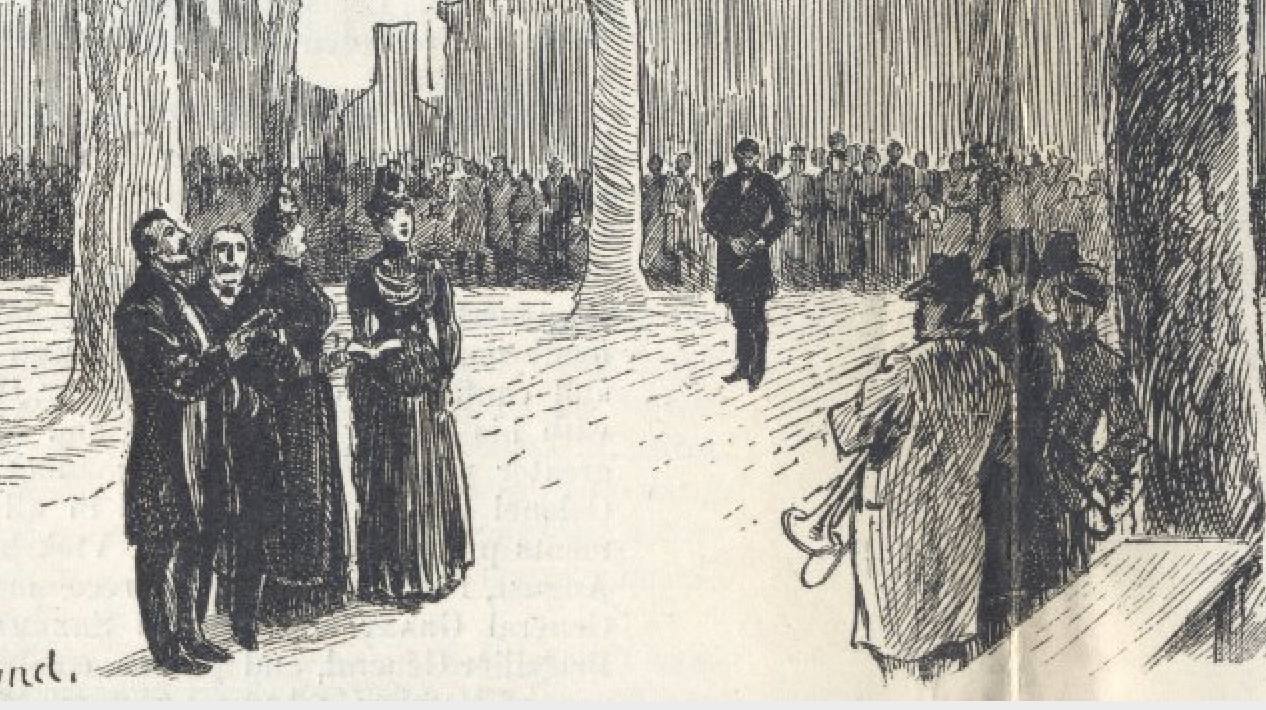

1888—Bologna, Italy: Andrea Calmo reports that the civic wind band, consisting of 16 cornetti, tromboni, and pifferi, together with a drummer, plays for an hour each evening in front of the town hall (“palazzo publico”) (Rasmussen, Tower Musicians).
1888—Paris Conservatory morceau de concours: Jules Demersseman, Cavatine.
1888—Denmark: Erik Henningsen’s painting, Vagtparade, features several valve trombones in a military band (see below image; public domain) (Copenhagen, State Museum for Art).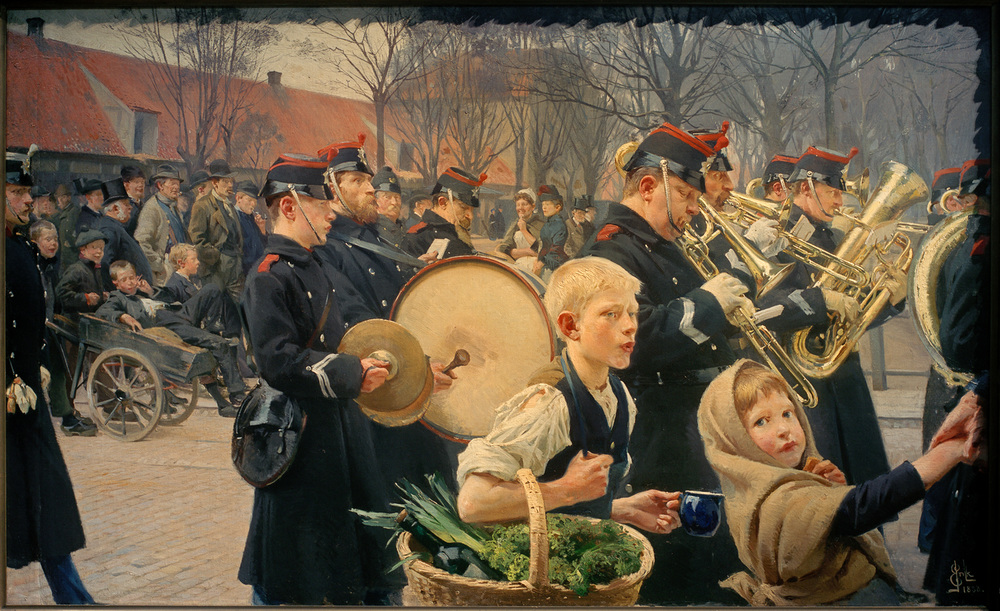
1888—Nicolai Rimsky-Korsakov’s Russian Easter Overture includes a prominent 2nd trombone solo.
1888—Nicolai Rimsky-Korsakov’s Scheherazade includes a 2nd trombone solo.
1888—Paris, France: Fernand Pelez’s Grimaces and Misery depicts poor circus workers situated on a platform, including a group of three seated musicians (see detail and full image below; public domain) (Musée du Petit Palais, Paris).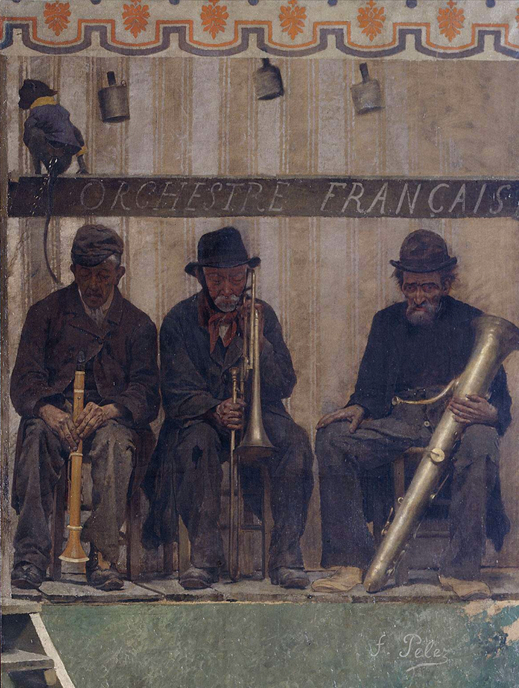
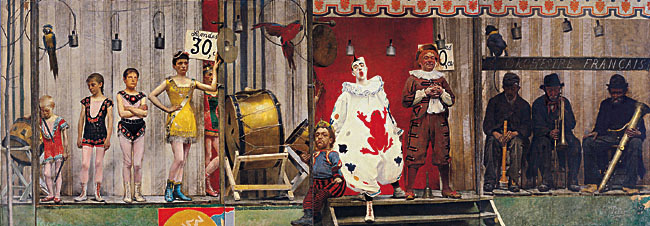
1888-1925—Louis Allard runs the trombone studio at the Paris Conservatory (Dudgeon 195).
1889—London, England: Author George Bernard Shaw, in his music criticism column, comments on his family exposure to trombone: “I believe that a taste for brass instruments is hereditary. My father destroyed domestic peace by immoderate indulgence in the trombone; my uncle played the ophicleide—very nicely, I must admit—for years, and then perished by his own hand. Some day I shall buy a trombone myself.”
1889—London, England: Author George Bernard Shaw, in his music criticism column, comments on an instrument he had seen at an exhibit: “At the Inventions Exhibition Messrs Rudall and Carte displayed a double-slide trombone, which I felt insanely tempted to purchase. Of the merits of this instrument I was, and am, wholly ignorant, except that I inferred that its ‘shifts’ were only half as long as on the ordinary trombone; and I ascertained that its price was 13 guineas. If ever I have so vast a sum at my command I shall probably buy that trombone, and ask Herr Richter to engage me for the next concert at which the Walkürenritt or Les Francs Juges is in the program” (Shaw, Corno di Bassetto 79).
1889—London, England: Author George Bernard Shaw, in his music criticism column, discusses trombone performance practice in the orchestra: “Bye the bye, I do not agree with Musigena that Mr Manns keeps his brass too quiet at the Crystal Palace. I admire two things at Sydenham: the brass and Mr Manns himself. The strings are often snappish and mechanical, the wood wind stolid; but the brass is generally noble. I have never heard the statue music in Don Giovanni more finely played than at Mr Mann’s centenary recital of that masterpiece; and this is as much as to say that Mr Manns feels for the trombone like Mozart and myself. But I certainly believe that the time is approaching when it will be admitted that the doubling, trebling, and quadrupling of the strings which has taken place in the modern orchestra requires a proportional multiplication of wind instruments to balance them….And though I never want Mr Manns’s trombones to play four times as loud—the trombone being a tender plant that must not be forced—I sometimes want twelve trombones instead of three” (Shaw, Corno di Bassetto 79).
1889—New York: An engraving published in Harper’s Weekly titled The Seventh Regiment Band on the March features a half dozen trombones in the front row (see below image; public domain).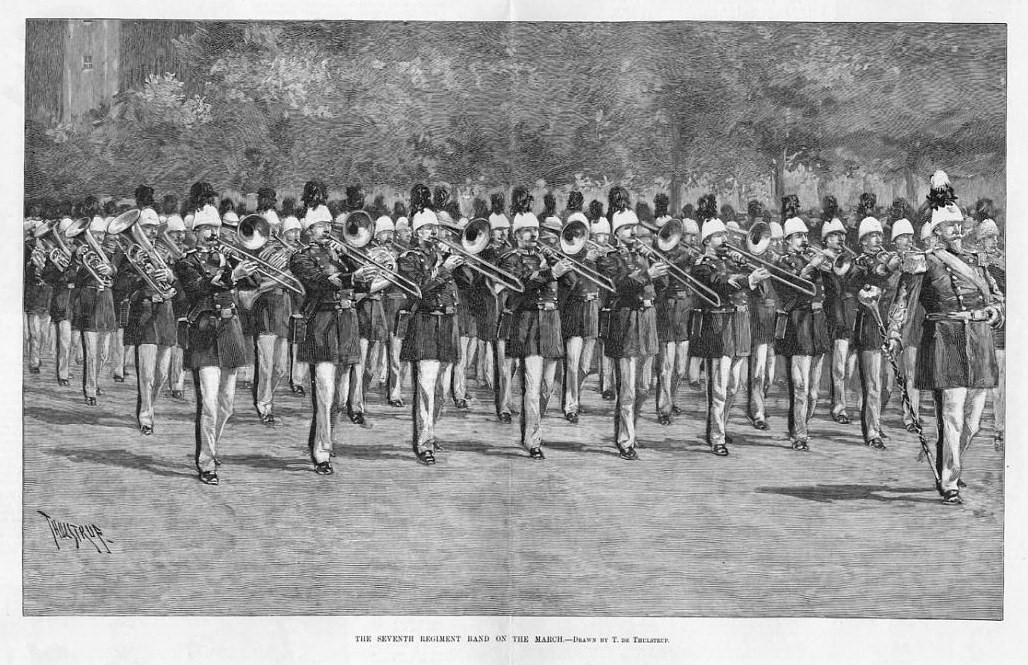
1889—New York: Harper’s Weekly magazine runs an image, titled “Quartette of Trombones” (see below image), accompanied by the following somewhat odd (and wildly inaccurate) paragraph about the history of the instrument: “The invention of the trombone has been attributed to Tyrtans, who made it from the bark of a tree, in 685 B.C. Moses, the law-giver of the Scriptures, was the first man to bring into prominence trombones, which were used at palm festivals and also at coronations. Among the ruins of Pompeii was found a trombone with a gold mouthpiece, which was afterward presented by the King of Naples to King George III of England. In the year 1520 an instrument maker, Herr Hans Menschel, in Nuremberg, made and perfected the slide trombone, which is considered the most perfect of the brass instruments. Pope Leo X was so fond of the trombone that his Holiness ordered two to be made of pure silver. Mozart was the first composer to use it in the orchestra. Since his time it has taken its place among the indispensable instruments. In Gilmore’s band there are three solo trombones and one bass” (Harper’s Weekly, 1889, Issue 9/28, p. 788).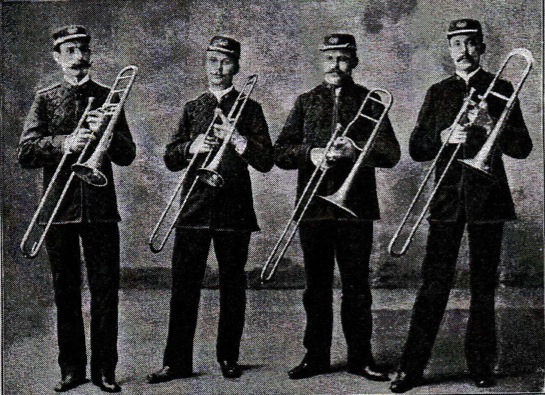
1889—Madrid, Spain: An engraving in La Ilustración Española y Americana depicting the wedding of princess Borghese in Rome includes a trombone with a music ensemble (see detail and full image below; public domain).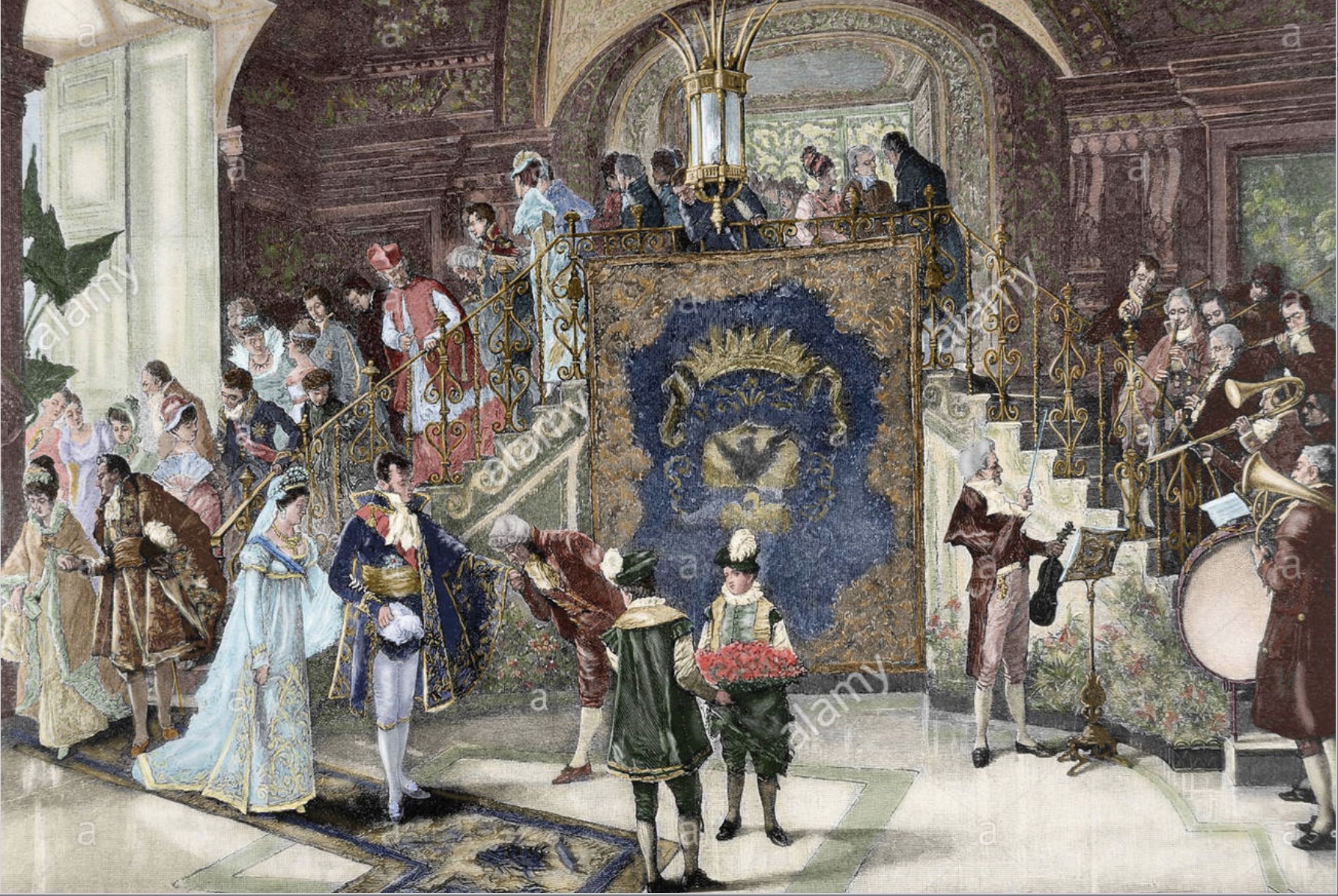
1889—London, England: Two images from Randolph Caldecott: A Personal Memoir feature the trombone (see below 2 images; public domain).
1889—César Franck, Symphony in D Minor.
1889—Richard Strauss, Don Juan.
1889—Paris Conservatory morceau de concours: Adrien Barthe, Solo de concours.
c. 1890-1920—Small-bore Courtois-type trombones popular in France, England, and in bands in U.S. Players in American symphony orchestras prefer large-bore German instruments, influencing development of modern American symphonic trombone (which combines the features of both, but continues to favor large, German-type instruments).
c. 1890—Thale, Germany: A photograph of a children’s Posaunenchor includes a pair of trombones (see below image; public domain).
c. 1890—Italy: Antonio Lonza’s painting, Newly Married Couple, includes a trombonist as part of an ensemble performing outdoors for a wedding celebration. The trombone appears to have a double slide (see below image, after Lonza painting; public domain) (Seidl, vol. 2, 325).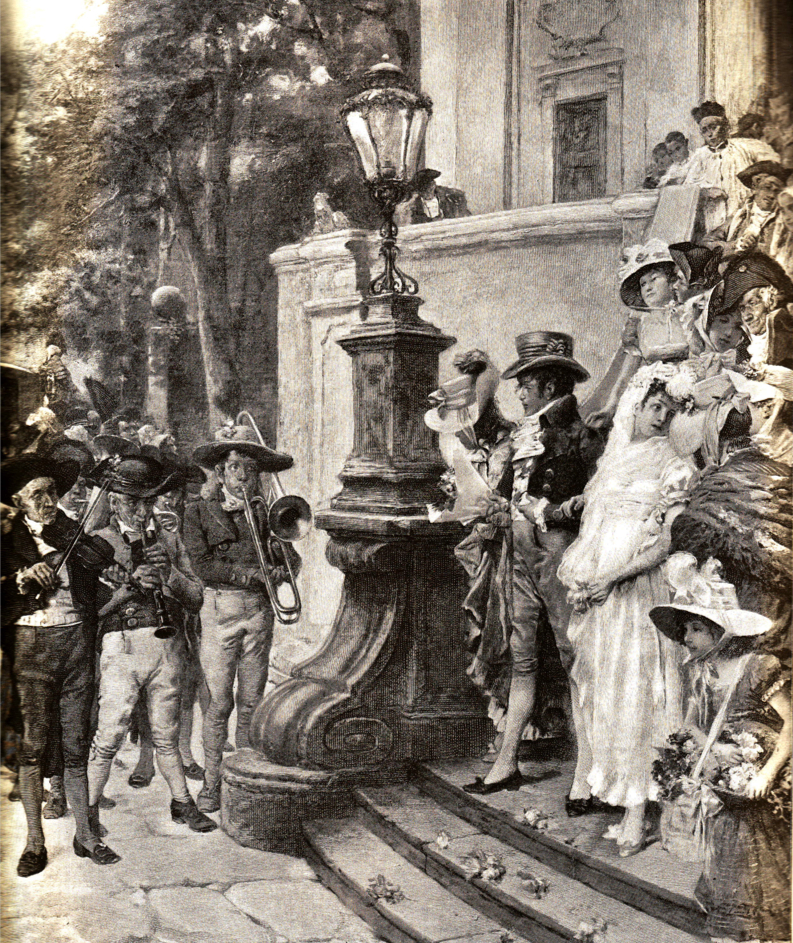
c. 1890—Russia: Victor Ewald, a civil engineer who had studied cornet and composition at the St. Petersburg Conservatory, composes Quintet No. 1 for Brass for a group of amateur musicians who perform on cornets and saxhorns. Ewald goes on to write 3 more quintets for the same instrumentation (Wallace, Brass Solo 243).
c. 1890—Munich, Germany: A painting by Otto Piltz (1846-1910) depicting a quintet of string players includes what appears to be a trombone hanging on the wall (see below image; public domain).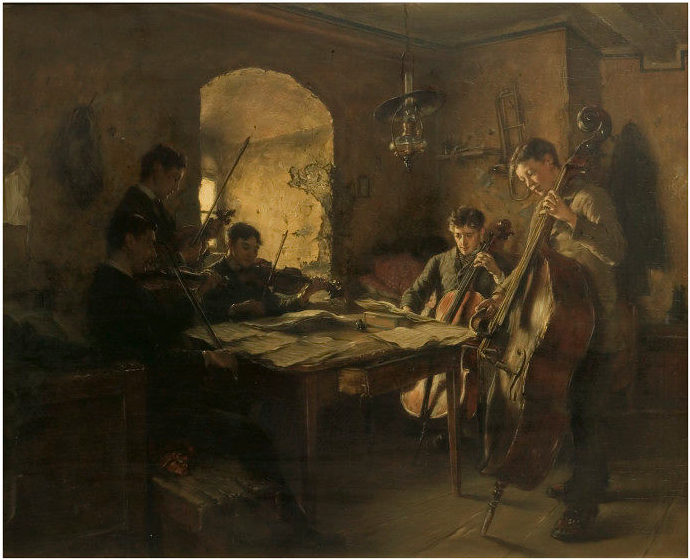
1890—Paris Conservatory morceau de concours: Jules Demersseman, 1er solo.
1890—London, England: Author George Bernard Shaw writes in his music criticism column, “Some time ago I suggested that Mr Manns should give us some medieval trombone and organ music at the Saturday concerts. Consequently I should be praising myself if I were to applaud the selection of Heinrich Schütz’s Lamentatio Davidis for performance on Saturday. Besides, the chief credit on this score must surely be due to Mr George Case, who probably induced the Wind Instrument Society to bring it forward at a concert last month. I guess this because I first heard the work in 1885 at South Kensington, where he played it with Mr Geard and Messrs J. and Antoine Matt, the voice part (taken by Mr Henschel on Saturday) being sung by Mr Stanley Smith. On that occasion they also played Luther’s Eine feste Burg, which I can recommend to Mr Manns if he feels disposed for more trombone music. We all know the trombone in its melodramatic moods; but its noblest qualities never come out so impressively as when it is treated in what I may call a spirit of pure counterpoint” (Shaw, Corno di Bassetto 384).
1890—London, England: Author George Bernard Shaw writes about trombone in his music criticism column: “The Valkyrie Ride, which came next, excited the audience furiously; but it also made a lady on the orchestra put her fingers into her ears. The lady was quite right. The Valkyrie Ride requires above all things fine trombone-playing—such playing, for instance, as Mr. Manns seldom fails to get at the Crystal Palace from Messrs Hadfield, Geard, and Phasey, who generally contrive to stop short of that brain-splitting bark which detaches itself from the rest of the orchestra, asserting itself rowdily and intrusively in your ear, preventing you from hearing the music, and making you wonder, if you accept the hideous din as inevitable, how Berlioz could ever call such an ignobly noisy instrument ‘Olympian.’ No matter how many fortissimo marks the composer writes, there is no use in forcing the tone of the trombone, unless, indeed, you are to be intentionally hellish, as in Liszt’s Inferno. But if you want to be majestic, as in the Valkyrie Ride and the Francs Juges overture, then it is not to be done by bawling like a mob orator who does not know his business. Why Richter permits forcing, and even encourages it, not only in the Valkyrie Ride but in the first movement of the Tannhäuser overture, can only be explained as the result of his share of original sin. It is not that his players cannot do better: they are always dignified in the Valhalla motif in the Nibeling music. I once heard Herr Müller, Richter’s first trombone, play the ‘oraison’ in Berlioz’ Sinfonie Funebre et Triomphale very finely. But on Monday week the only tolerable brazen sound in the piece came from the other side of the orchestra, where Mr. Geard was playing the bass trumpet part on an alto trombone. During the few bars in which the theme was left to him the lady did not keep her fingers in her ears; and the volume of sound from the orchestra was greater instead of less than when his colleagues were blaring away, because the accompaniment could be heard through his transparent and musical tone, whereas the others drowned everything else with their distracting rattle. I am not squeamish about the quantity of sound that comes from an orchestra: the more thundering its fortissimo, the better I like it. I delight, for example, in Richter’s tremendous handling of the Rienzi overture. But I am fastidious as to the quality of the tone, however voluminous it may be; and, frankly, the Valkyrie Ride might as well be conducted by Buffalo Bill as by Richter, if some regard is not paid to the artistic spirit, if not to the snobbish expression, of Sterndale Bennett’s remark about treating trombone-players as gentlemen. I am aware of the full horror of recommending to Richter a precept by the Mendelssohnian Sterndale Bennett; but I cannot help that: much as I respect Richter, and appreciate the relief he brought us thirteen years ago in the midst of a dire music famine, I am not going to be tromboned out of my senses for him or any conductor alive when the remedy is so easy” (Shaw, Music in London, 17-19).
1890—Antonin Dvorak composes his Requiem, which calls for 4 trombones (Chase 260).
1890—New Orleans, Louisiana: An anti-jazz cartoon by F. Bildestein, published on the cover of the newspaper The Mascot, depicts a rear-facing or over-the-shoulder trombone (see below image) (public domain image; source: wikimedia commons). Click for larger image.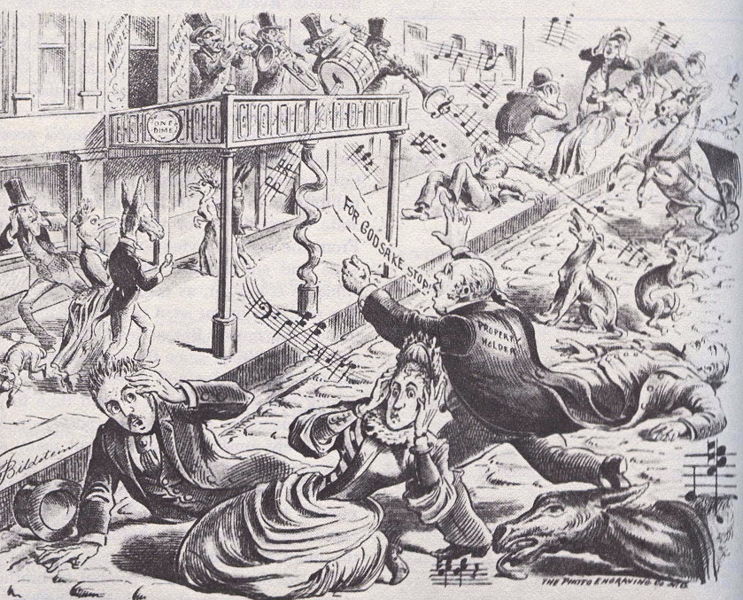
1891—London, England: Explanatory notes from an exhibition of musical instruments includes the following about the trombone family in England: “The family of trombones consists in the present day of the alto in e-flat or f, the tenor in B-flat, and the bass in G or F. The F bass trombone is in constant use in Germany, but unfortunately is little employed in this country” (Day, Descriptive Catalogue 176).
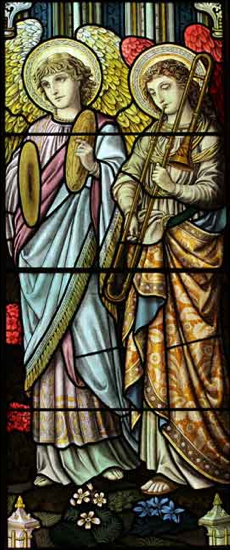 1891—Booton, Norfolk, England: The rebuild of St. Michael and All Angels church is completed. One of the nave windows, completed by Alex Booker, includes a depiction of an angel playing trombone, coupled with another playing cymbals (see facing image; public domain) (Wilson, North East Norfolk and Norwich: Norfolk 1, 409).
1891—Booton, Norfolk, England: The rebuild of St. Michael and All Angels church is completed. One of the nave windows, completed by Alex Booker, includes a depiction of an angel playing trombone, coupled with another playing cymbals (see facing image; public domain) (Wilson, North East Norfolk and Norwich: Norfolk 1, 409).
1891—Stuttgart, Germany: According to Paine et al., trombone continues to be used in the German Stadtpfeifer. The authors mention this fact in the context of discussion of a particular Polish vocal tradition: “…the singing of ‘Hajnaly,” or Morning songs, from the towers of Cracow to wake the inhabitants, a custom which reminds one of that soothing musical substitute for bells—a trombone performance of chorals—on South German church towers, not yet obsolete even in Stuttgart” (Paine, Famous Composers 855).
1891—Rimsky-Korsakov, in his Principles of Orchestration, includes the following about trombone: “Trombone. Dark and threatening in the deepest register, brilliant and triumphant in the high compass. The piano is full but somewhat heavy, the forte powerful and sonorous. Valve trombones are more mobile than slide trombones, but the latter are certainly to be preferred as regards nobility and equality of sound, the more so from the fact that these instruments are rarely required to perform quick passages, owing to the special character of their tone” (Rimsky-Korsakov 24).
1891—Paris Conservatory morceau de concours: Hedwige Chrétien, Grand solo (Andante et Allegro).
1891—Chicago, Illinois: The following trombonists are listed for the Chicago Symphony’s inaugural season: O. Gebhardt, W. Zeller, and J. Nicolini (Otis 415).
 c. 1892—A postcard features an image of two Victorian children playing with a trombone. The trombone appears to have an slide extension handle (see facing image; public domain).
c. 1892—A postcard features an image of two Victorian children playing with a trombone. The trombone appears to have an slide extension handle (see facing image; public domain).
1892—Paris Conservatory morceau de concours: Jules Demersseman, Fantaisie sur le Carnaval de Venice.
1892—England: Some instrument manufacturers begin to offer both small-bore and medium-bore tenors. However, according to Baines, “large bore became a stock model only considerably later” (Baines, Brass 55).
1892—Nicolai Rimsky-Korsakov, in his Mlada, writes what is probably the earliest notated trombone glissando (Wills, Orchestra 173).
1892—Arthur Pryor joins the Sousa band (Herbert, Trombone 148).
1892—Belgium: Willem Geets paints Puppet Theatre at the Court of Margaret of Austria (Mechelen 1515). It belongs to a series of paintings by Geets, depicting, 500 years after the events, the young Prince Charles as he was raised in Mechelen at the court of his aunt, Margaret of Austria. The picture includes a trombone (possibly an alto trombone) performing in a small wind ensemble accompanying a puppet show (Museum Hof van Busleyden). See below image; public domain.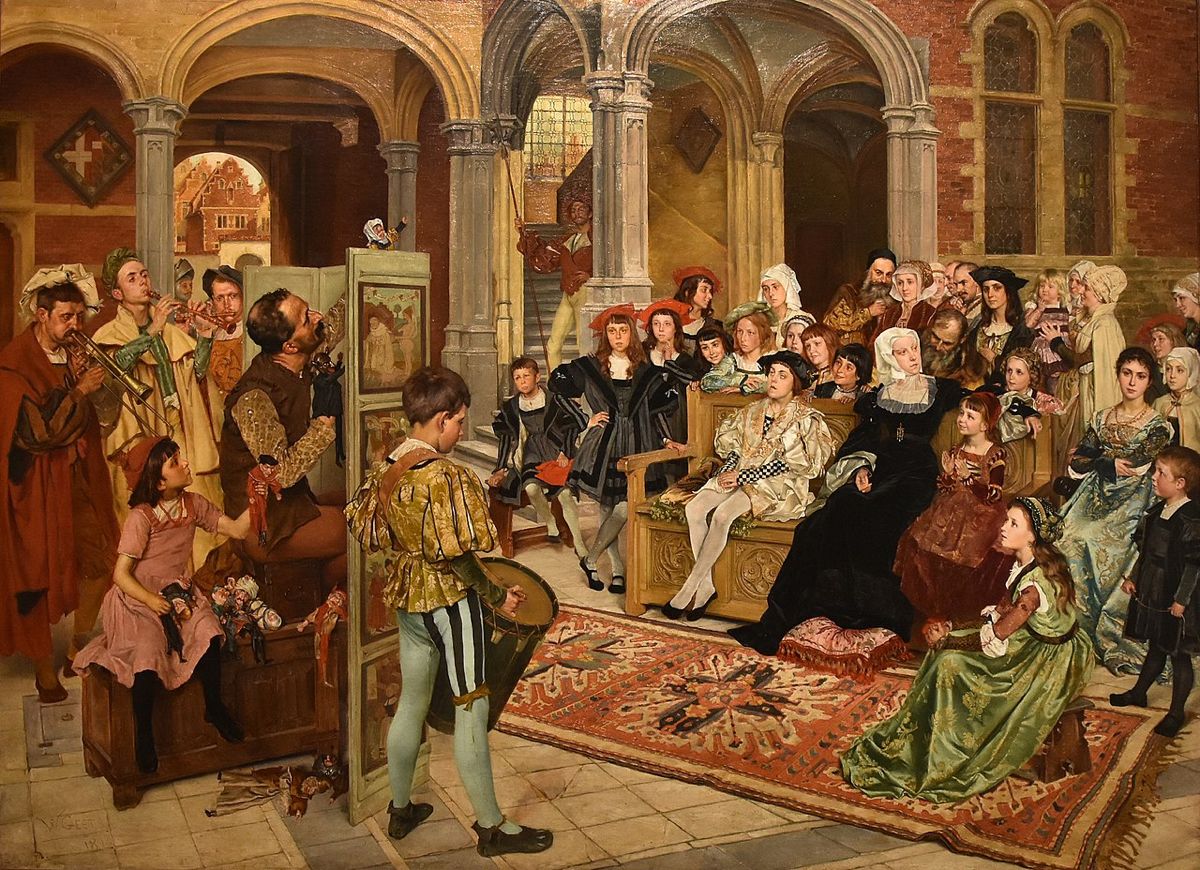
1892—San Francisco, California: A photograph of John Philip Sousa and the Marine Band includes trombones (see below image; public domain).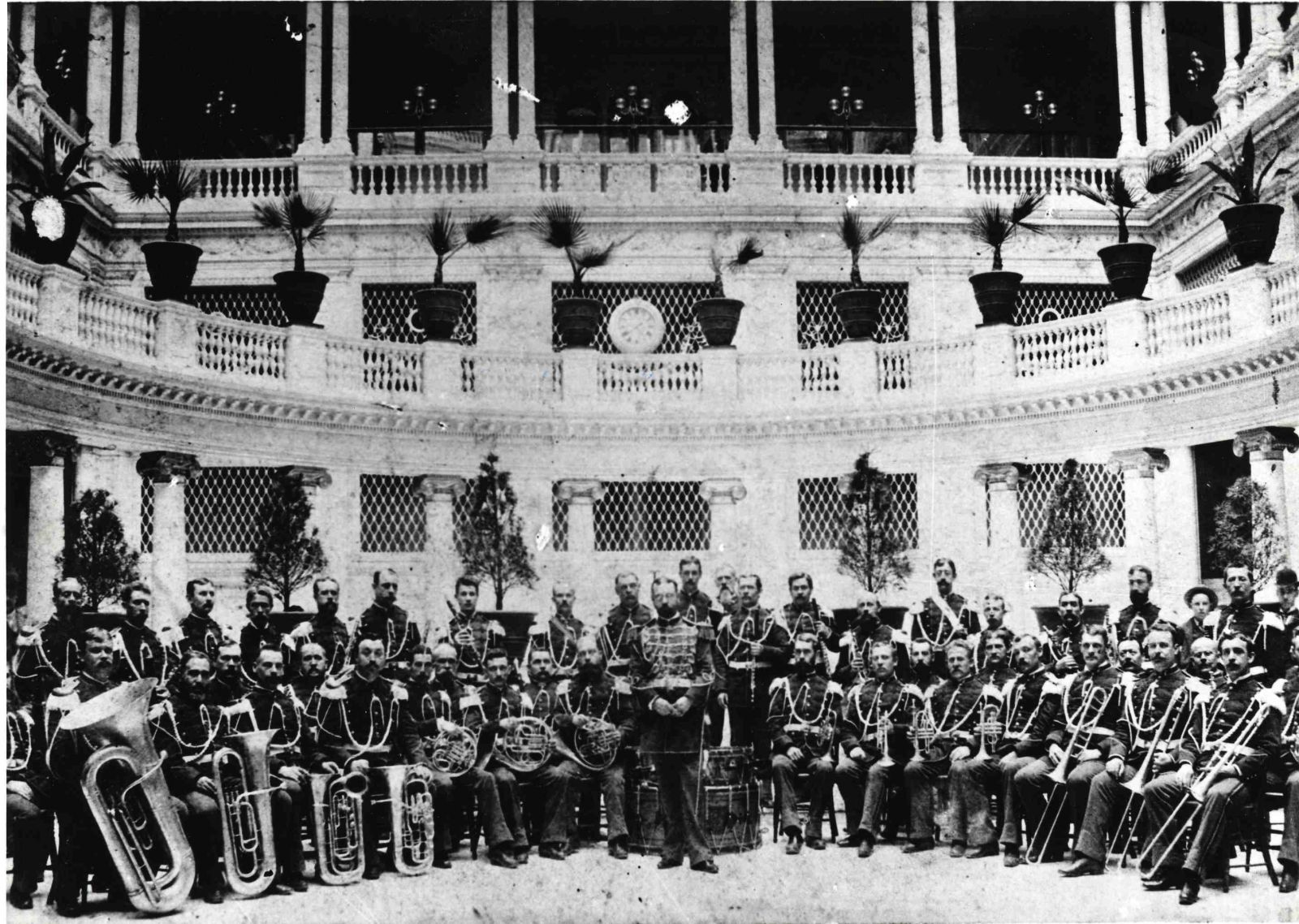
1893—Paris Conservatory morceau de concours: Jules Demersseman, Cavatine en sol.
1893—Peter Ilyitch Tchaikovsky, Symphony No. 6, “Pathétique.”
1893—Rimsky-Kovsakov writes the following about his trombone concerto (in a chapter later posthumously published as part of his autobiography): “During 1876-77 I composed, so to speak ‘by the way’ variations for oboe…and a concerto for trombone; both of these with the accompaniment of a military (wind) band. These pieces were performed by the oboist Ranishevski and the trombonist Lyeonoff at the Cronstadt concerts of the United Bands of the Naval Department, under my direction. The soloists gained applause, but the pieces themselves went unnoticed, like everything performed at Cronstadt….These compositions of mine were written primarily to provide the concerts with solo pieces of less hackneyed nature than the usual; secondly, that I myself might master the virtuoso style, so unfamiliar to me, with its solo and tutti, its cadences, etc. The finale of the trombone concerto was not bad, taken all in all, and was effectively orchestrated” (Rimsky-Korsakov, My Musical Life 181).
1893—Gabriel Fauré reorchestrates his Requiem, the second version, adding 3 trombones (Chase 262)
1893—Paris, France: A contrabass double-slide trombone by Jérome Thibouville-Lamy is manufactured according to the model of Halari-Antoine (Heyde, Metropolitan).
1893—Paris, France: Nouvelle méthode de trombone a 3 et 4 pistons (clé de sol), a valve trombone method by Jean-Baptiste Schiltz (1807-1868), is published in Paris (see below image; public domain) (National Library of France).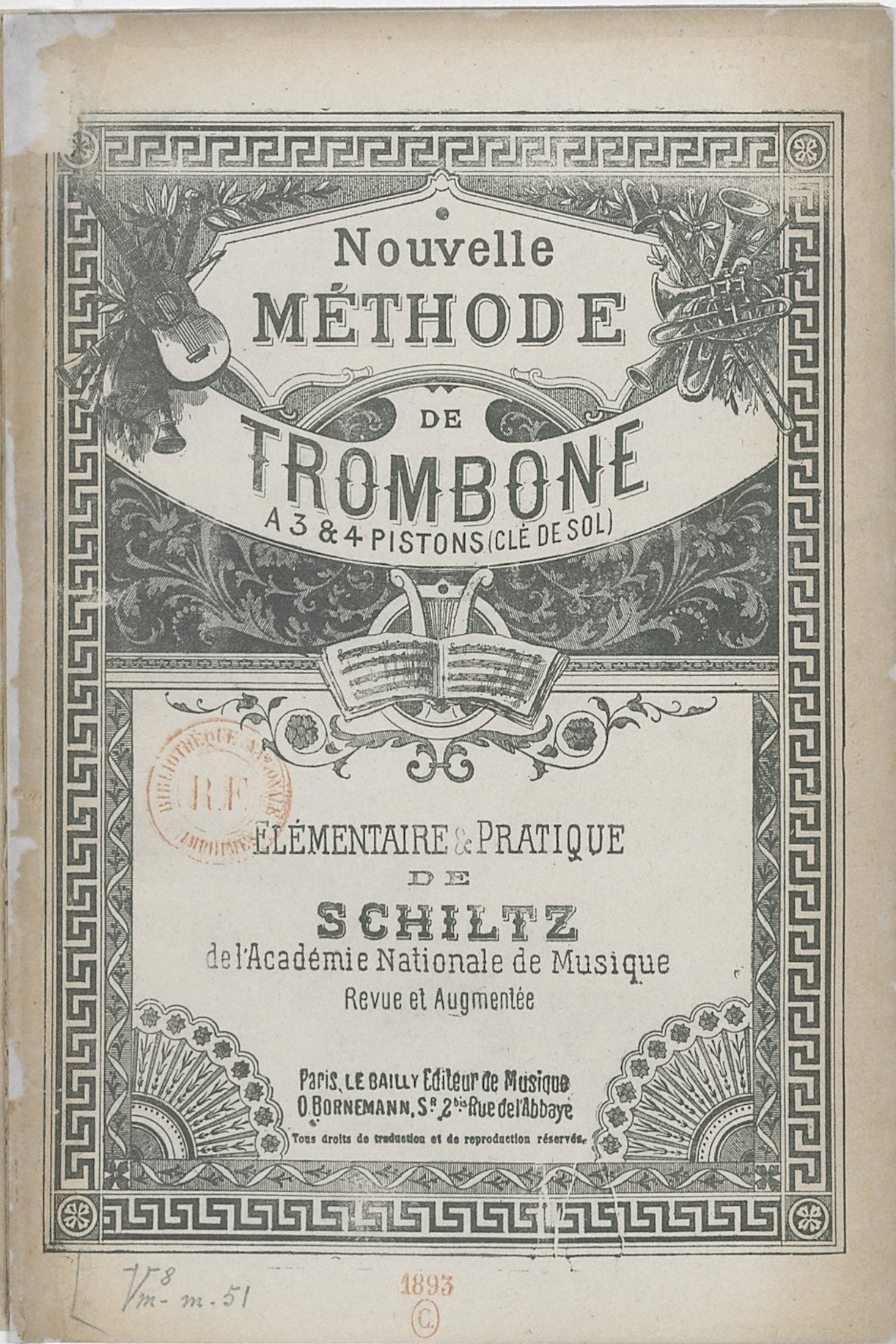
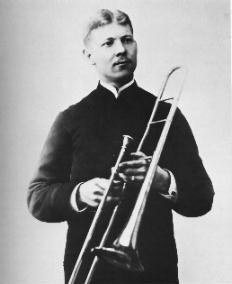 1893-1903—Arthur Pryor performs extensively as trombone soloist with John Philip Sousa Band, playing many of his own virtuosic compositions. Pryor’s virtuosic performances earn him the nickname “Paganini of the trombone” and help establish trombone as a solo instrument in United States (Wallace, Brass Solo 246). One reviewer, speaking of a solo performance with Sousa in Omaha, Nebraska, says, “His execution set the prairies afire; his vibrating pedal notes rattled the windows of the Theater and killed the gold fishes and stunned the canaries all the way out to the packing plant where even the iron gates trembled” (Herbert, Trombone 148).
1893-1903—Arthur Pryor performs extensively as trombone soloist with John Philip Sousa Band, playing many of his own virtuosic compositions. Pryor’s virtuosic performances earn him the nickname “Paganini of the trombone” and help establish trombone as a solo instrument in United States (Wallace, Brass Solo 246). One reviewer, speaking of a solo performance with Sousa in Omaha, Nebraska, says, “His execution set the prairies afire; his vibrating pedal notes rattled the windows of the Theater and killed the gold fishes and stunned the canaries all the way out to the packing plant where even the iron gates trembled” (Herbert, Trombone 148).
1893—Arthur Pryor is featured soloist with the John Philip Sousa Band at the World’s Columbian Exposition (Guion, Four American).
1893—Milan, Italy: Giuseppe Ascalone says the following about the timbre of trombones in his Manualetto: “While on its own the bass tuba is an excellent orchestral instrument on account of its gentle voice, both agile and weighty, its dark sound is unpleasing to the ear when heard in conjunction with the clear tone of the trombones” (Meucci).
1894—France: Adrien Lagard’s Metodo de trombón de tres y cuatro pistons, Spanish translation (see below; public domain) (National Library of France).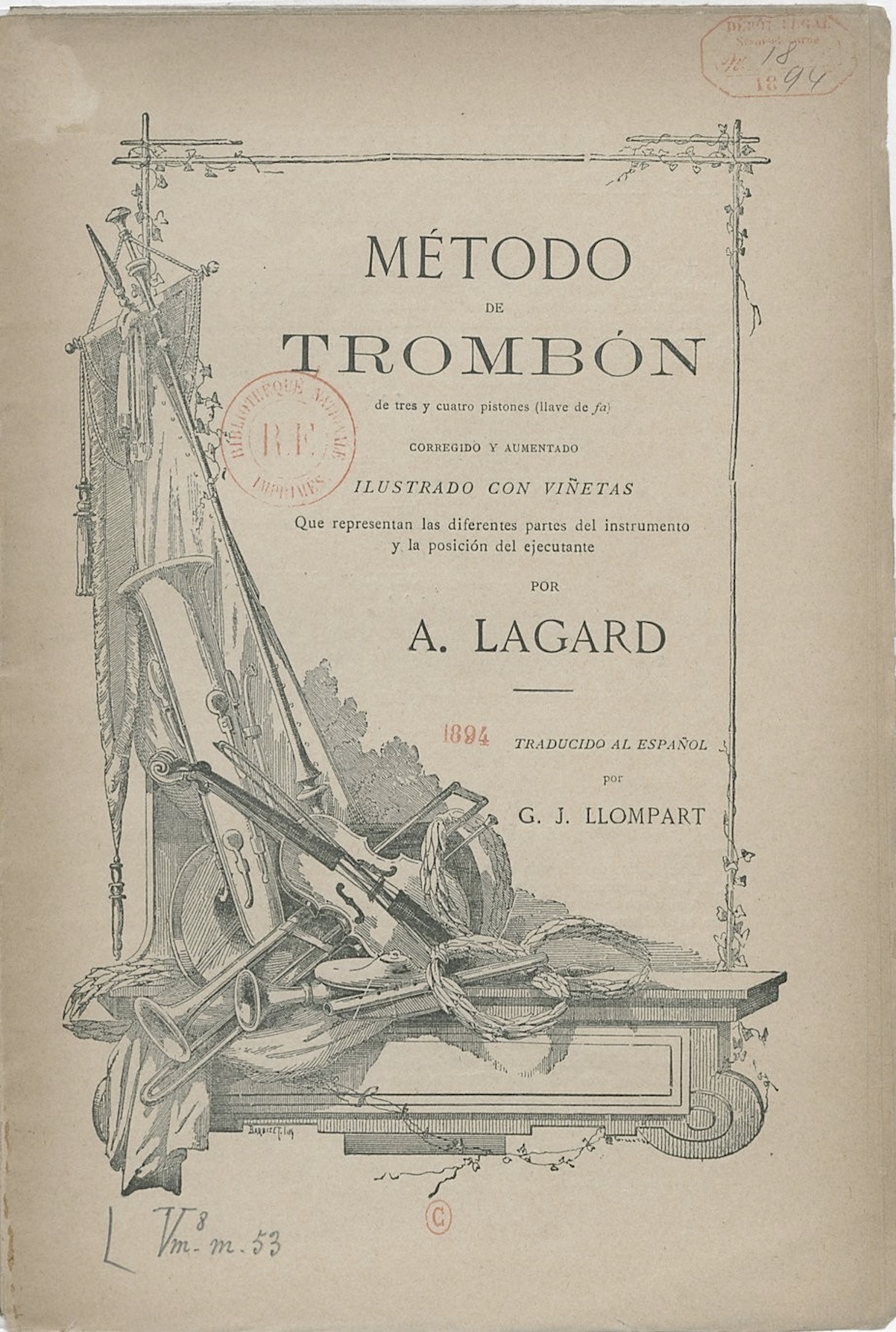
1894—Detroit, Michigan: Joseph L. De Good files a patent for a “trombone-gage.” In his words, “I have devised what I have termed a ‘position indicator,’ which is attached to the fixed and sliding tubes having indices thereon by which the end of the sliding tube can be readily adjusted” (De Good) (see below image; public domain).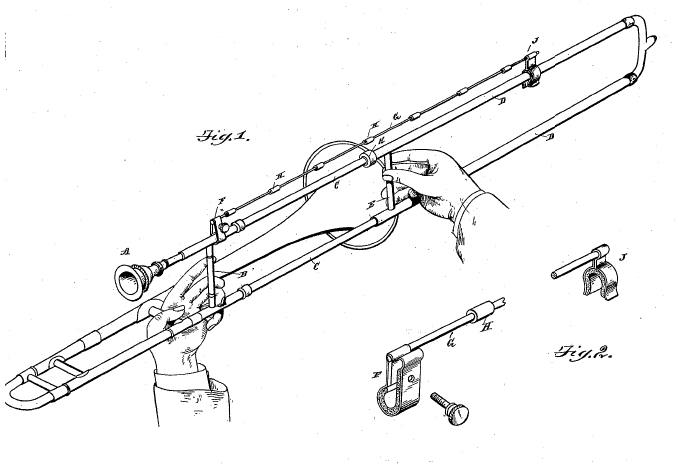
1894—London, England: The Concert Trombone Quartette, advertising in the Musical News, provides endorsements from The Daily Telegraph and from Frederick Bridge, organist of Westminster Abbey. The quartet, comprised of T. Colton, F.W. Davis, E. Atherley, and R.H. Booth, features members of the London Symphony, Royal College, and Royal Italian Opera (see below image; public domain) (Musical News, Dec 8, 1894, p. 494).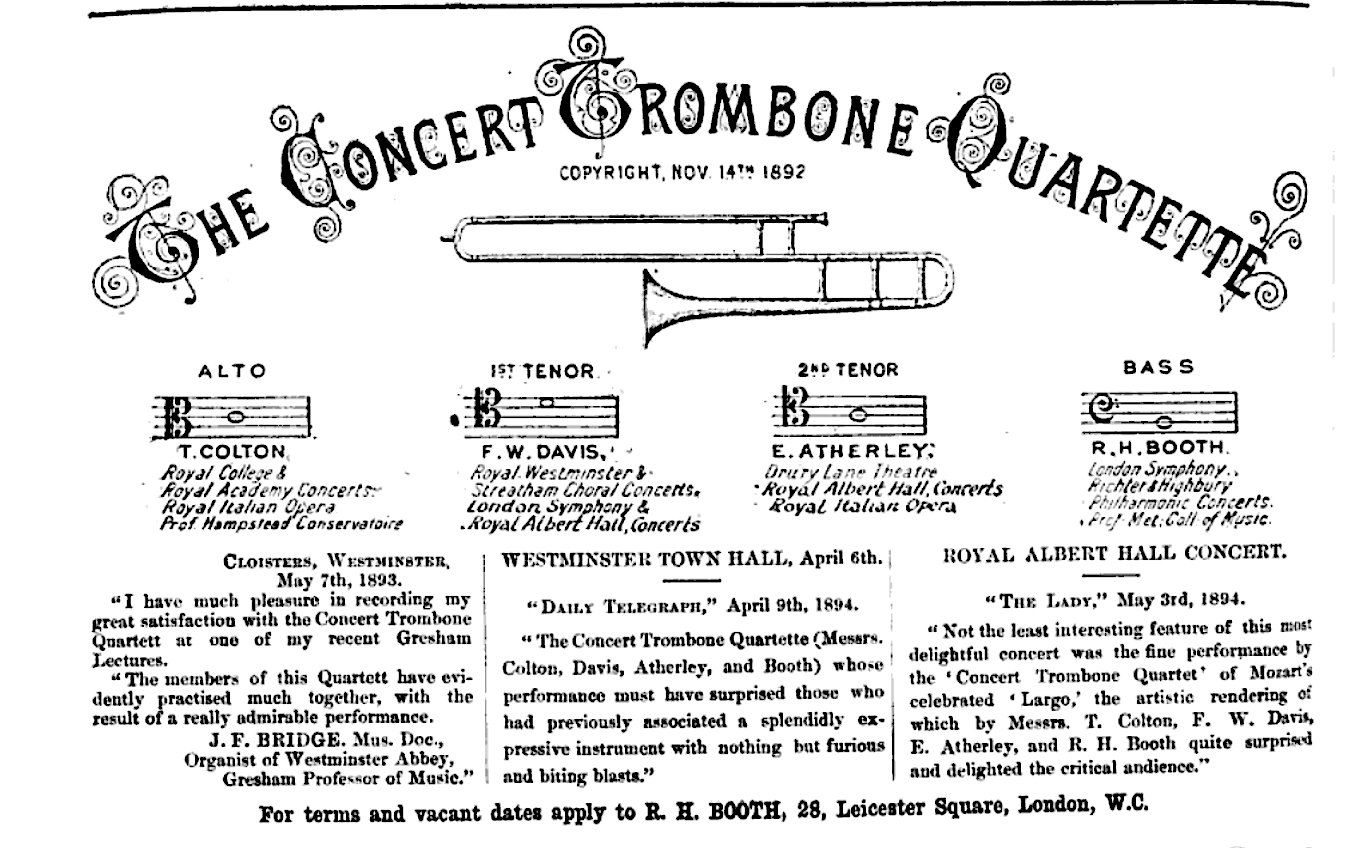
1894—A lithograph by A. Douhin for the cover of a piece of music, “Pizzicati par Ernest Gillet,” includes a trombonist among a group of costumed musicians serenading a woman (see detail below; public domain) (Les Images 98).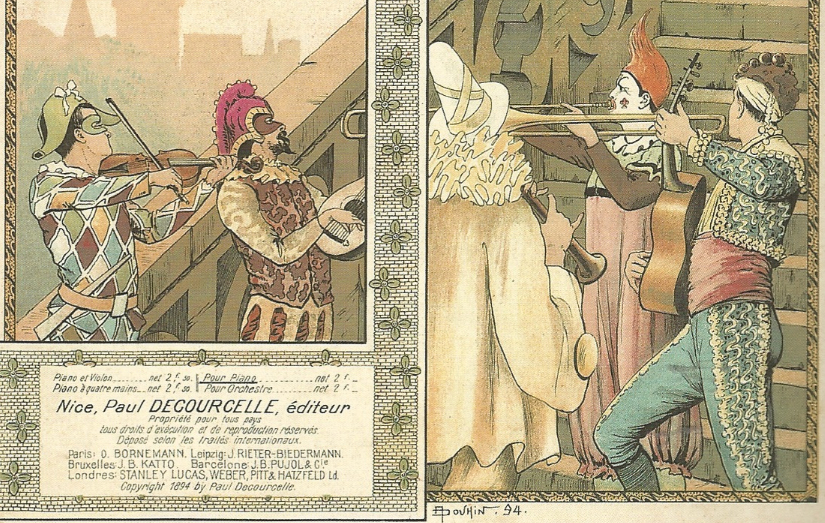
1894—Paris Conservatory morceau de concours: Adrien Barthe, Solo de concours en ré.
1894—Gustav Holst, Duo Concertante for Trombone and Organ (also known Duet for Organ and Trombone). First documented performance occurs in 1895 at the Highway Congregational Church in Cheltenham by Adolph von Holst (organ) and J. Boyce (trombone).
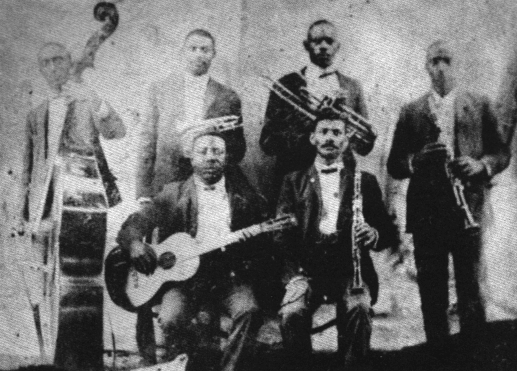 c. 1895—New Orleans, Louisiana: Trombonist William Cornish joins trumpeter Buddy Bolden’s band as possibly the earliest known jazz trombonist (Bolden himself often being considered the first jazz musician). Jazz pioneer Kid Ory later describes seeing and hearing Cornish perform, usually on valve trombone, at around the turn of the century (Dietrich 15) (see above photograph of Bolden’s band, with Cornish holding valve trombone; public domain; source: wikimedia commons).
c. 1895—New Orleans, Louisiana: Trombonist William Cornish joins trumpeter Buddy Bolden’s band as possibly the earliest known jazz trombonist (Bolden himself often being considered the first jazz musician). Jazz pioneer Kid Ory later describes seeing and hearing Cornish perform, usually on valve trombone, at around the turn of the century (Dietrich 15) (see above photograph of Bolden’s band, with Cornish holding valve trombone; public domain; source: wikimedia commons).
1895-1929—Berlin, Germany: Paul Weschke (1867-1940) is solo trombonist of Royal Orchestra of Berlin. He is known for his remarkable range (see 1935 entry, below); his own composition, Carneval in Venedig, requires considerable virtuosity and ascends to double high b-flat (Lenthe).
1895—United States: A Ringling Brothers circus poster advertises “A superb preliminary musical festival” by Liberati’s Band, billing the ensemble as “America’s grandest military concert band.” Pictured is a large band with 10 trombonists (see upper-right of below image) (public domain).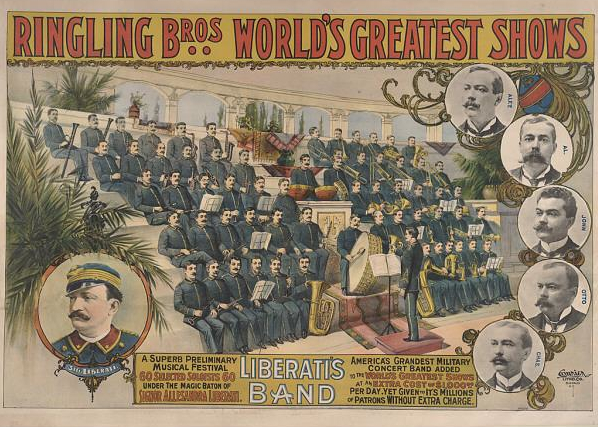
1895—Paris Conservatory morceau de concours: Jules Demersseman, 1er solo de concours.
1895—Richard Strauss, Till Eulenspiegel.
1895—A Barnum & Bailey Circus poster printed by Stobridge Lithograph advertises Carl Clair’s Grand Military Band and Orchestra, making the claims, “The greatest musical organization in the world” and “The finest body of skilled musicians that ever traveled.” The depiction of the ensemble shows 3 trombones (see detail and full image below; public domain).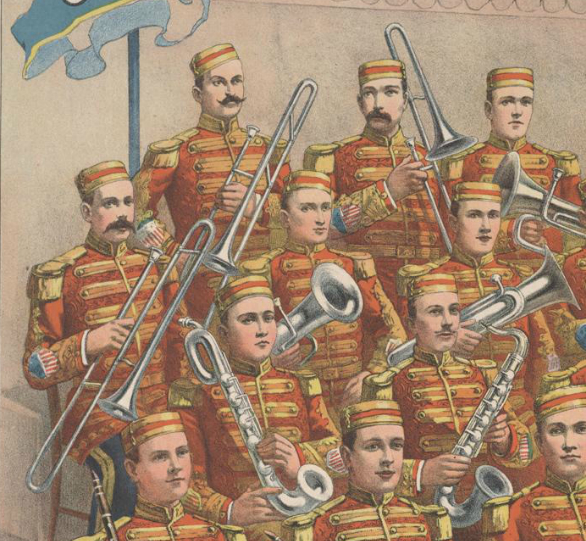
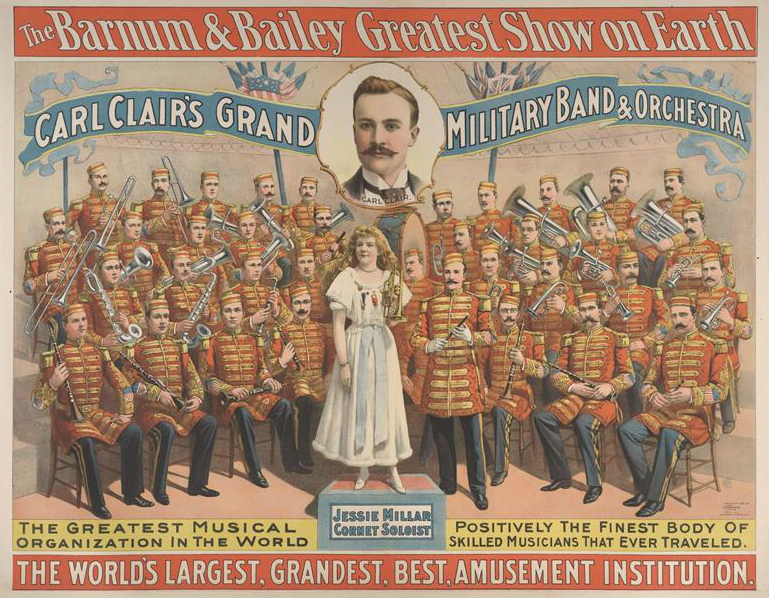
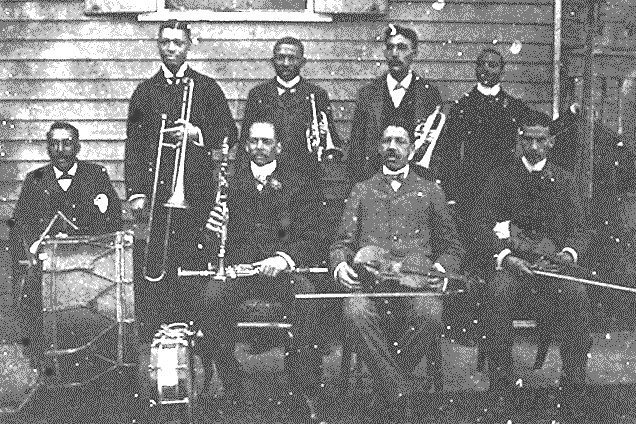 1896—New Orleans, Louisiana: A photograph of the John Robichaux Orchestra shows a varied grouping of instrumentalists, including slide trombonist Baptiste DeLisle (see facing image; public domain) (source: wikimedia commons).
1896—New Orleans, Louisiana: A photograph of the John Robichaux Orchestra shows a varied grouping of instrumentalists, including slide trombonist Baptiste DeLisle (see facing image; public domain) (source: wikimedia commons).
1896—Richard Strauss, Also Sprach Zarathustra.
1896—Paris Conservatory morceau de concours: Hedwige Chrétien, Solo en si mineur.
1896—Gustav Mahler, Symphony No. 3. Contains three of the most extensive orchestral trombone solos in the literature.
1896—Bethlehem, Pennsylvania: A painting by Alice Barber Stephens depicts the Bethlehem Moravian trombone choir at an Easter Dawn service. A bass trombone with extension handle is clearly shown in the front row. The tower of the Central Moravian Church, from which the trombone choir frequently performs, can be seen in the background (see below image; public domain) (Sweitzer 8).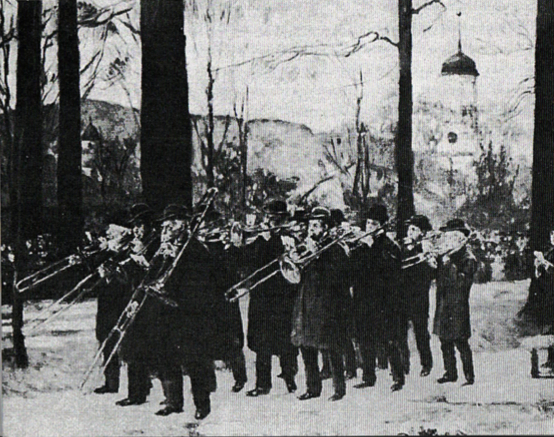
1896—Mathews and Liebling, in their Dictionary of Music, define trombone as “A very powerful instrument of the trumpet species, but much larger and with a sliding-tube” (Mathews).
1896—London, England: The Illustrated London News publishes a print by A. Forester called Rival Waits, featuring a trombonist with aggressive technique (see below image; public domain) (Illustrated London News, Dec 19, 1896).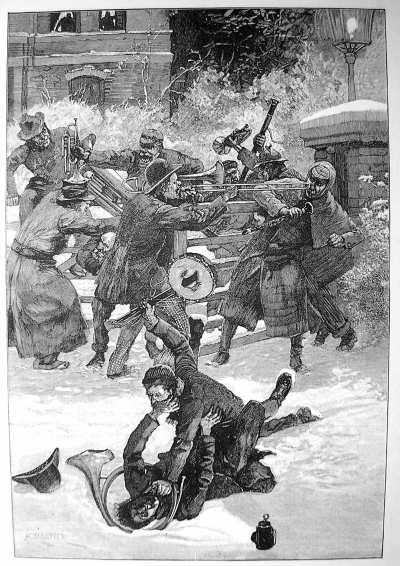
1897—Paris Conservatory morceau de concours: Paul Vidal, Solo de Concert, No. 2. One of the oldest French recital pieces that still remains available.
1898—Paris Conservatory morceau de concours: Samuel-Alexandre Rousseau, Piece Concertante.
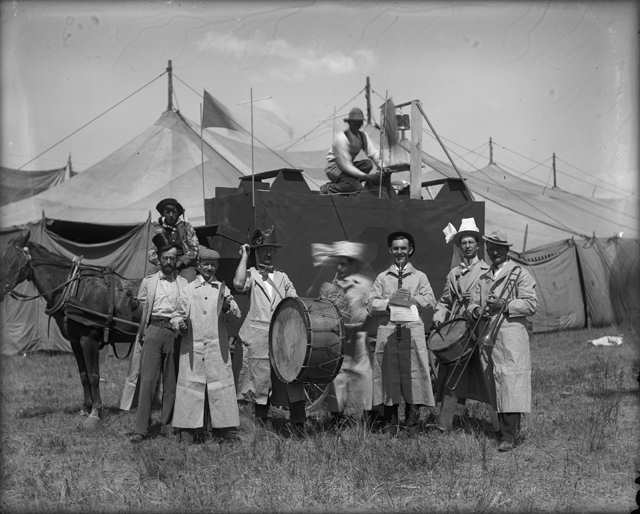 1898—Colorado Springs, Colorado: Trombone is included in a circus band for Sunflower Carnival (Western History Genealogy Department, Denver Public Library).
1898—Colorado Springs, Colorado: Trombone is included in a circus band for Sunflower Carnival (Western History Genealogy Department, Denver Public Library).
1898—Richard Strauss, Ein Heldenleben.
1898—London, England: According to Mansfield, “At the funeral of that great English statesman, the Right Honourable William Ewart Gladstone, in Westminster Abbey, May 28, 1898, there were performed (we believe for the first time in England) Beethoven’s three Equali for four trombone, the trombones and drums uniting with the organ at various points during the service. The four trombone players—two altos, a tenor and a bass—were stationed in the chantry of Henry V, above the high altar. Says a writer who was present, ‘The hushed stillness which pervaded the noble fane was broken with indescribable tenderness as the sustained chord of D minor fell upon the ears of the great congregation in tones of weird simplicity and exquisite pathos.’” Mansfield mentions a specific trombone ensemble: “Their use at Mr. Gladstone’s funeral was due to the action of Mr. George Case, the alto of the London Trombone Quartet, by whom they were played on that occasion” (Mansfield).
1898—A trombonist from The King’s Own Royal Regiment (Lancaster), an infantry regiment of the line of the British Army, is shown in military regalia (see below image; public domain).
1898—New York: A poster advertising a touring “Rag Time Opera,” By the Sad Sea Waves, depicts a trombonist playing with piano. The duo, according to the caption, is “Playing ‘to beat the band!'” (see below image; public domain) (source: Library of Congress).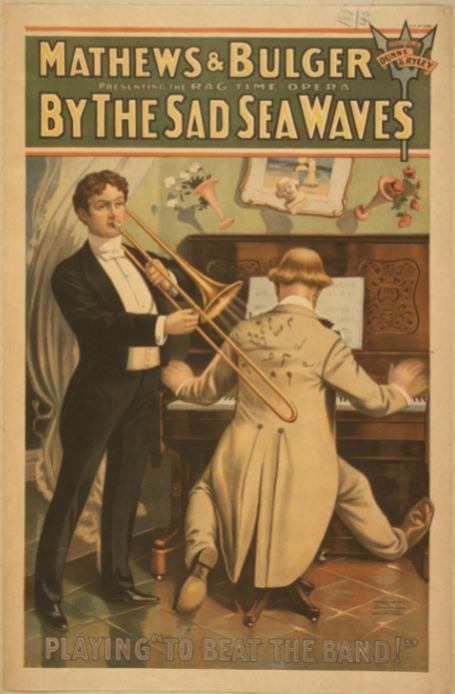
1898—A circus poster for Barnum & Bailey’s Greatest Show on Earth features an 8-member clown band, plus conductor, that includes a trombone. The advertisement, with text printed in French, is from the circus’s European tour of 1897 through 1902 (see below image; click to expand) (public domain).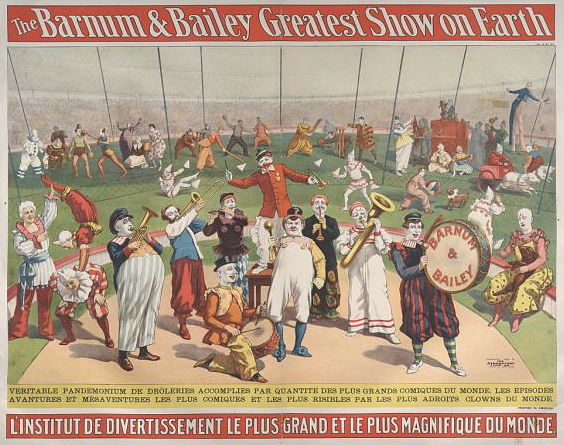
1898—Christchurch, New Zealand: A photo of the Christchurch Cycling Brass Band published in the New Zealand Wheelman includes 2 trombones (see below image; click for larger version; public domain) (supplement, May 18, 1898).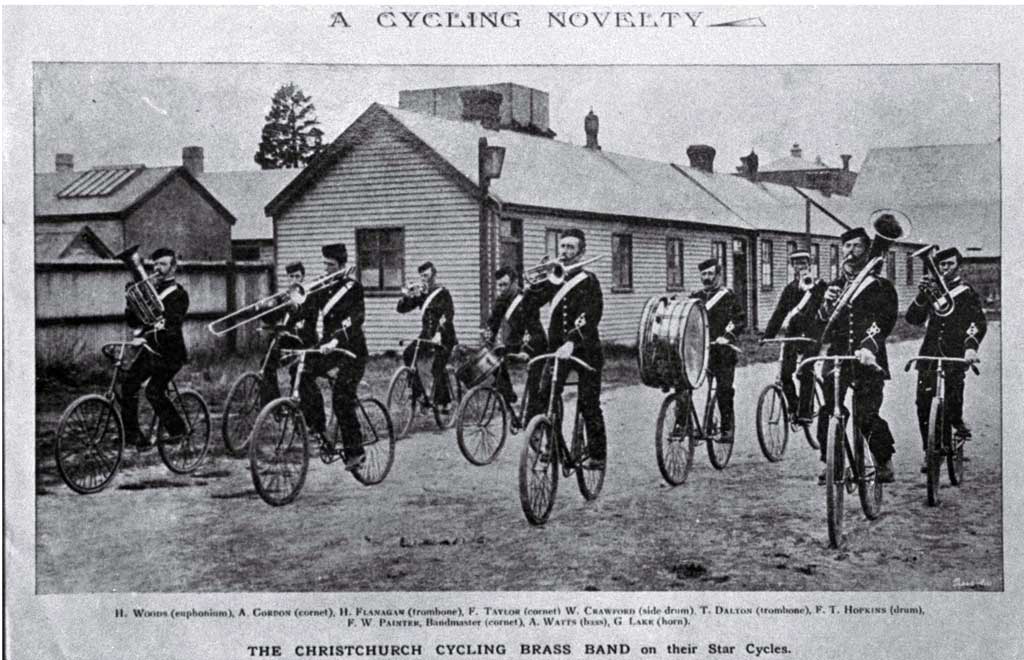
1898-1904—A French engraving from Nouveau Larousse Illustre shows many musical instruments, including a serpent, an ophicleide, a valve trombone, and a slide trombone (see below image; public domain).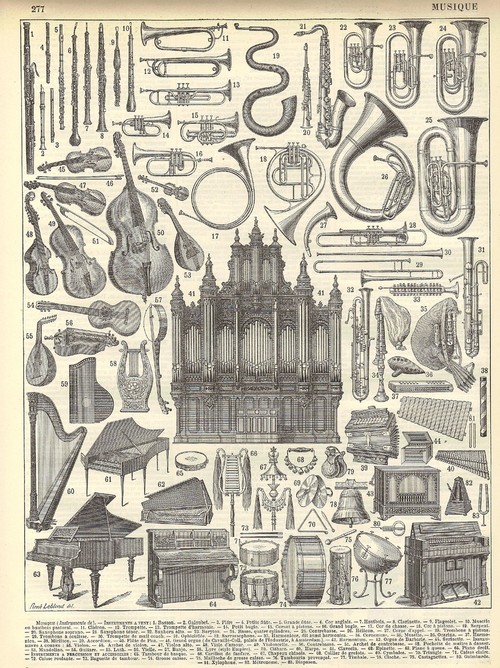
1899—Leipzig, Germany: A catalog of brass instruments for the firm of Julius Heinrich Zimmermann shows a fairly diverse offering trombones, including alto, tenor, and bass trombones in both valve and slide models (see below image; public domain) (Moeck 106).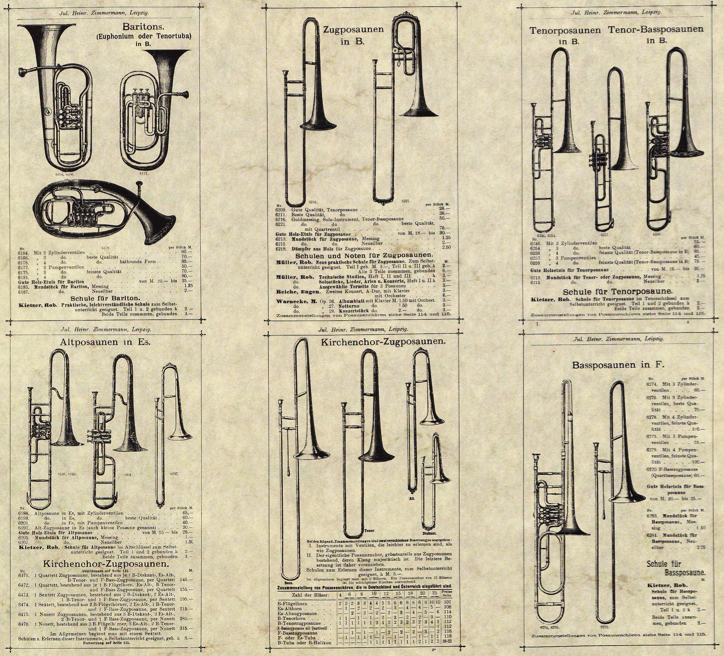
1899—Paris Conservatory morceau de concours: Georges Pfeifer, Solo.
1899—France: Camille Saint-Saëns, in his Portraits et souvenirs, reminisces about his years at the Paris Conservatory: “I loved its antiquity, the utter absence of any modern note, its atmosphere of other days. I loved that absurd court with the wailing notes of sopranos and tenors, the rattling of pianos, the blasts of trumpets and trombones, the arpeggios of clarinets…” (Fisk 142).
1899—France: Louis Anquetin (1861-1932), a respected anti-Impressionist artist, publishes a lithograph of trombonist Marguerite Dufay. Part of the “Les Maitre de L’Affiches” series, it portrays a woman categorized among comique excentrique entertainers of the popular Parisian music cafes. Marguerite Dufay is said to have performed throughout Paris at its many music halls (see below image; public domain) (Charles Hiatt, Picture Posters: A Short History, p. 113; Ervine Metzl, The Poster: Its History and Its Art, p. 50).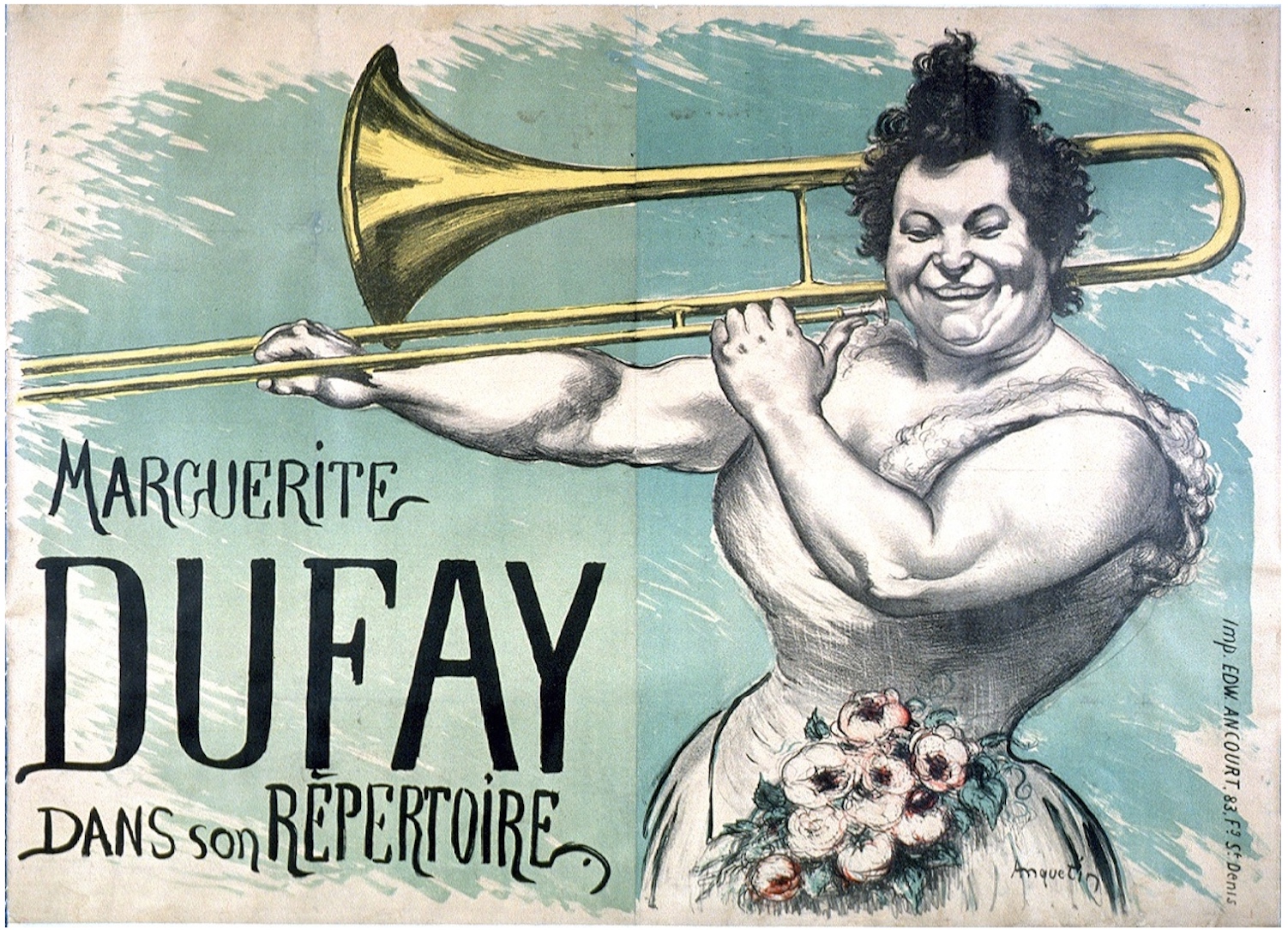
1899—Toronto, Canada: William James Henderson, in his orchestration text, says the following: “The trombone is one of the noblest of all orchestral instruments. When it sounds ignoble, it is either because its part is not well written or because it is badly played. In respect of register there are three principal kinds of trombones—alto, tenor, and bass. The alto has a compass extending from A at the bottom of the bass clef to the E flat in the top space of the treble clef…The alto trombone is in E flat….The tone of the trombone is grave and majestic, but it may be made to rage hoarsely. In all solemn or broadly dignified music trombones play a conspicuous part” (Henderson 34).
1899—New York: In a theme that can be connected to Georges Seurat’s painting of a circus trombonist in Parade de cirque (see 1888, above) and Luciano Berio’s famous Sequenza V for unaccompanied trombone, a clown is depicted playing trombone on the cover of the sheet music for the popular song, “She was Born in Old Virginia,” originally from a music supplement to the New York Journal and Advertiser (see below image; public domain) (New York Public Library Digital Gallery).
1899—New York, New York: William J. Glackens, in an illustration for Arthur Colton’s story, The Portate Ultimatum, includes a trombone among a band in a crowded street in an imaginary South American city (see below image; public domain).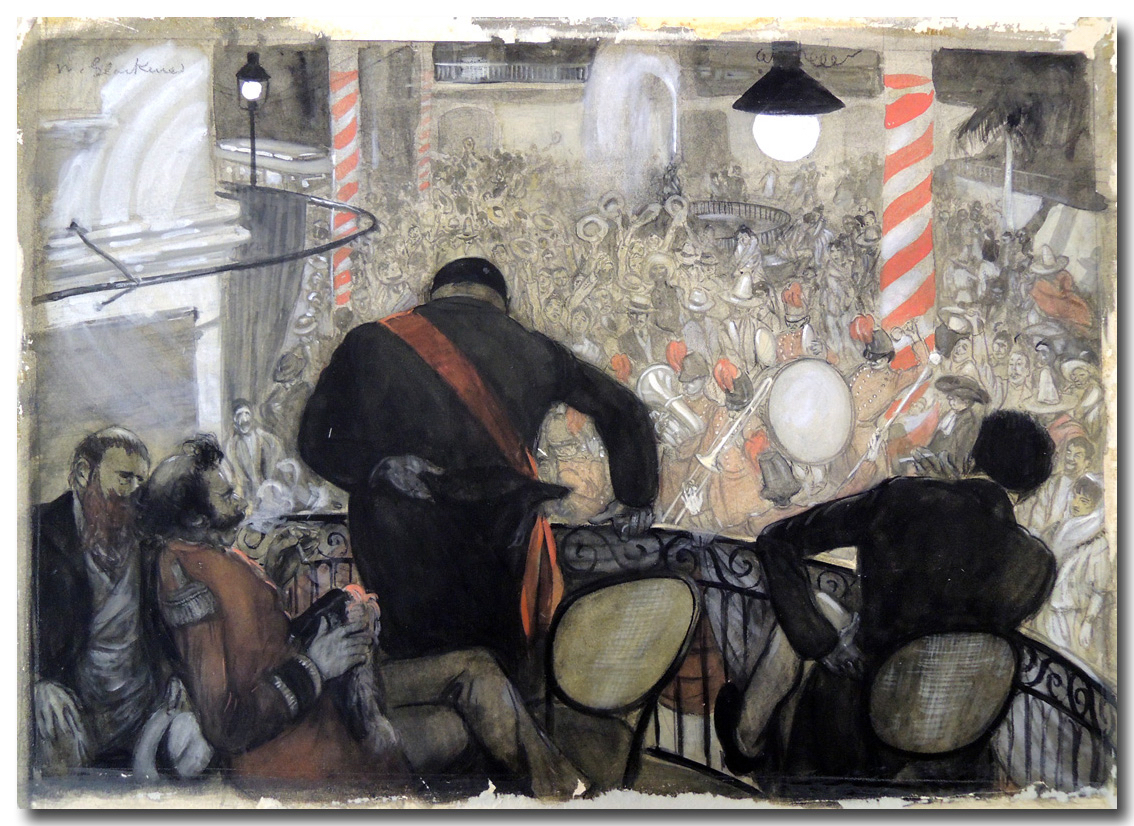
c. 1900—Russia: Eugen Reiche, Concerto No. 1. Reiche, a German trombonist who immigrates to Russia, plays with the St. Petersburg Opera and becomes trombone professor at the St. Petersburg Conservatory.
c. 1900—Zittau, Germany: Four firefighters play cards around a small table while four trombones are carefully balanced in front of them (see below image; public domain).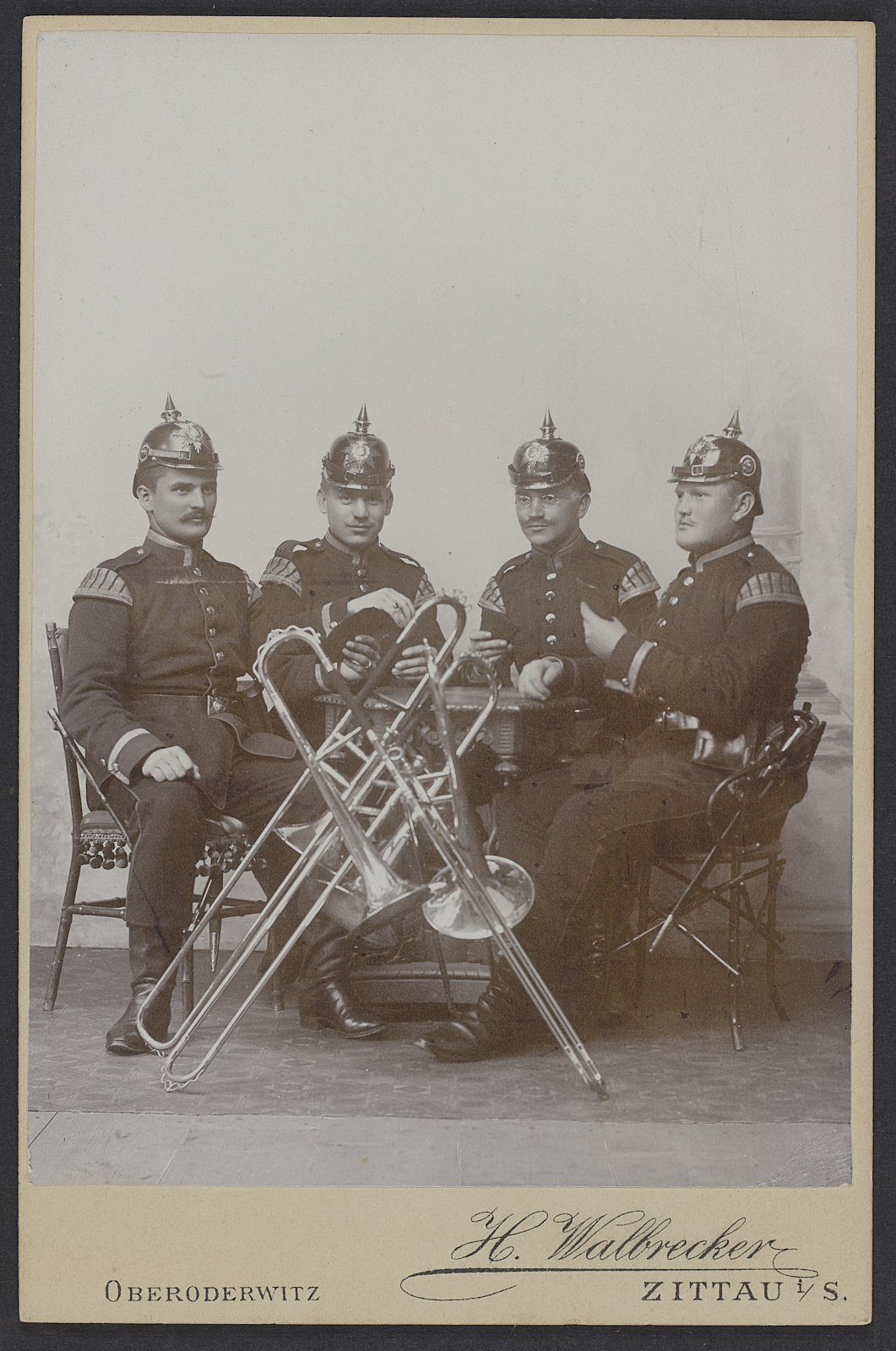
c. 1900—A carnival band dressed as women in folk costumes includes multiple trombones (see below image; public domain).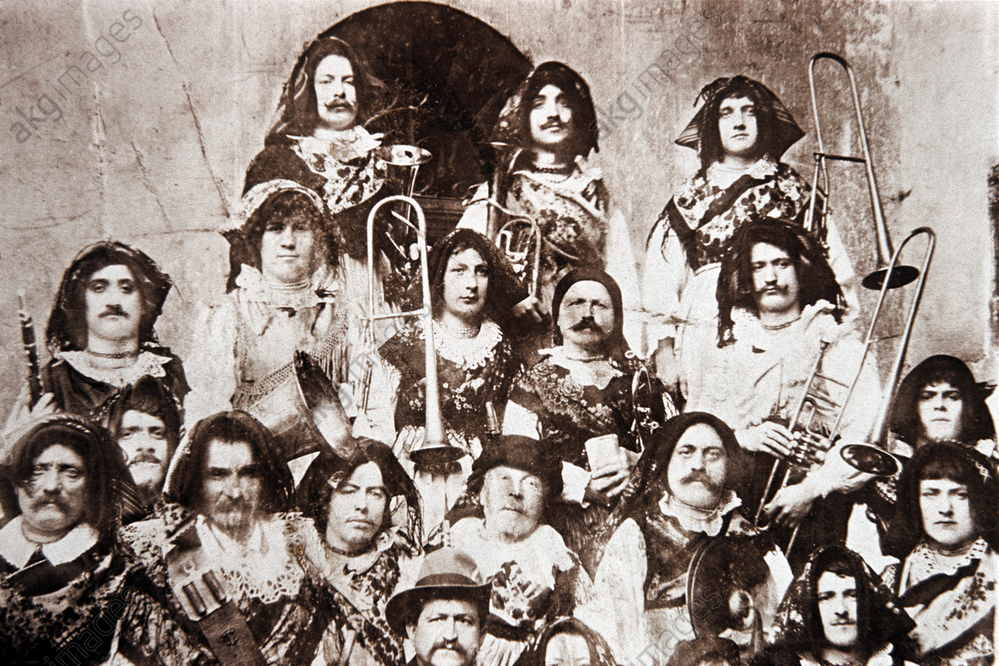
c. 1900—Emaus, Pennsylvania: A photograph of the Trombone Choir of the Moravian Church in Emaus, Pennsylvania is published (see below image; public domain).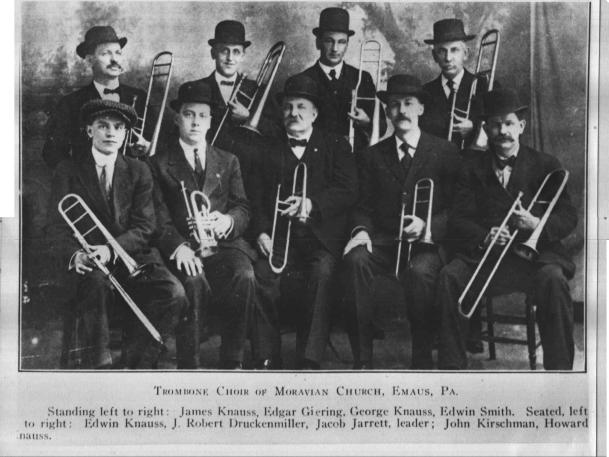
c. 1900—Germany: Wilhelm Carl August Zimmer depicts a German village band that includes a trombonist in The Orchestra, Biergarten (see below image; public domain; source: wikimedia commons).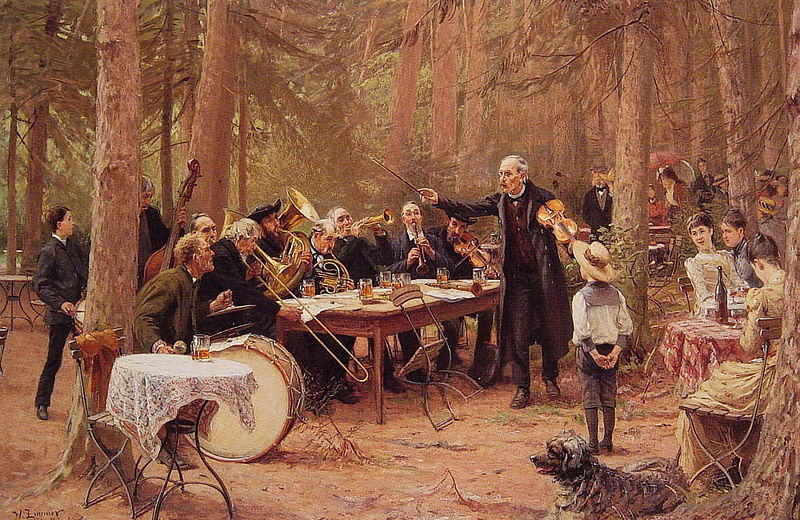
c. 1900—Austria: Trombone Player, a painting by Carl Siegfried Stoitzner (1866-1943), features a player who has apparently found his way to the cellar during a practice break (see below image; public domain).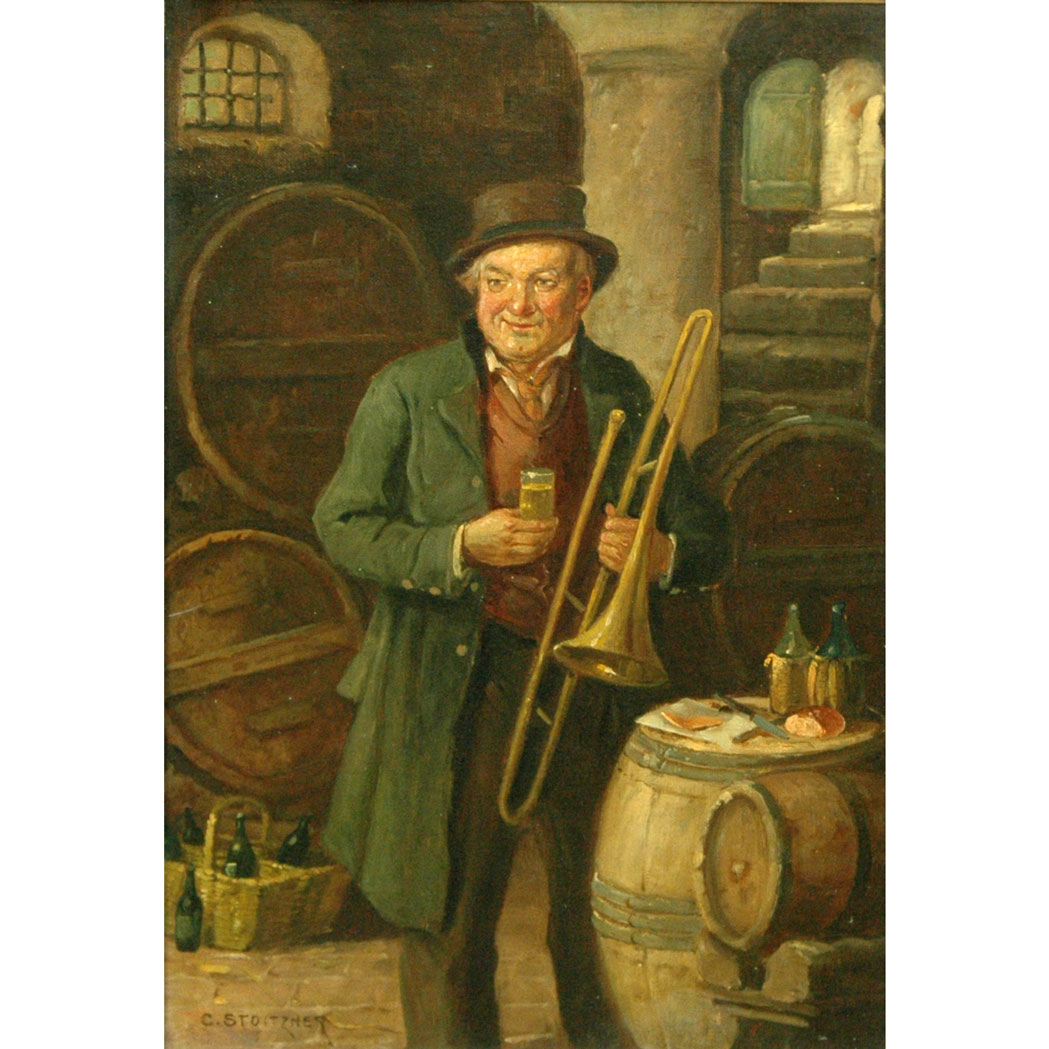
c. 1900—A photograph shows the legendary bandmaster-composer John Philip Sousa conducting a band with a trombone soloist (see below image; public domain). The photo is held by the US Library of Congress.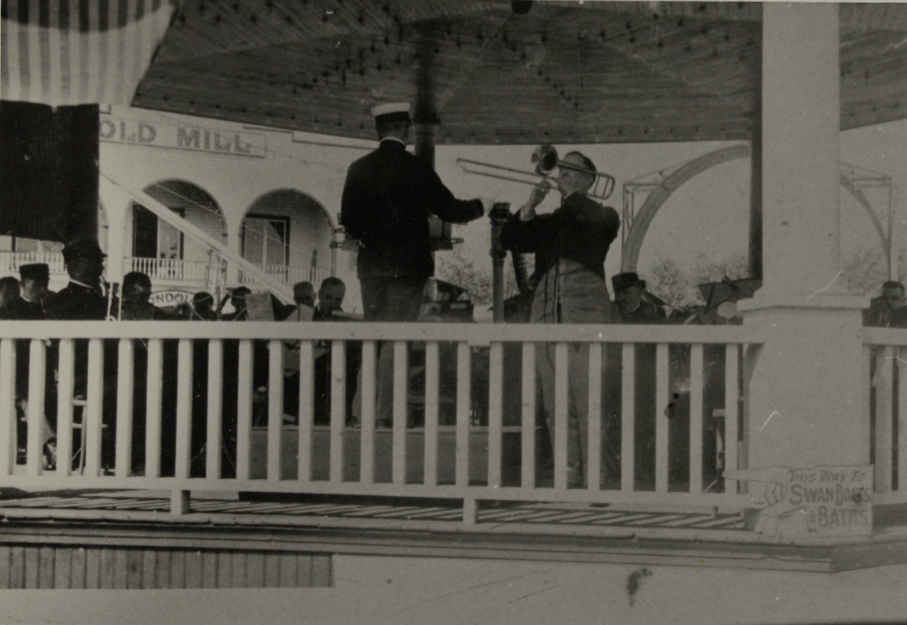
1900—Paris Conservatory morceau de concours: Pierre de la Nux, Solo de Concours
1900—The Philadelphia Orchestra, in its first season, lists the following trombonists: C. E. Gerhard, F. H. Hartmann, and Paul P. Lotz (Kupfurberg 219).
1900—An image by Cederström (probably Ture Nikolaus Cederström, 1843-1924) entitled Concert in the Monastery is reproduced in Elson’s 2nd volume of Famous Composers and their Works. Among the 8 monk-musicians is a trombonist (see below image; click to expand; public domain) (Elson, Famous Composers vol. 2, 15).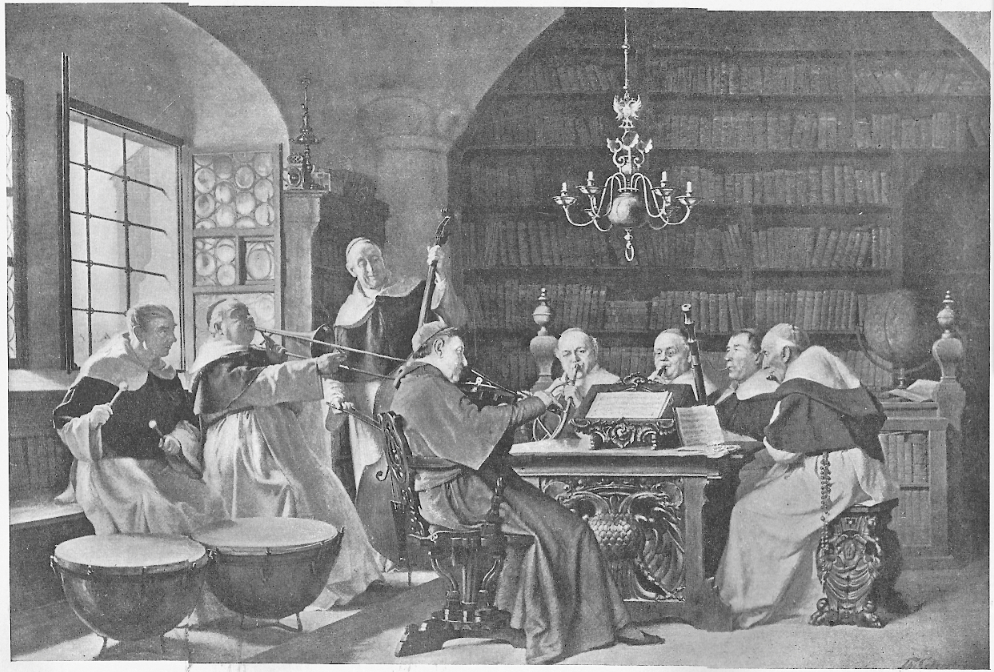
Late 1800s—Italy: A tenor trombone with an extravagant dragon head for a bell is manufactured in Italy. It is currently held in the Metropolitan Museum of Art (Rueger 146).
Late 1800s—France: A painting by an unknown artist depicts a young girl playing trombone with what appears to be a circus troupe (see below image; public domain) (Heckscher Museum of Art).